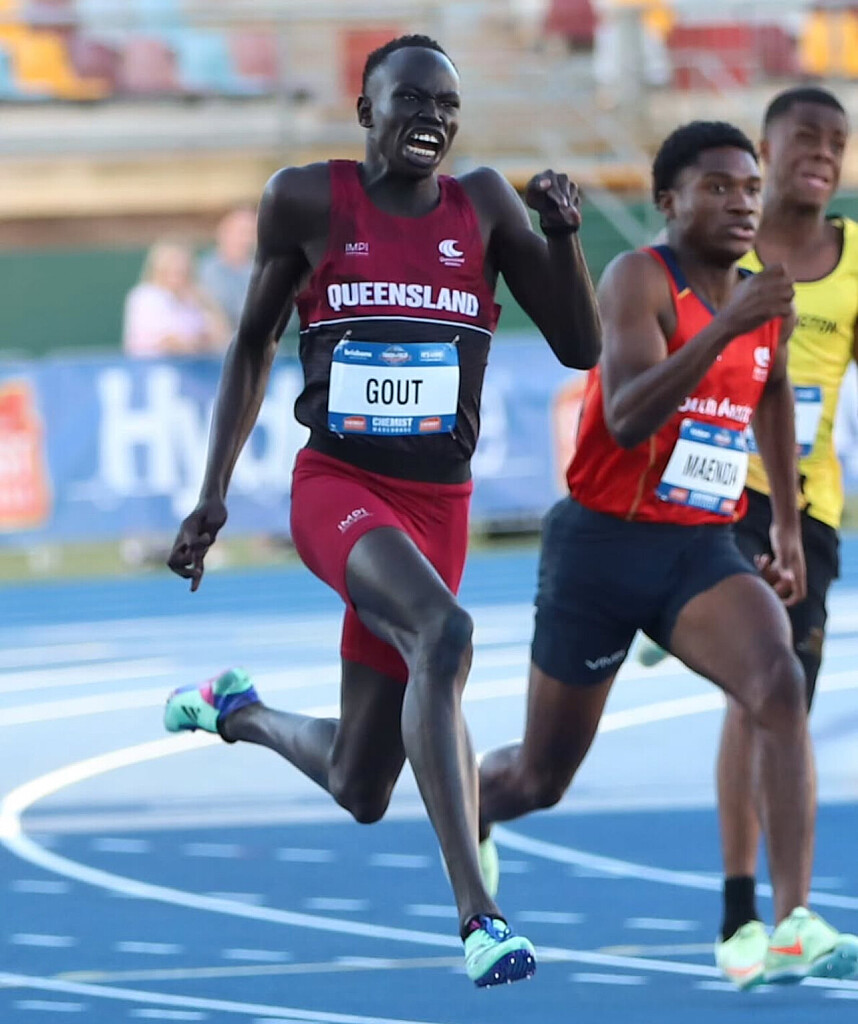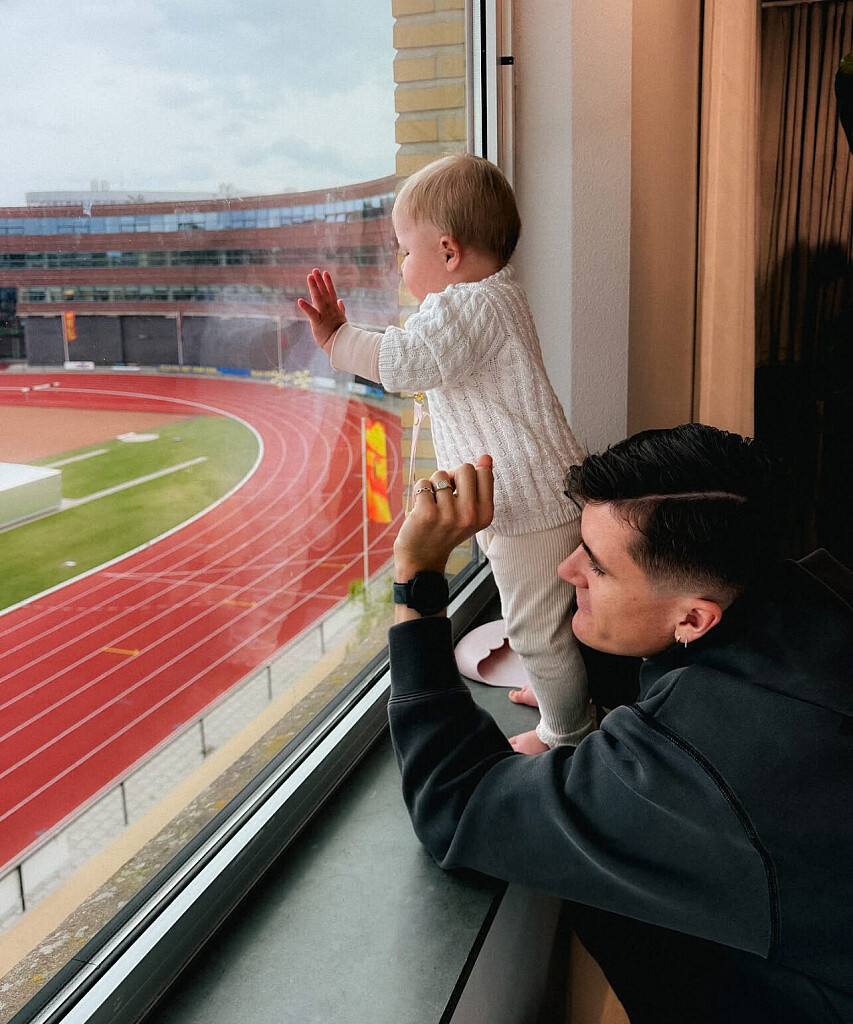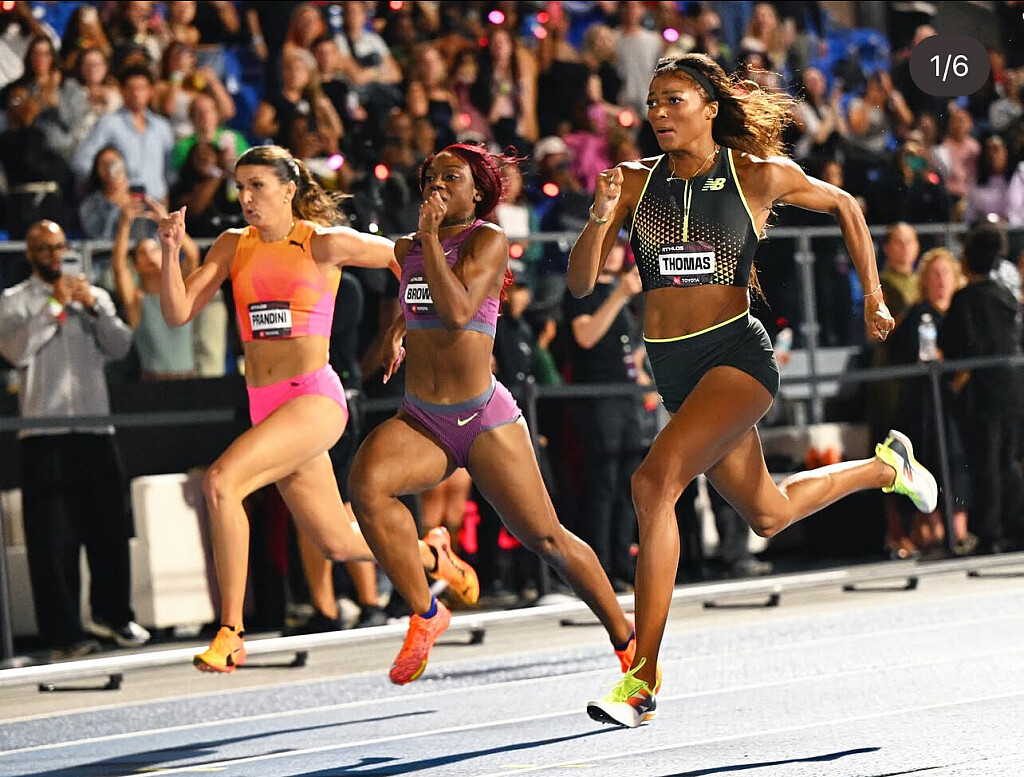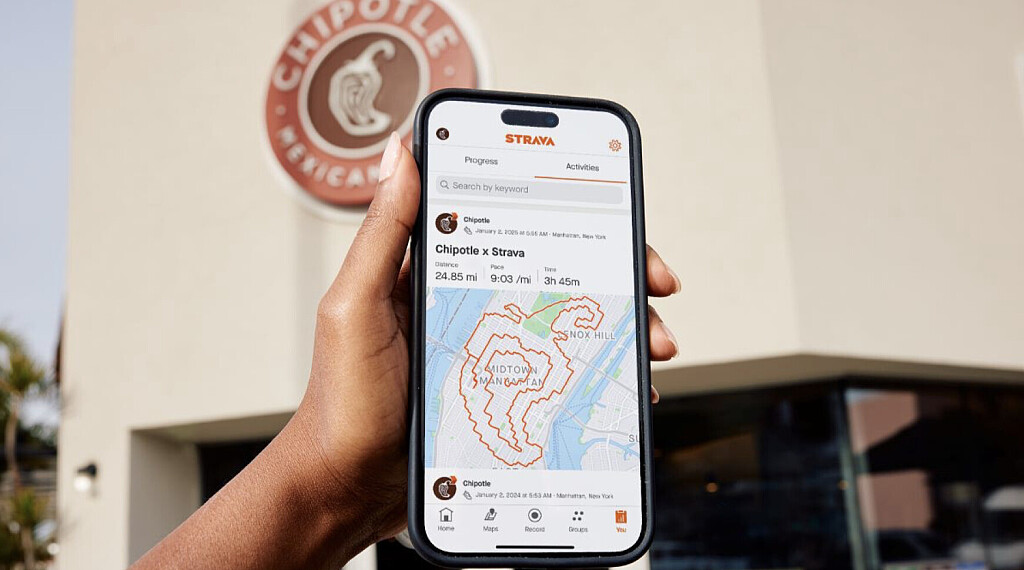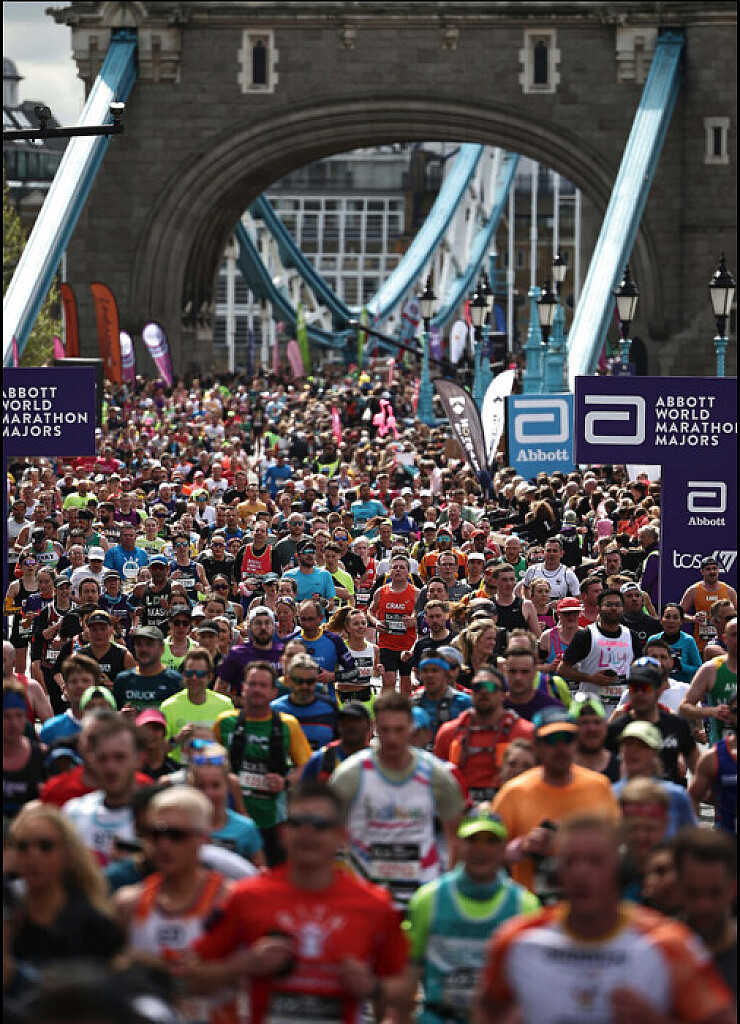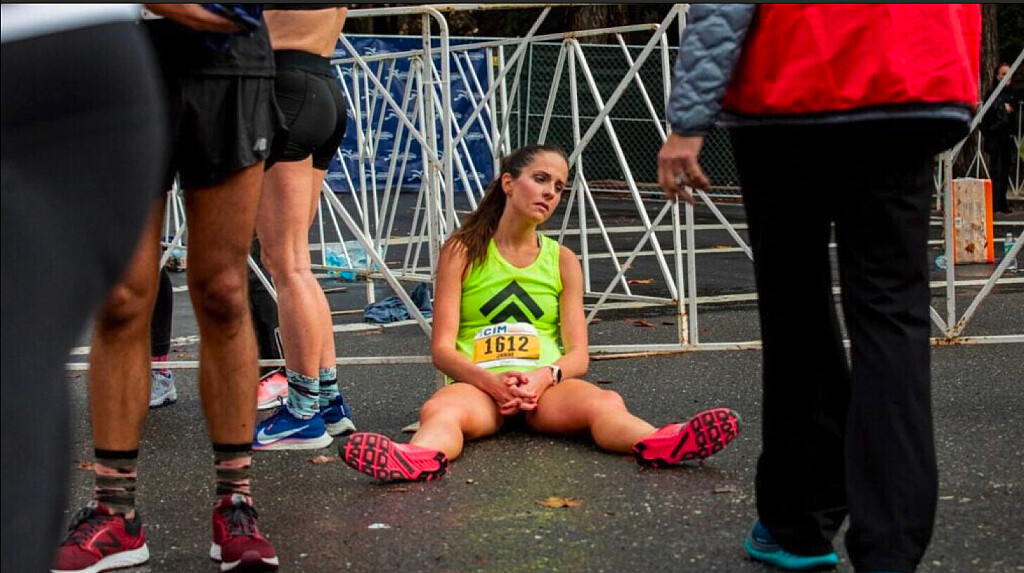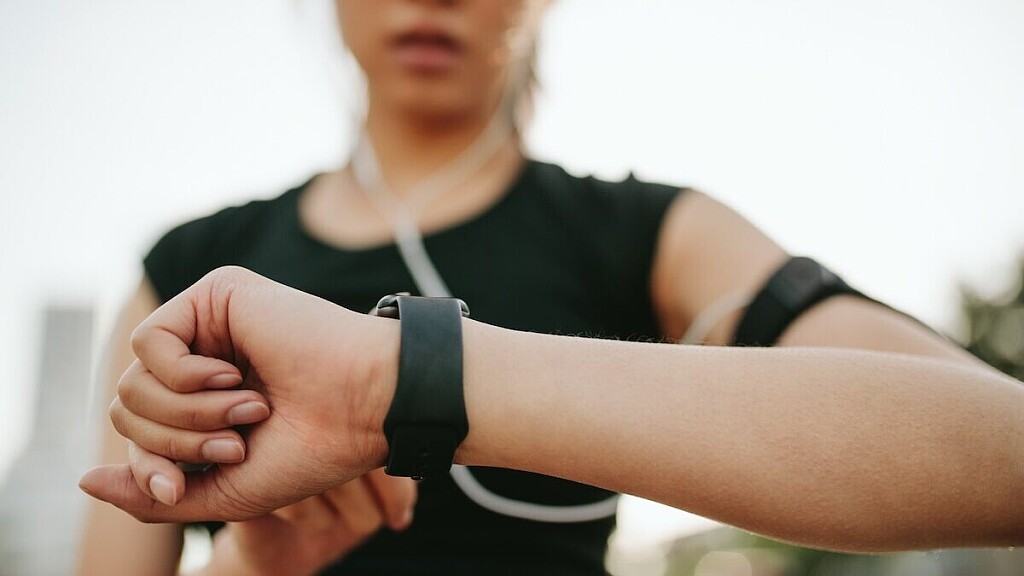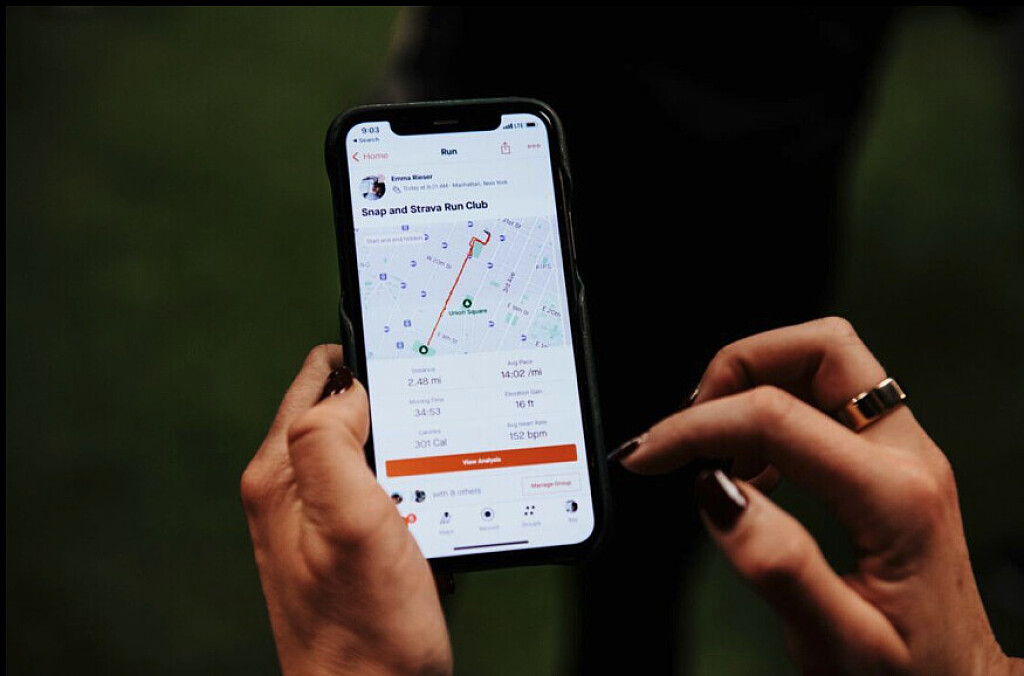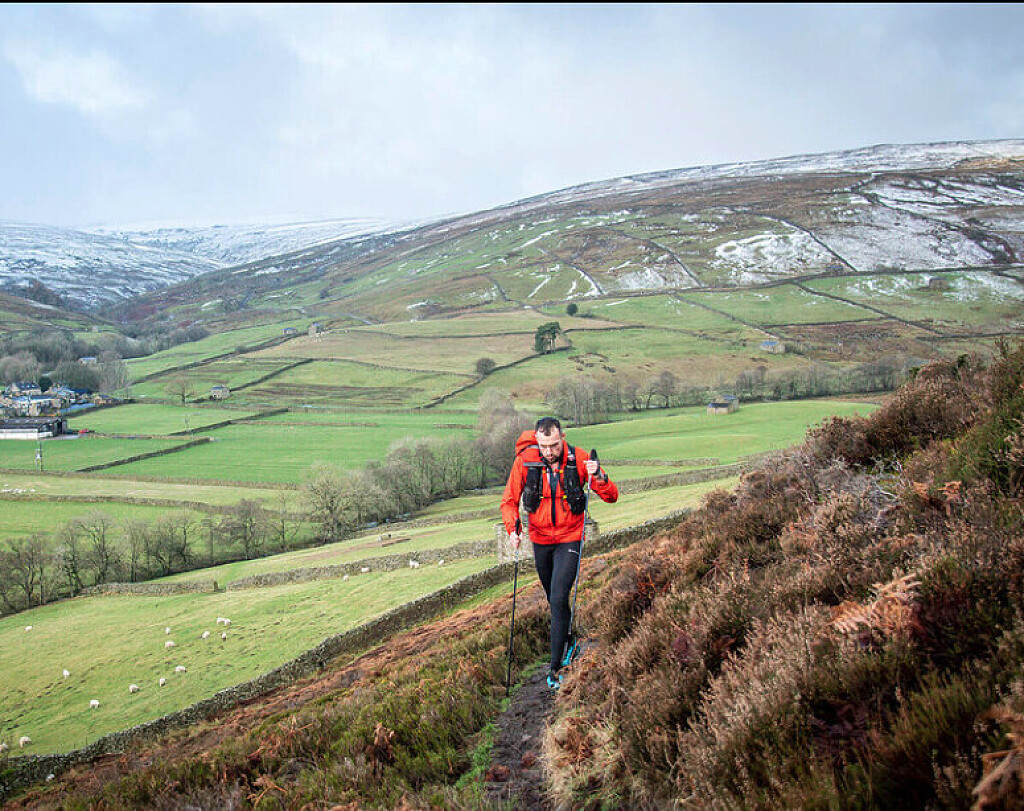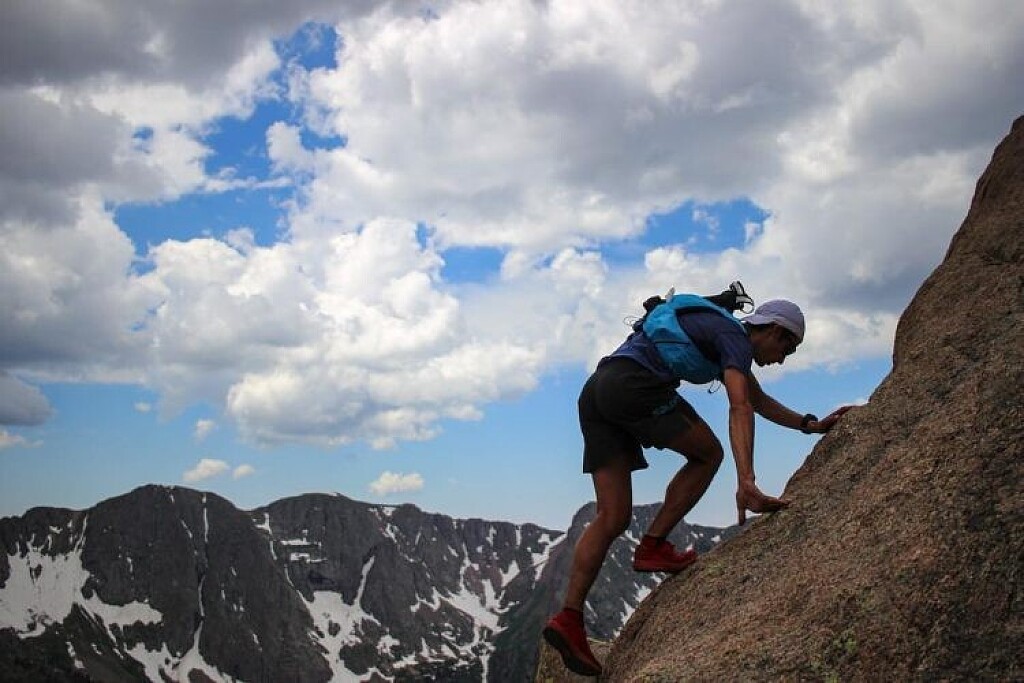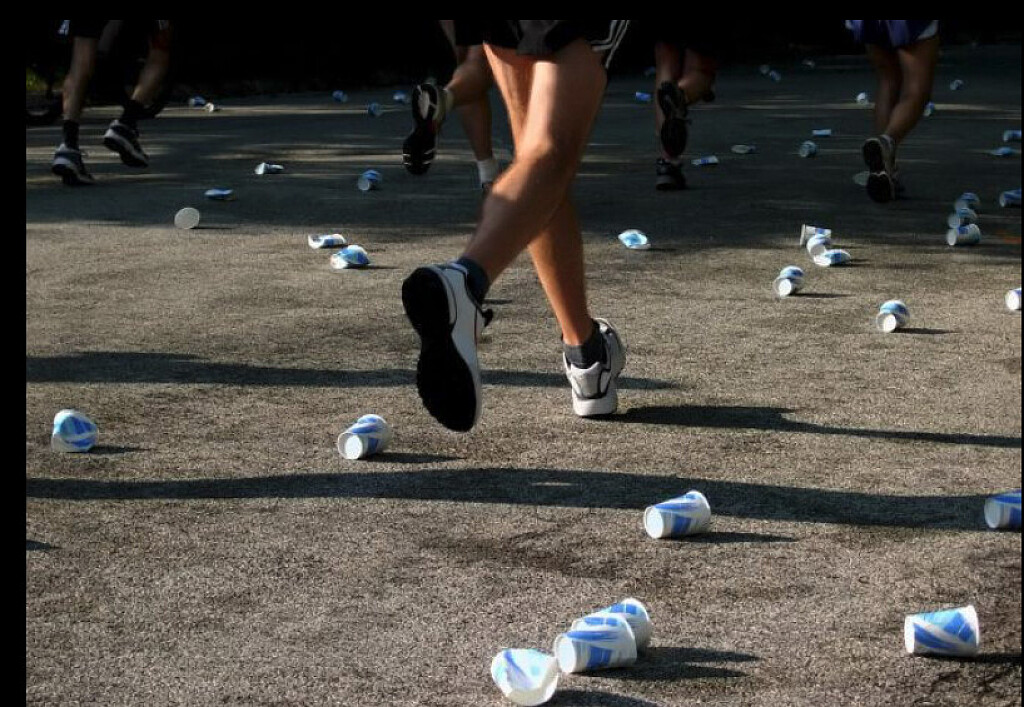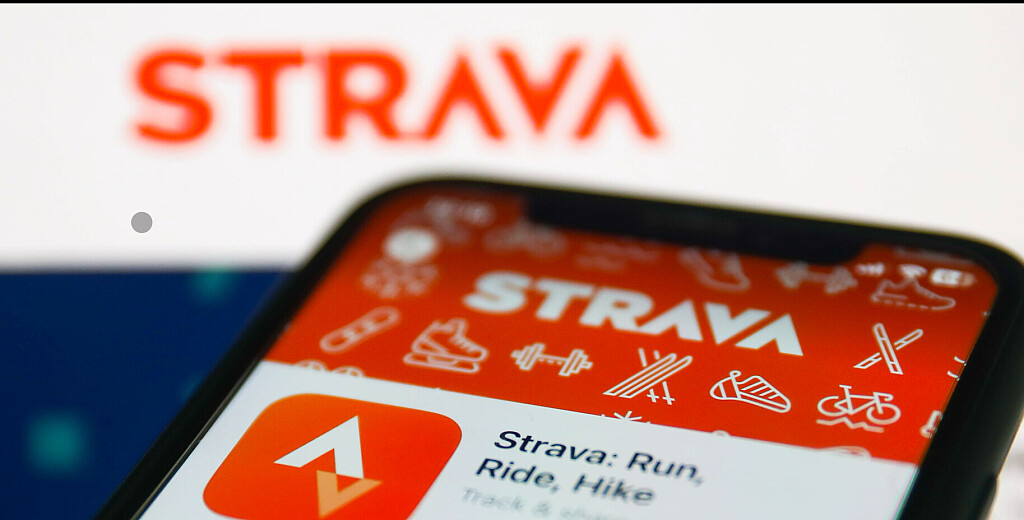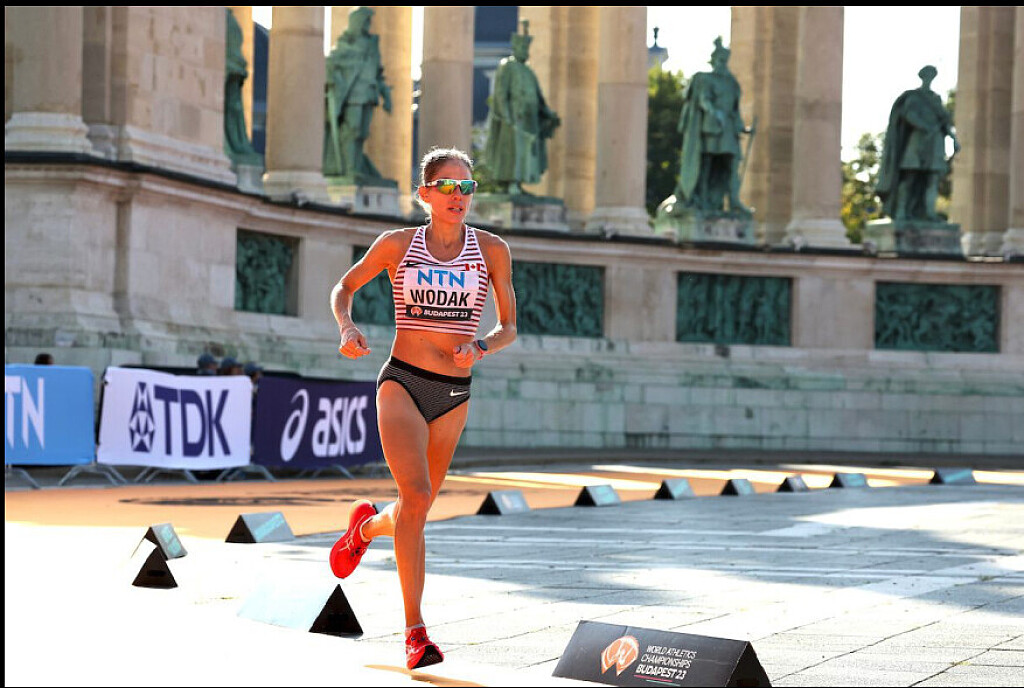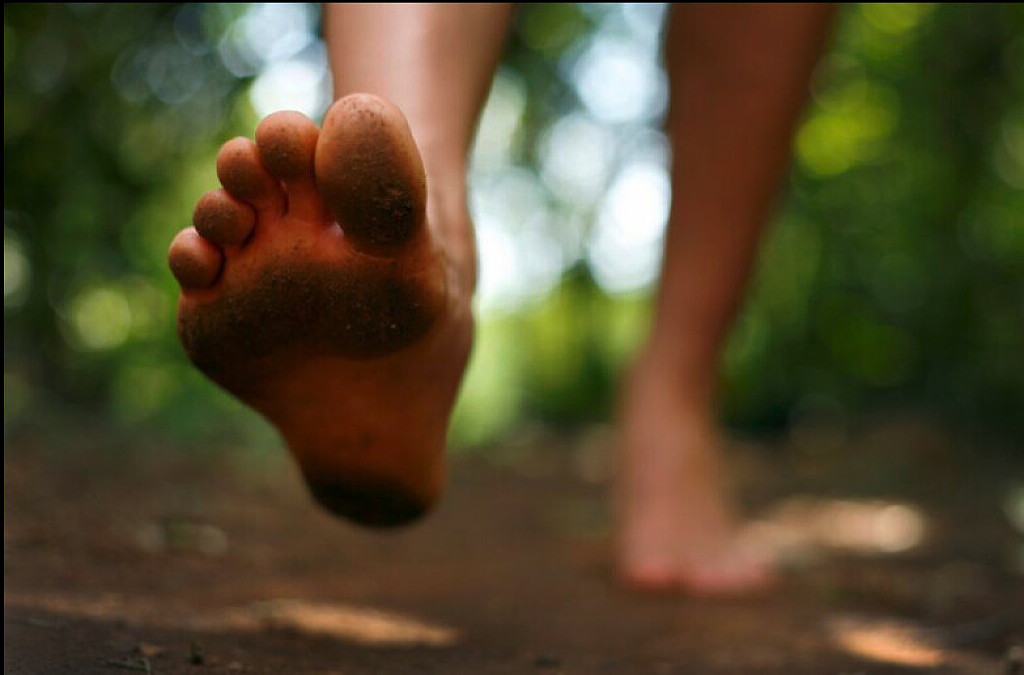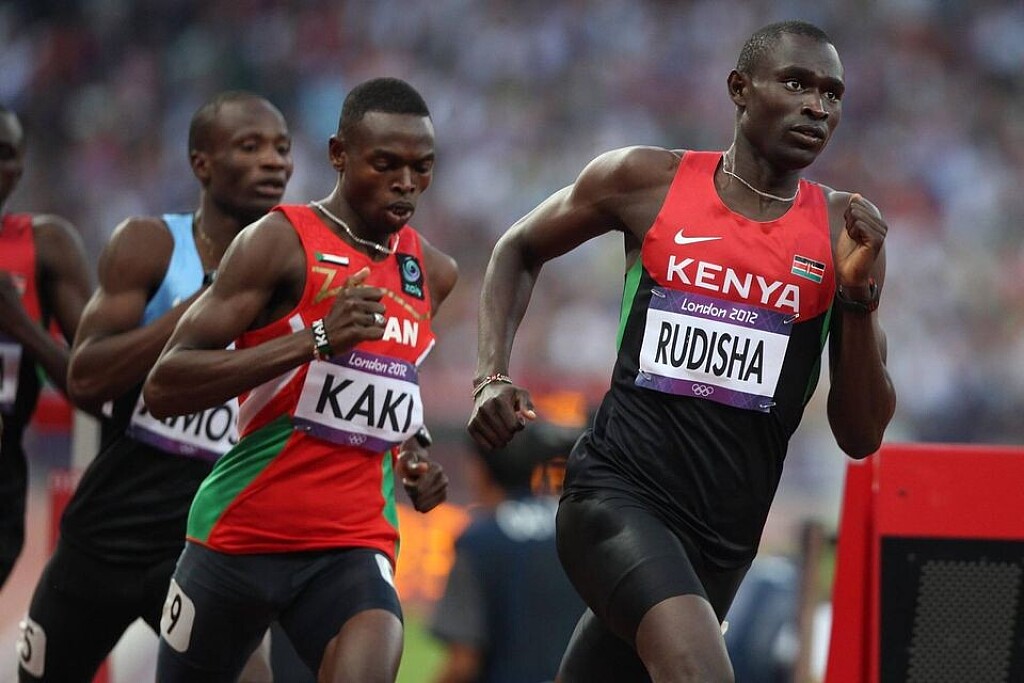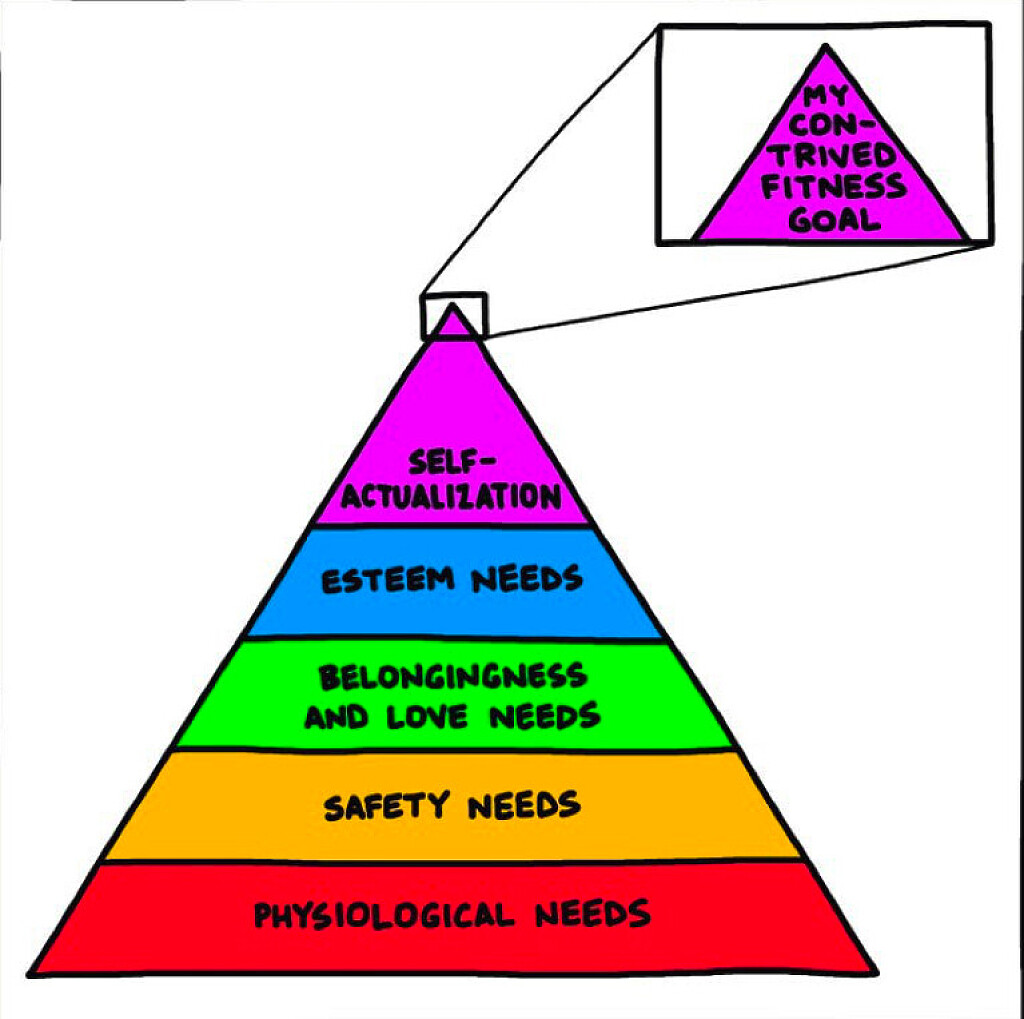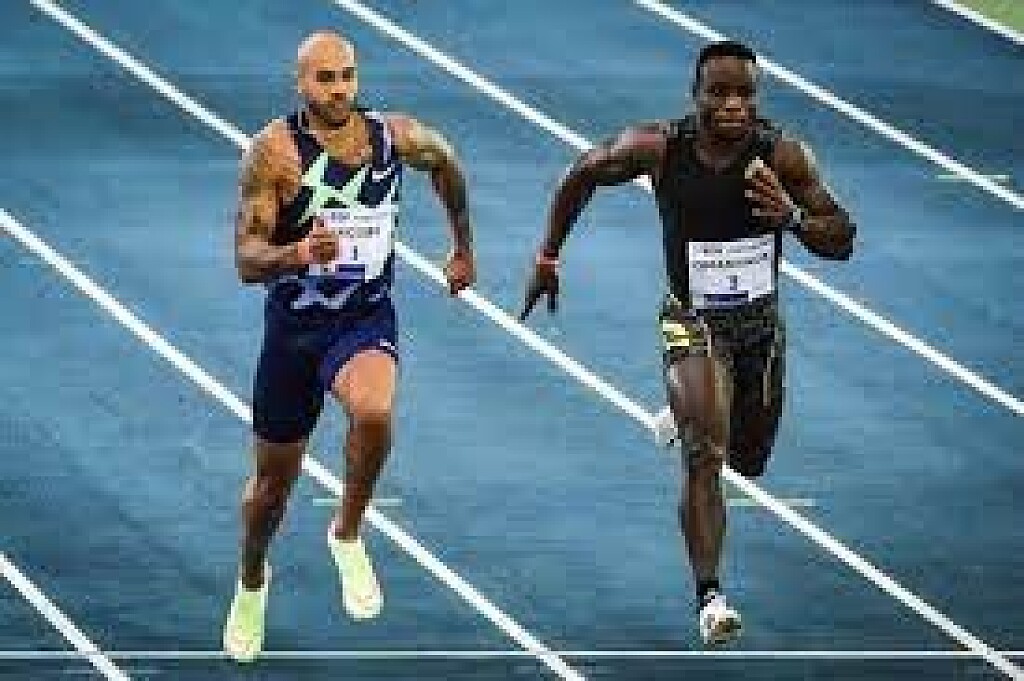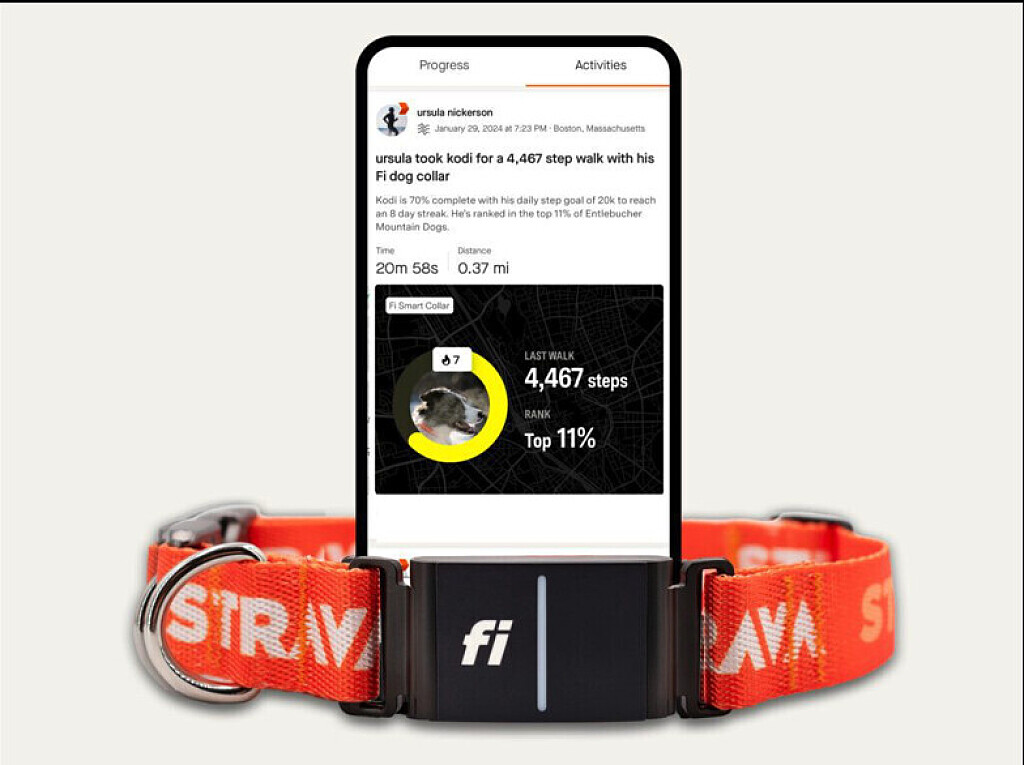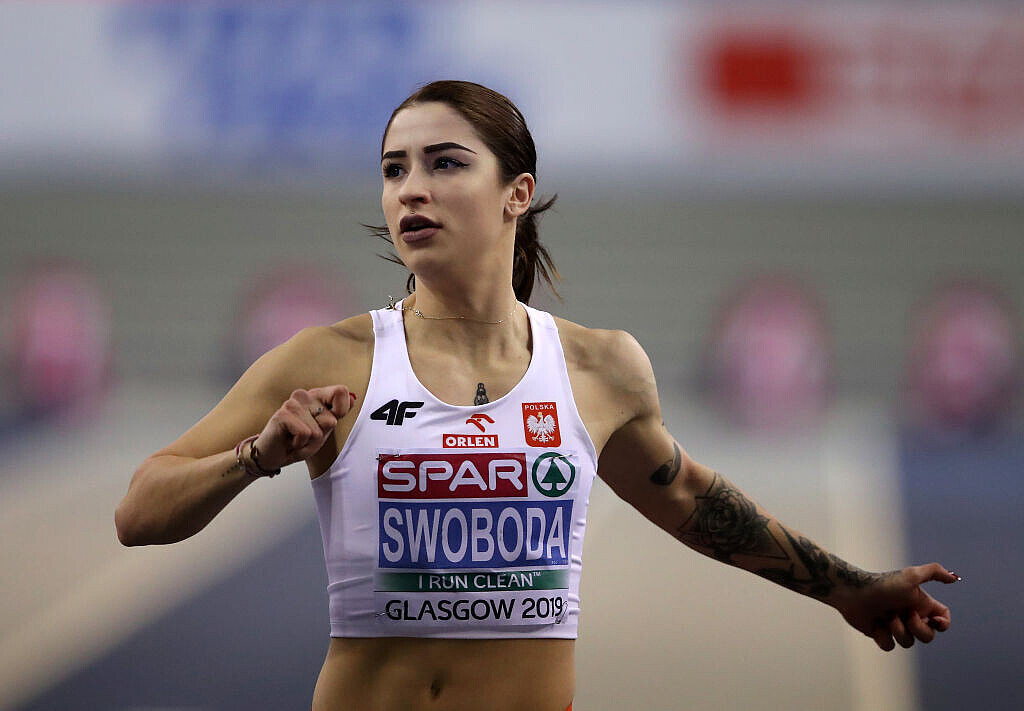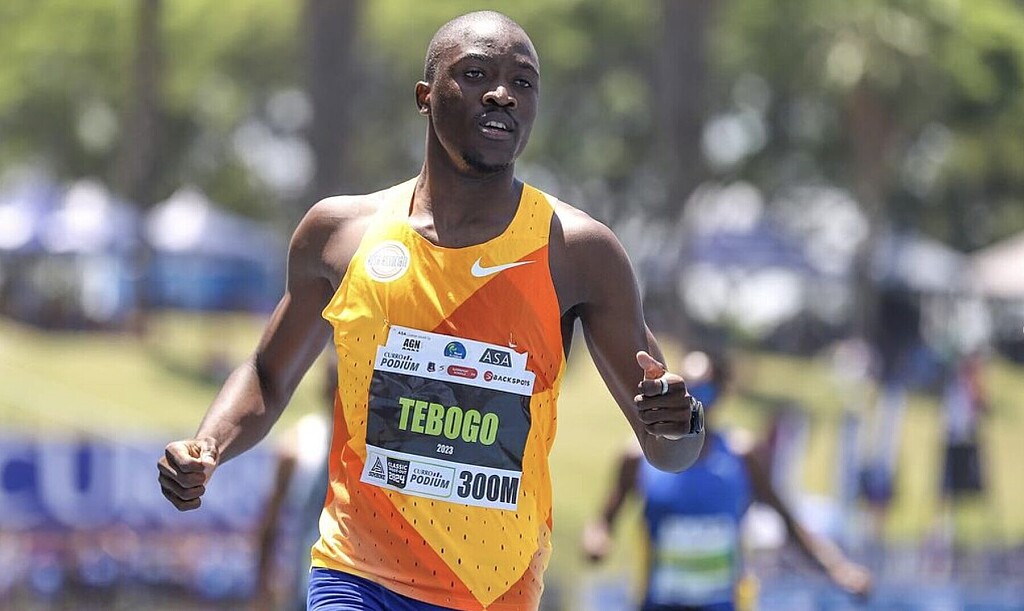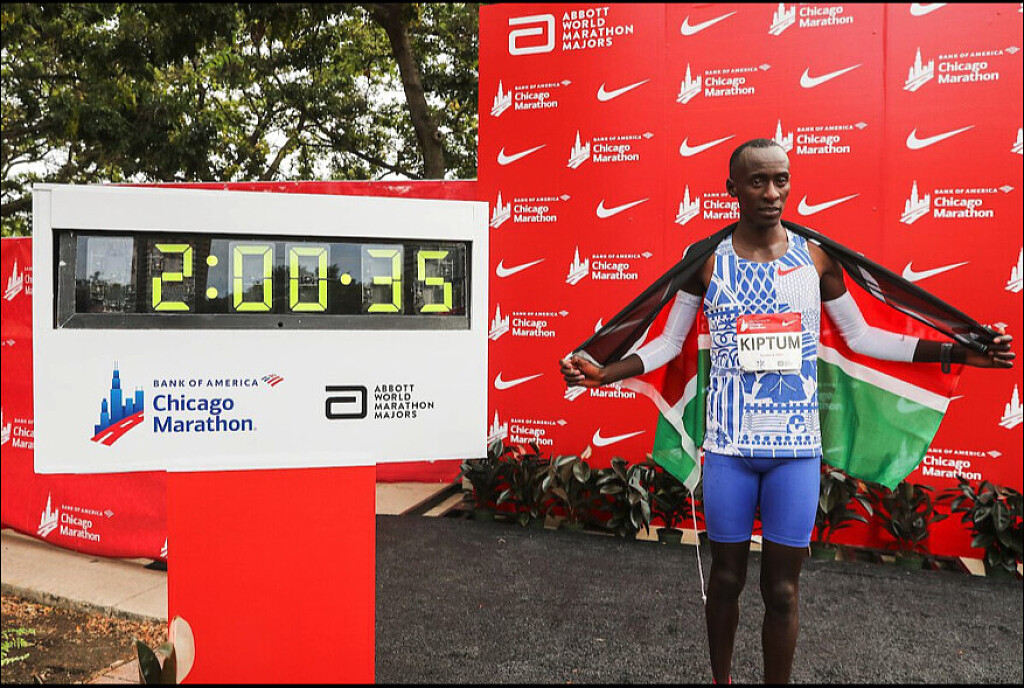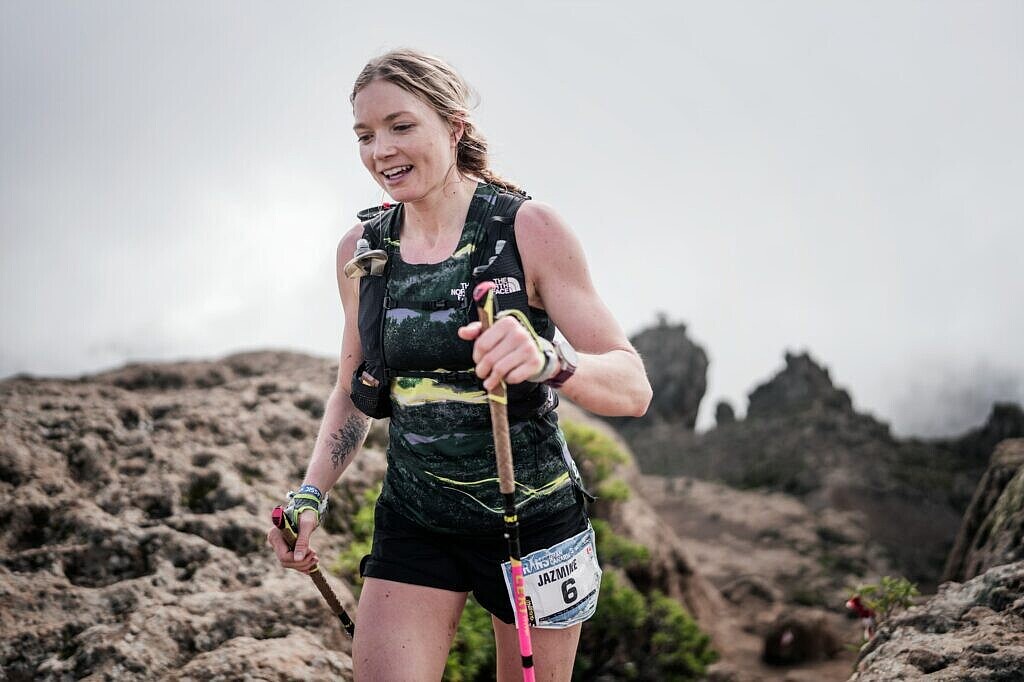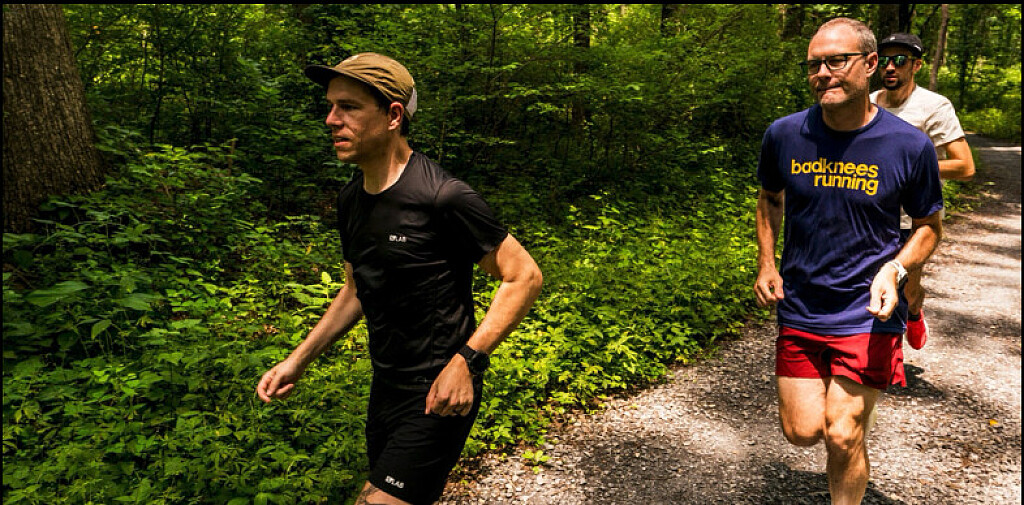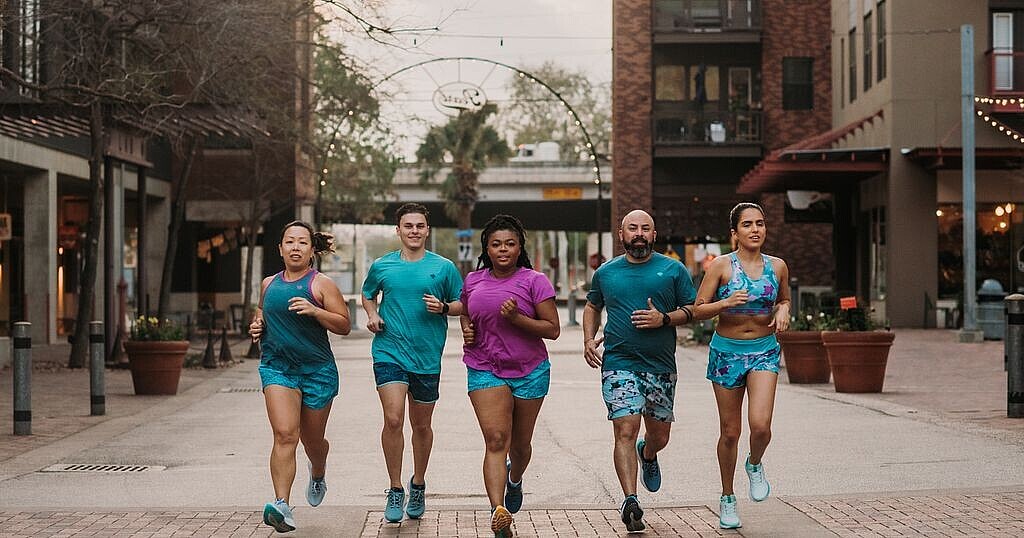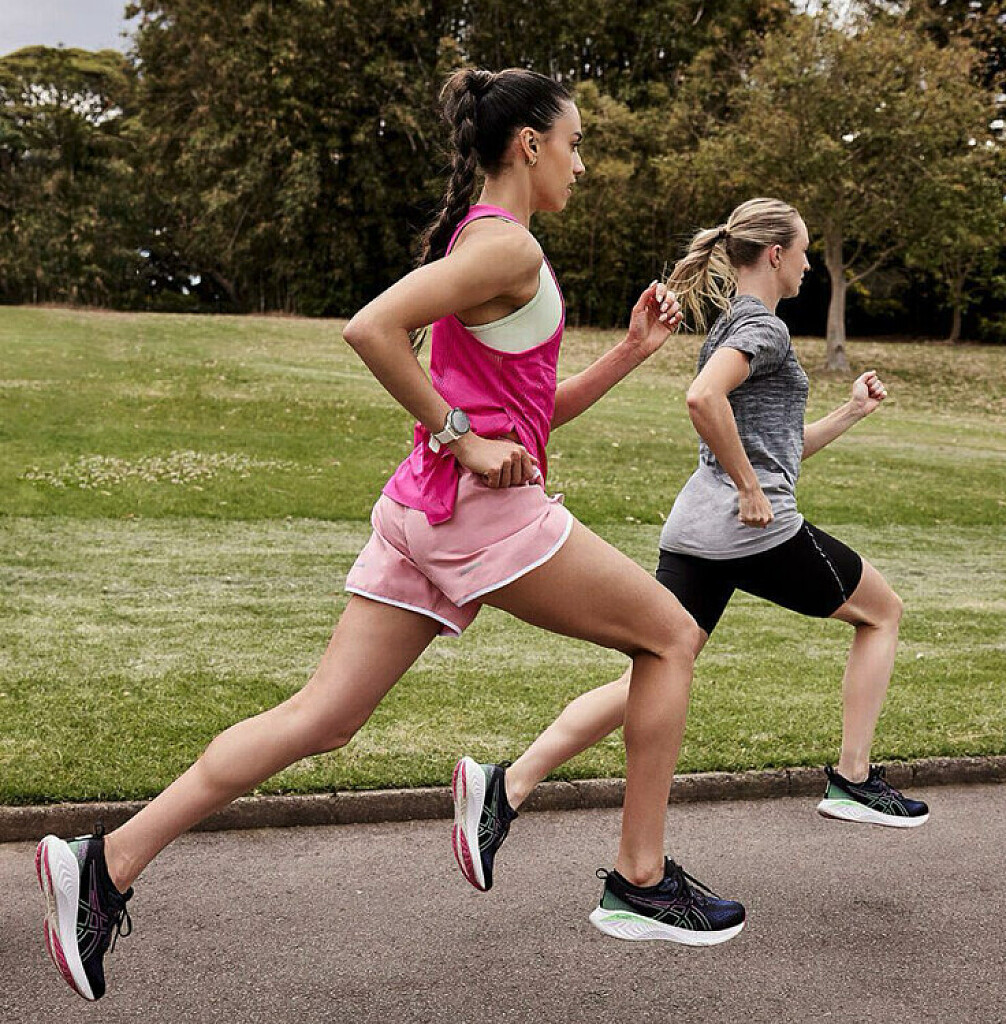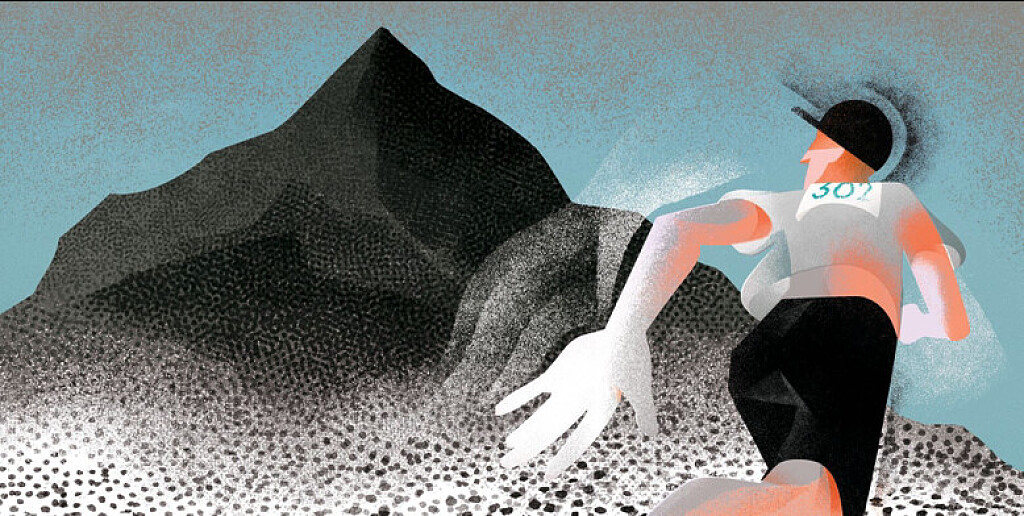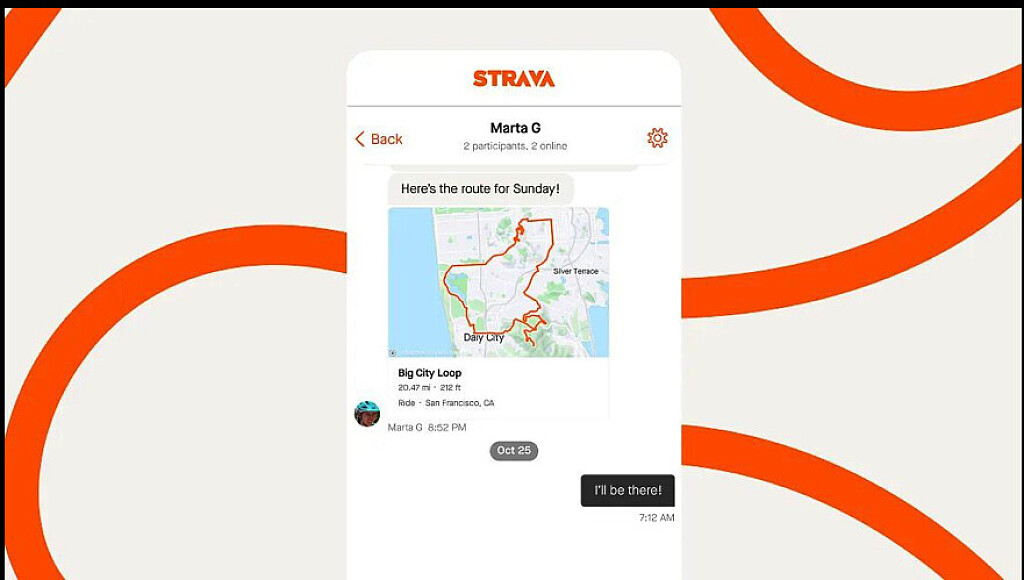Running News Daily
Running News Daily is edited by Bob Anderson. Send your news items to bob@mybestruns.com Advertising opportunities available. Train the Kenyan Way at KATA Kenya and Portugal owned and operated by Bob Anderson. Be sure to catch our movie A Long Run the movie KATA Running Camps and KATA Potato Farms - 31 now open in Kenya! https://kata.ke/
Index to Daily Posts · Sign Up For Updates · Run The World Feed
Articles tagged #Strava
Today's Running News
Strava Removes 4.45 Million Activities to Restore Integrity to Running Leaderboards
Strava just took a giant leap to restore trust in its running segment leaderboards—over 4.45 million activities have been purged from the platform.
Why such a massive cleanup? Many of those entries were either mislabeled as runs when they weren’t, or recorded while the user was riding in a car. For runners chasing KOMs (King of the Mountain) and segment PRs, this move is long overdue.
The platform’s goal is simple: ensure that leaderboard rankings reflect genuine human effort, not accidental car rides or mislogged workouts.
Earlier this year, Strava introduced a new machine learning system designed to catch these errors. It analyzes 57 variables—including speed, acceleration, and GPS patterns—to detect anomalies. Since launching in February, the system has led to a 72% drop in user-reported “vehicle” runs.
For runners who’ve trained hard and earned their spot on the board, this is a welcome correction. And for those who’ve lost segment crowns to impossible paces, justice has finally arrived.
Strava isn’t just removing suspicious data—it’s giving runners control. The system allows users to fix flagged runs by marking them private or deleting them entirely.
But that’s not all. Strava is continuing to enhance the experience for runners:
• AI-powered route suggestions tailored to your training goals
• Points of interest like restrooms and water fountains embedded into routes
• Seamless point-to-point navigation for longer or exploratory runs
Strava has also expanded its platform by acquiring The Breakaway, a performance-focused training app, signaling even more tools may soon be available for serious and recreational runners alike.
Bottom line: Strava’s leaderboards are becoming cleaner, smarter, and more accurate—which means segment records now reflect what they were meant to: real running.
by Boris Baron
Login to leave a comment
Australia’s teenage sprint sensation, Gout Gout, is gearing up for his biggest stage yet — the 2026 Commonwealth Games in Glasgow.
At just 17 years old, Gout Gout has already rewritten the record books. The Queensland-based sprinter, born in December 2007 to South Sudanese parents, is widely regarded as one of the most exciting young talents in global athletics. His rapid rise has drawn comparisons to legends like Usain Bolt — and for good reason.
Gout currently holds the Oceanian 200m record with a time of 20.02 seconds, set at the Golden Spike meet in Ostrava earlier this year. He also clocked 10.17 in the 100m to win the Australian U-18 title and later dominated the U-20 division. His combination of top-end speed, graceful stride, and fierce competitive drive has made him a must-watch on the world stage.
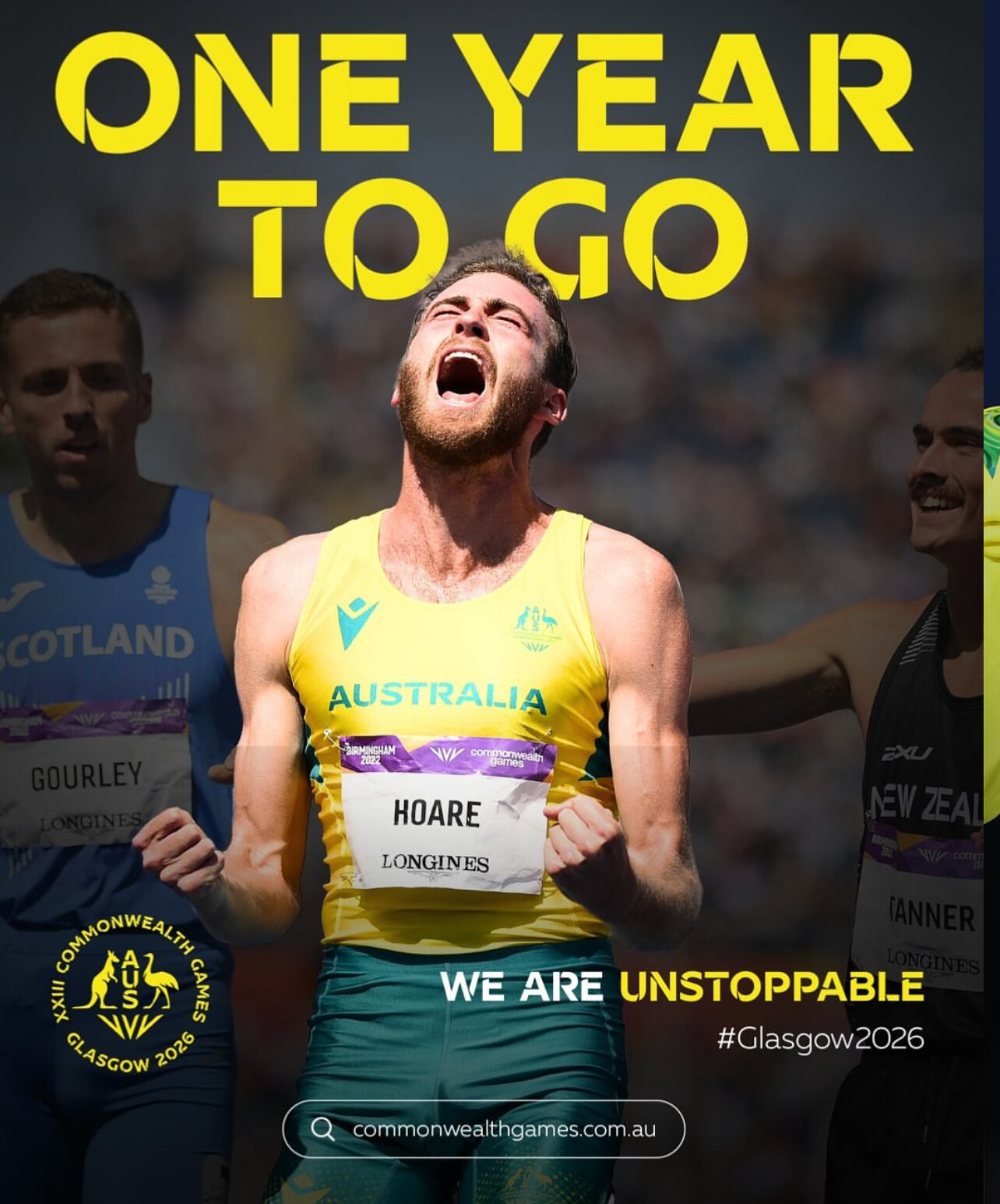
Now, the teen phenom is set to represent Australia at the 2026 Commonwealth Games, scheduled for July 23 to August 2 in Glasgow, Scotland. He is expected to compete in the 100m, while his entry in the 200m remains under consideration due to scheduling conflicts with the World Junior Championships, which will take place shortly after in Eugene, Oregon.
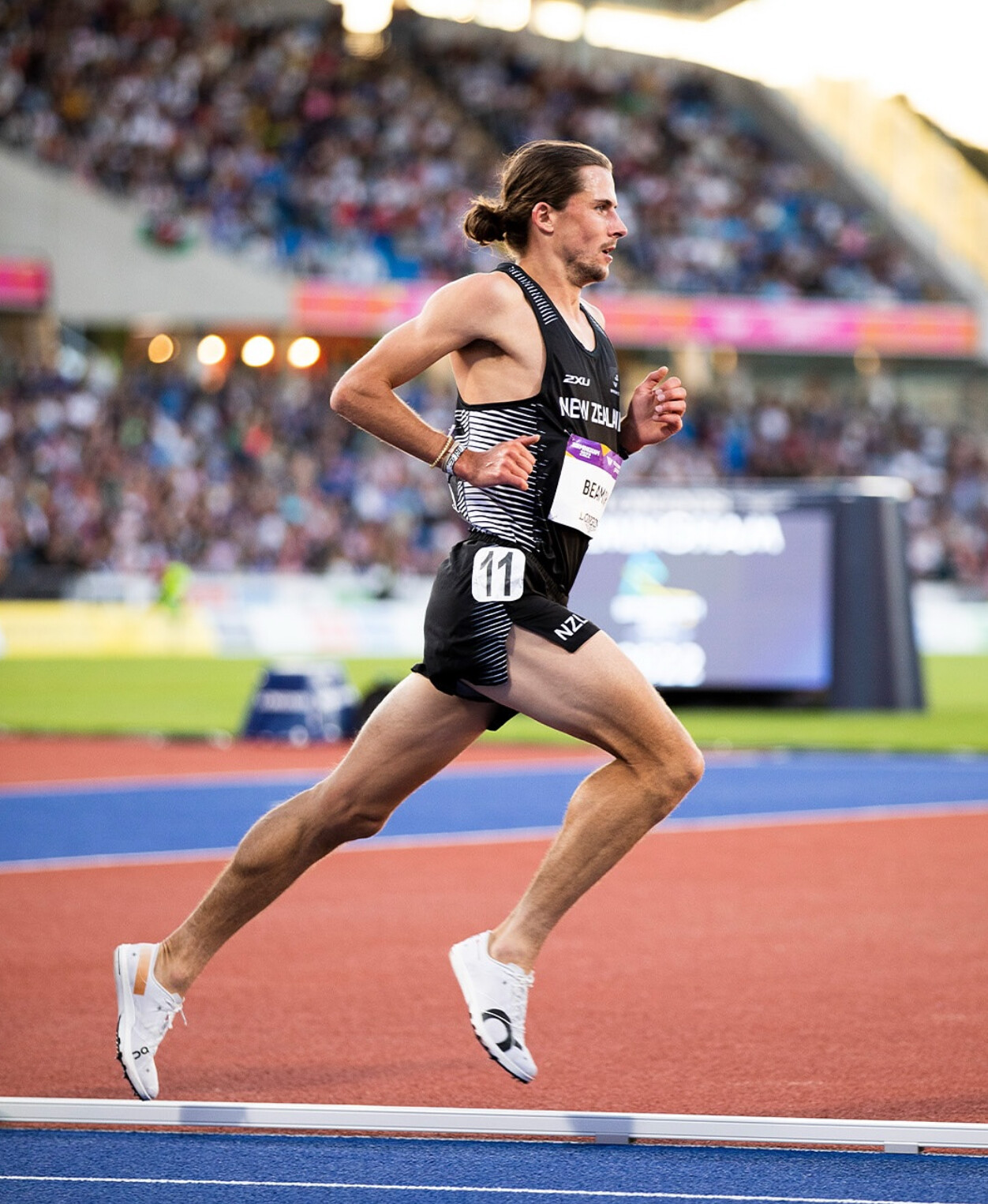
Gout’s Path to Stardom

Gout’s emergence as a global sprint force has been nothing short of remarkable. Raised in Ipswich, Queensland, he was introduced to athletics at a young age and quickly caught the attention of Australia’s elite coaches. Under the guidance of Diane Sheppard, Gout has developed into a technically polished athlete with a mature race strategy far beyond his years.
His silver medal at the 2024 World U20 Championships in the 200m confirmed what many already believed — Gout Gout isn’t just Australia’s future; he’s already one of its best.
Sheppard has praised his dedication, humility, and focus, noting:
“With Gout, it’s not just talent — it’s mindset. He’s willing to do the work and stay grounded.”
Glasgow 2026: A Games Reimagined
The 2026 Commonwealth Games will mark a return to Glasgow, which last hosted the event in 2014. Following Victoria’s withdrawal as host due to financial concerns, Glasgow stepped up with a streamlined, cost-efficient plan built on existing infrastructure.
The Games will feature:
• 10 core sports and 47 para-sport events
• Key venues including Scotstoun Stadium (track and field), Tollcross International Swimming Centre, and the Sir Chris Hoy Velodrome
• A strong focus on sustainability and legacy, with no new athletes’ village planned
Mascot “Finnie the Unicorn”, named after the Finnieston Crane and created by local students, has already captured hearts with its fun, distinctly Scottish vibe.
by Boris Baron
Login to leave a comment
Jakob Ingebrigtsen Returns to Altitude Training in St. Moritz Following Injury and Personal Turmoil
Olympic champion Jakob Ingebrigtsen is heading back to the mountains of St. Moritz to resume altitude training after a difficult first half of the 2025 season marked by injury and family challenges. The 23-year-old Norwegian has been recovering from a strained Achilles tendon that derailed his early outdoor campaign and forced him to miss several key meets.
Recovery First

Ingebrigtsen initially planned to train at altitude in Sierra Nevada in the spring, but his Achilles issue required a change of course. He instead remained home to focus on recovery, missing high-profile events in Oslo, Ostrava, the Pre Classic, and the London Diamond League.

In a recent update shared on social media, Jakob acknowledged the long road back but said he was grateful for the time spent with his young daughter and dogs. “At least I had the best company,” he wrote, sharing photos from a forest outing. His message suggests a turning point in his recovery, both physically and emotionally.
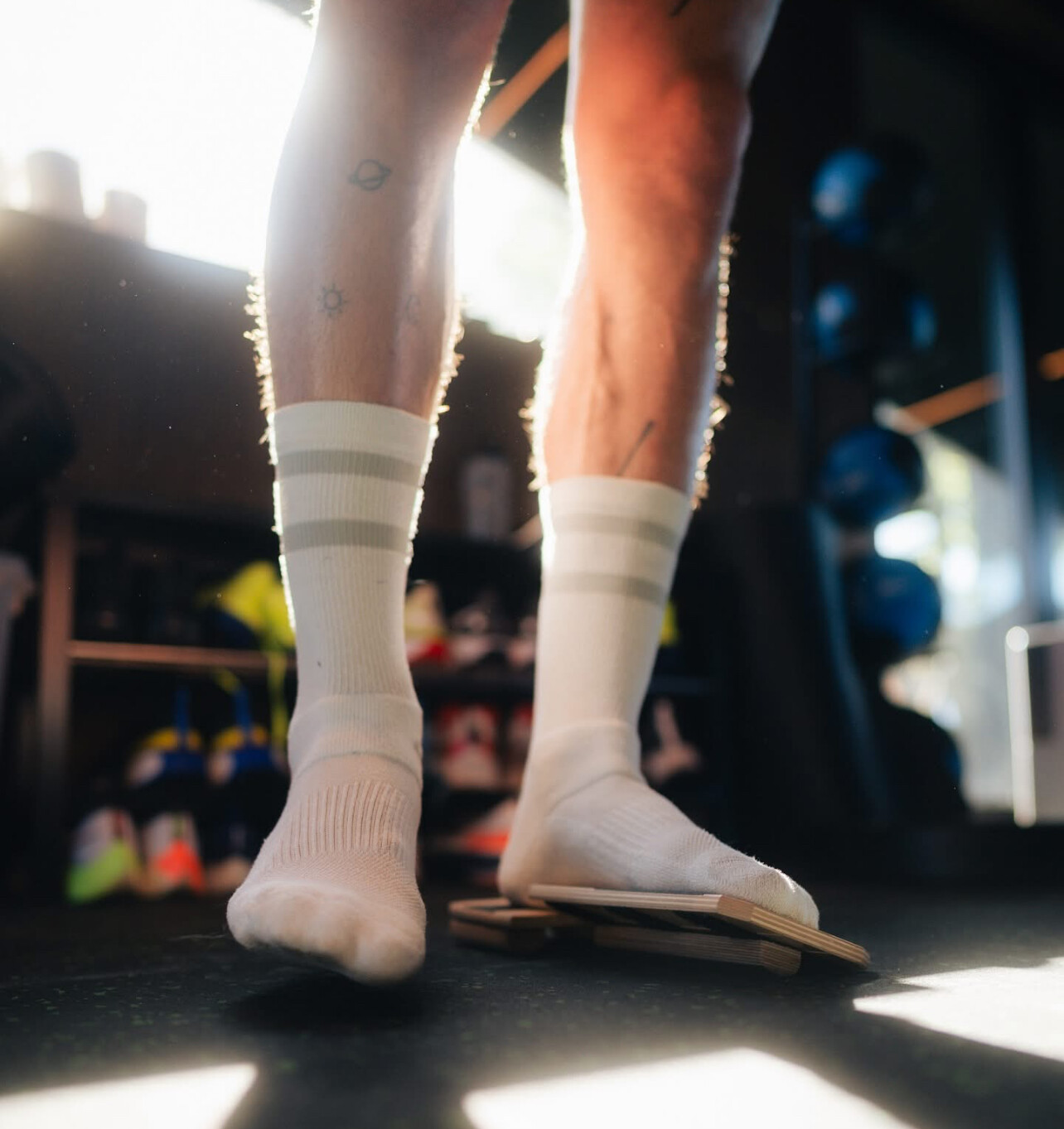
Altitude Training in St. Moritz
Coach Filip Ingebrigtsen has confirmed that Jakob will now join Norway’s altitude group in St. Moritz for a three- to four-week training block. The plan is to carefully build back fitness without rushing into competition. If all goes well, Jakob could return to racing in mid-August, with the Silesia Diamond League meeting in Poland emerging as a likely target.

While his return has been delayed, confidence remains high. Ingebrigtsen’s indoor season earlier this year was exceptional—he broke the world indoor records for both the 1500m and mile. In June, shortly before his Achilles flare-up, he set a new European 1500m record of 3:27.95 and clocked 7:54.10 in the two-mile, a world best.
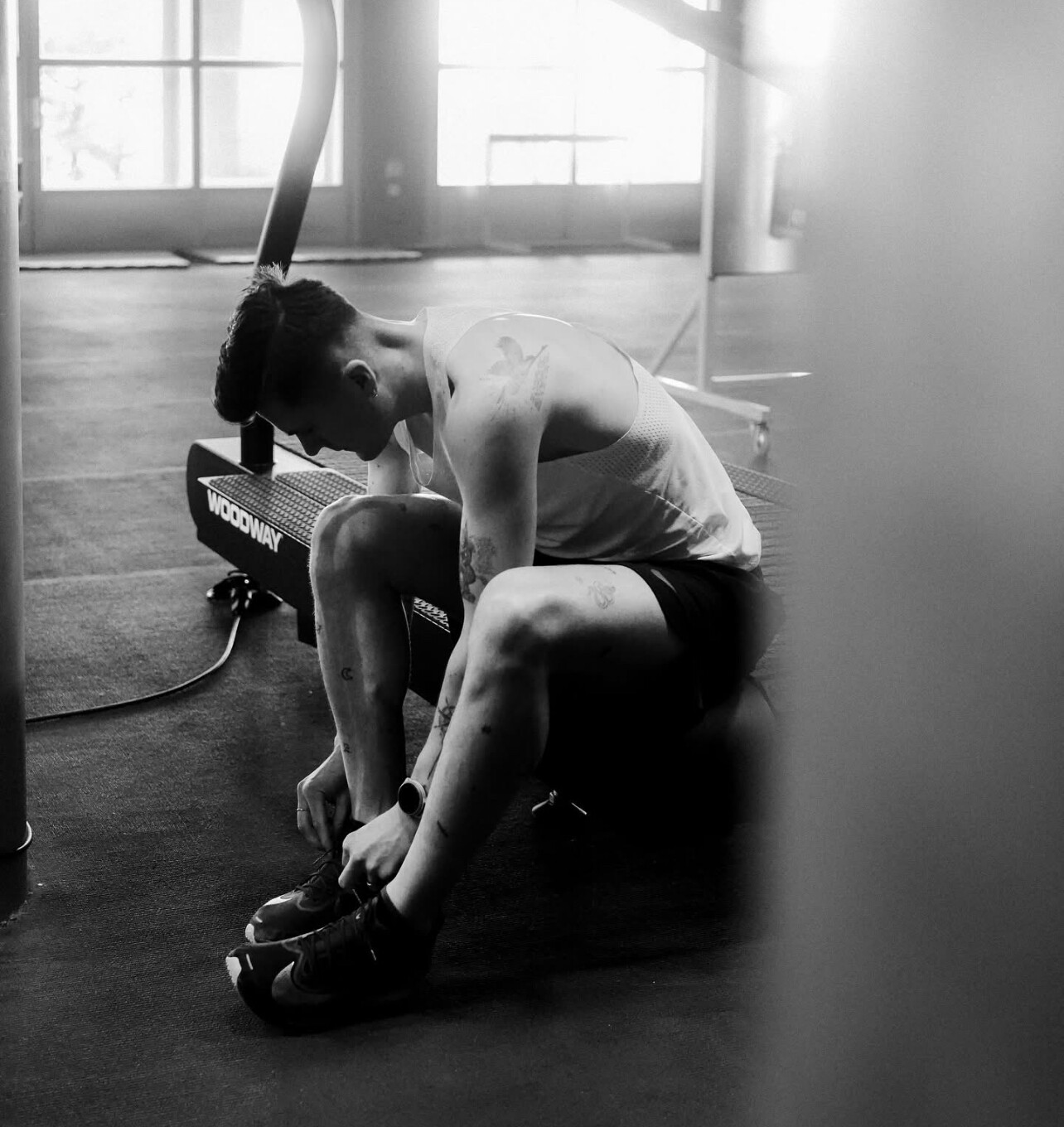
Personal Challenges and Legal Closure
In the midst of his recovery, Ingebrigtsen also had to navigate a difficult legal chapter. On June 23, his father, Gjert Ingebrigtsen, was convicted of minor assault against Jakob’s younger sister, Ingrid, for an incident involving a wet towel. Gjert received a 15-day suspended sentence and was ordered to pay damages. He was acquitted of similar charges involving Jakob due to lack of evidence.

The verdict marks a formal conclusion to a painful and public family dispute that first came to light in late 2023. With this chapter behind him, Jakob appears ready to shift focus fully back to his training and racing.
Looking Ahead
Jakob Ingebrigtsen’s approach to 2025 has been cautious but strategic. Rather than forcing an early comeback, he’s prioritized recovery, stability, and preparation. If his return to St. Moritz goes as planned, fans can expect to see him back on the track in top form later this summer—potentially just in time to contend for another global title.

by Boris Baron
Login to leave a comment
World Athletics Makes 300m Hurdles an Official Event
World Athletics has officially recognized the 300m hurdles as an official event, marking a major shift in the sport’s landscape. While it has long existed as a training and exhibition distance, the 300m hurdles will now count toward world rankings and all official statistical purposes, similar to the 400m hurdles.
In a statement released by World Athletics, the governing body noted:

“It will serve all World Athletics statistical purposes, including world rankings towards which it will score as a similar event to the 400m hurdles. A list of world best performances will be kept, while conditions for setting an inaugural world record will be decided at a later stage, once the popularity of the event has reached a meaningful level.”

Though not yet eligible for world records, the event already boasts elite-level performances. Norway’s Karsten Warholm—the 400m hurdles world record holder—blazed 33.26 in Oslo in 2021, a mark widely recognized as the world best. He followed it up with a 33.28 performance in Bergen last year.
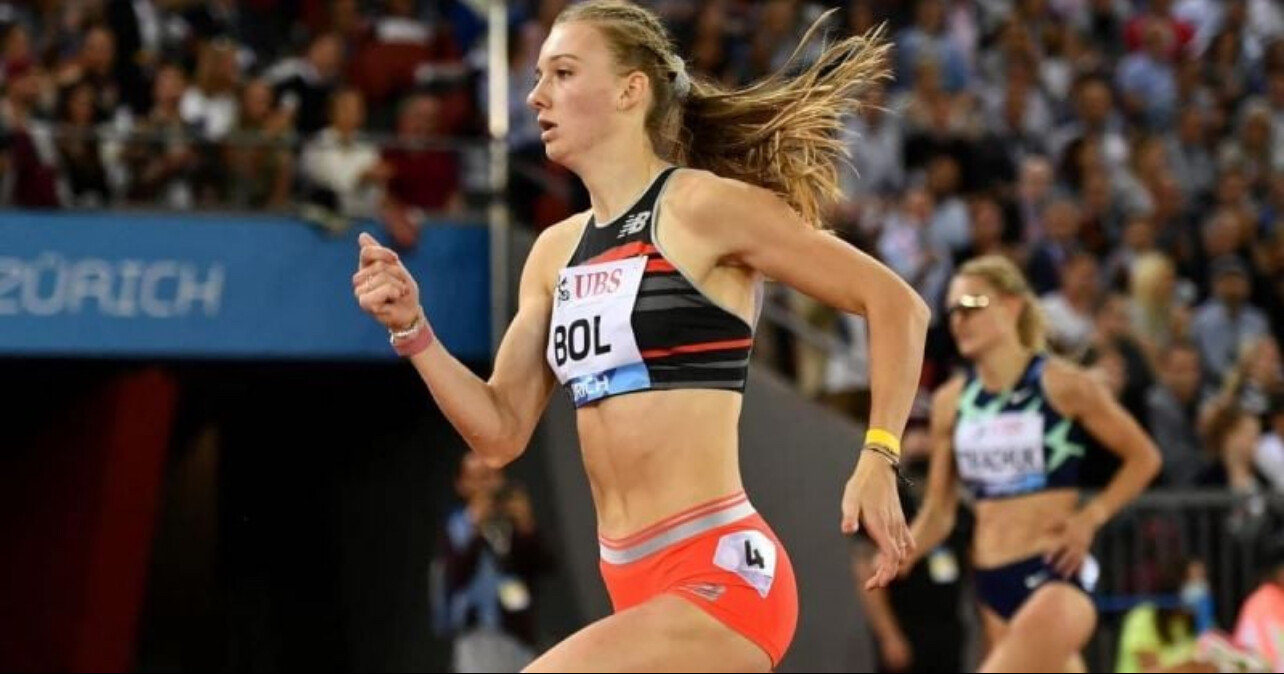
On the women’s side, Dutch superstar Femke Bol holds the top time with her 36.86 run in 2022.
The move to formalize the event brings renewed attention to what has typically been a non-championship distance. A major showcase is already on the calendar: the men’s 300m hurdles will feature at the Oslo Diamond League on June 12, 2025, setting the stage for a high-profile showdown in Warholm’s home country.
With elite athletes already embracing the event and more high-level races on the way, the 300m hurdles may soon become a fan favorite—and a mainstay in international competition.
Photos: Karsten Warholm Sets 300m Hurdles World Record
Norwegian hurdler Karsten Warholm setting the 300m hurdles world record with a time of 33.26 seconds at the Impossible Games in Oslo.
Femke Bol Breaks Women’s 300m Hurdles World Record
Dutch athlete Femke Bol breaking the women’s 300m hurdles world record with a time of 36.86 seconds at the Ostrava Golden Spike event.
by Boris Baron
Login to leave a comment
Athlos Returns Bigger Bolder and Ready to Make History
After a groundbreaking debut at Icahn Stadium in New York City, Athlos is set to return on October 10, 2025, promising an even bigger and better showcase of elite women’s track and field.
Last year, Athlos shattered records with a $663,000 prize purse—the largest ever for a women-only track meet. But it wasn’t just about the money. It was about recognition, opportunity, and redefining what’s possible for women in the sport.
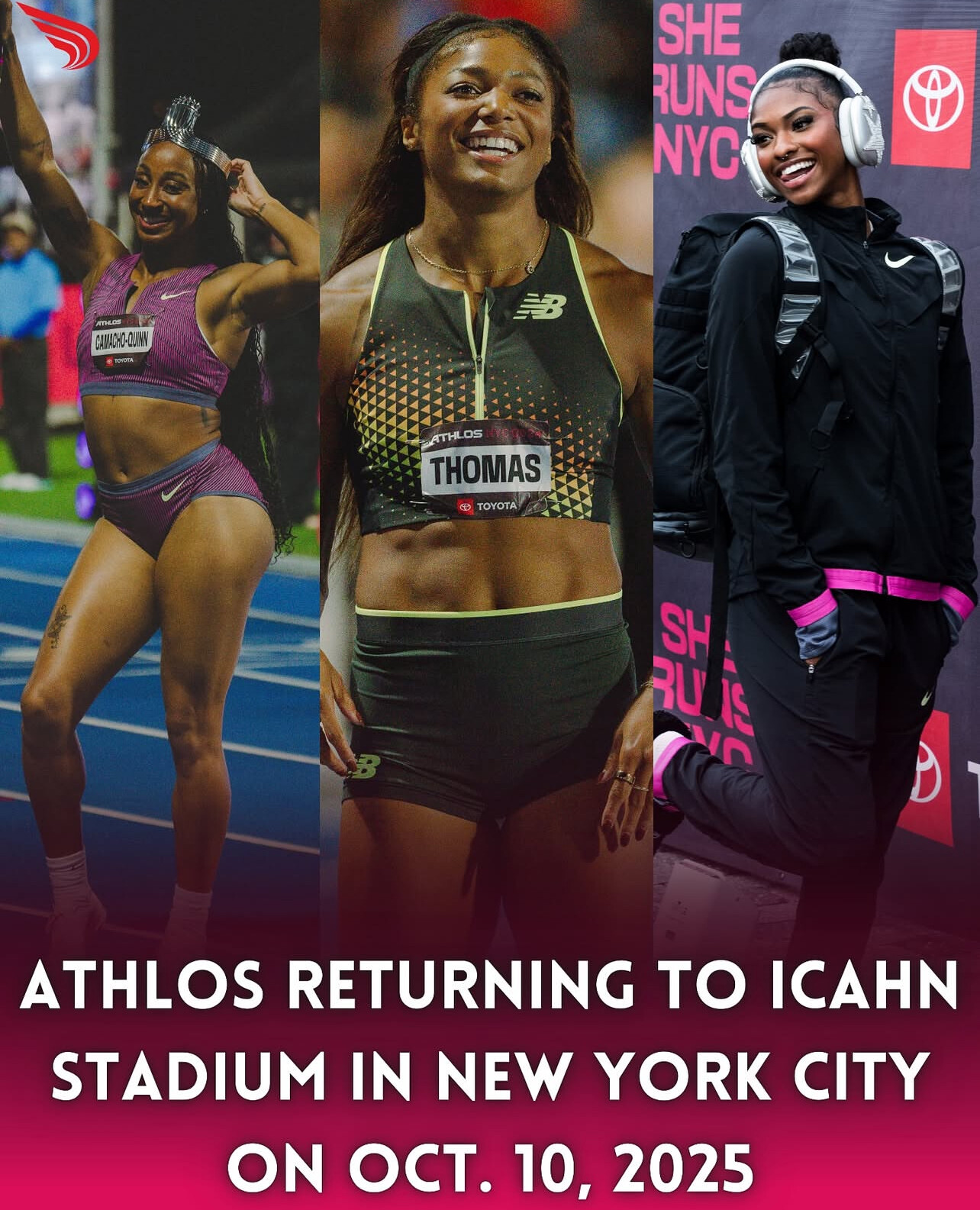
Now, Athlos is ready to take it to the next level, backed by leading sponsors who are investing in the future of women’s track and field.

A Historic Debut That Changed the Game
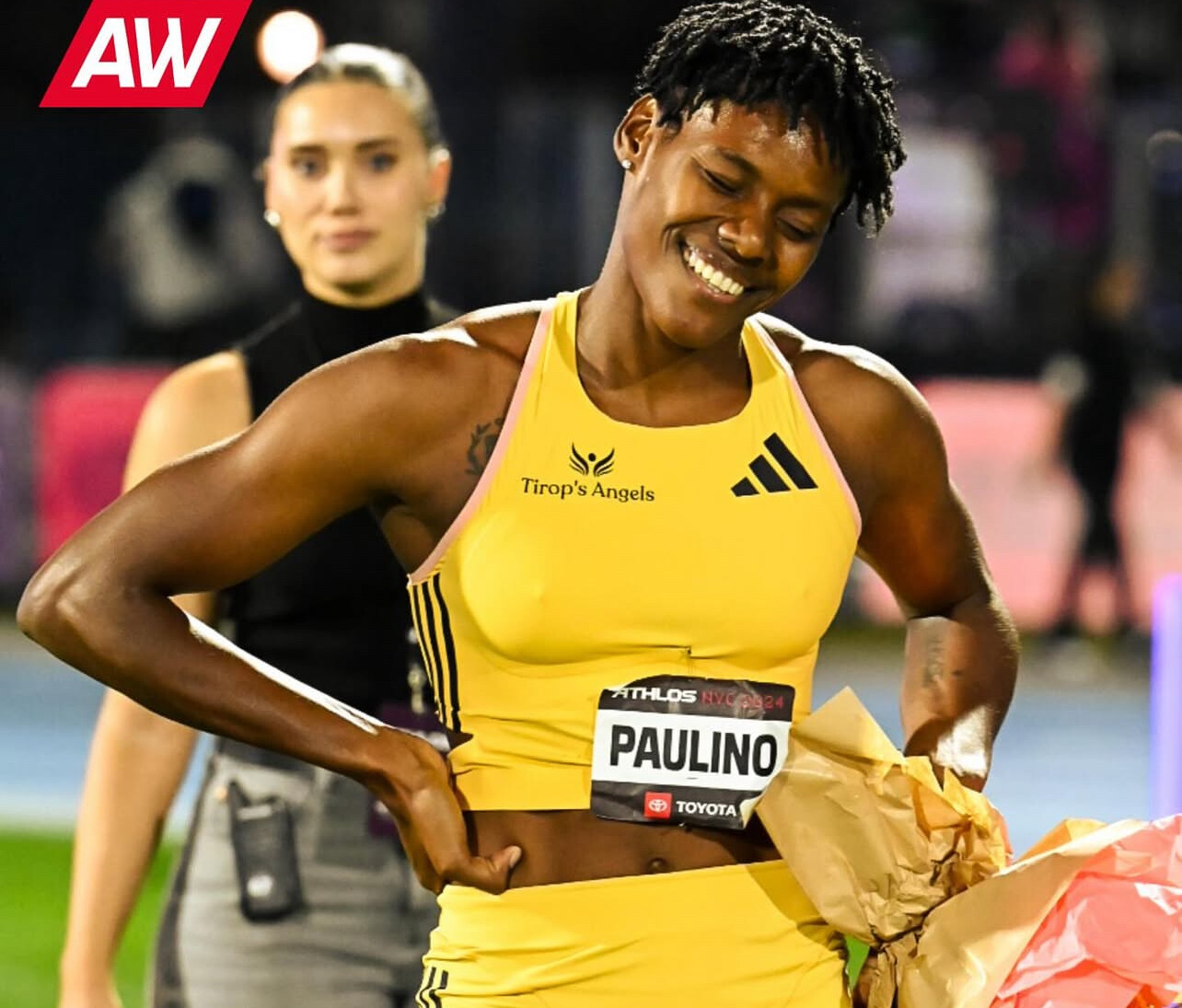
When Athlos launched in September 2024, it wasn’t just another track meet. It was a statement.

The event featured world-class athletes competing in sprints, middle-distance races, jumps, and throws in front of a packed New York crowd. The performances were electric, but the real impact went beyond the finish line. Athlos challenged the status quo, proving that a women’s-only event could deliver the excitement, competition, and financial backing the sport has long deserved.
With a $663,000 prize purse, Athlos gave female track athletes the kind of financial opportunities typically reserved for men’s competitions. Media coverage soared, sponsorship interest grew, and conversations about pay equity in athletics intensified.
Athlos had arrived, and it wasn’t just a one-time moment—it was the start of a movement.
Sponsors Driving the Future of Athlos
Athlos’ success has been fueled by a growing lineup of sponsors that recognize the power and potential of women’s track and field. Last year’s meet was backed by:
• Toyota Motor North America – Presented the 100-meter hurdles event, highlighting its commitment to empowering female athletes.
• Tiffany & Co. – Designed custom sterling silver crowns for each event winner, bringing prestige and elegance to the competition.
• Oiselle – Served as the inaugural athletic apparel sponsor, aligning with Athlos’ mission to elevate women in running.
• Therabody, Strava, Champagne Telmont, and Wyn Beauty – Provided additional sponsorship, enhancing the event’s reach and profile.
With these industry leaders backing the meet, Athlos is proving that women’s sports are a worthy investment—one that is growing in value every year.
What to Expect in 2025
With its second edition set for October, Athlos is raising the stakes. While the full event lineup is yet to be announced, here’s what fans can expect:
• More Star Power – Last year’s event brought together elite talent from around the world, and 2025 promises to be even bigger, featuring Olympians, world champions, and rising stars, all competing for one of the largest prize purses in women’s track history.
• Increased Prize Money? – The record-breaking $663,000 prize purse in 2024 set a new standard. Will Athlos push it even further in 2025? Organizers have hinted at an even larger payout, solidifying the event as a premier financial opportunity for female track athletes.
• Expanded Events – Last year’s meet featured select disciplines, but 2025 could see more events added, giving a broader platform for top-tier competition.
• A Next-Level Experience – Expect enhanced fan engagement, including interactive digital content, social media activations, and upgraded live streaming coverage, bringing Athlos to a global audience like never before.
More Than a Meet, a Movement for Women’s Track
Athlos isn’t just about race results. It’s about reshaping the landscape for female athletes.
For too long, women’s track and field has received less prize money, fewer sponsorship deals, and lower media visibility. But things are changing—fast. From record attendance in women’s soccer and basketball to major increases in broadcast ratings and sponsorship investments, women’s sports are finally getting the recognition they deserve.
Athlos is part of this shift.
By creating a high-profile, high-stakes competition exclusively for female athletes, it’s proving that women’s track isn’t just equal—it’s a must-watch event in its own right.
Countdown to Athlos 2025
With just months to go, excitement is building for the second edition of Athlos. The event isn’t just returning—it’s evolving, growing, and setting new standards for women’s athletics.
More details on prize money, event lineups, and athlete participation will be announced soon. But one thing is clear: Athlos is here to stay, and its impact is only getting stronger.
How to Watch and Get Tickets
Athlos 2025 will be live-streamed globally, with tickets available soon for the in-person event at Icahn Stadium in New York City. Official updates will be posted on the Athlos website and social media channels.
The countdown has begun. Women’s track is taking center stage, and Athlos is leading the charge.
by Boris Baron
Login to leave a comment
Run for Recovery: Join the Together LA Wildfire Relief Run on March 1
In response to the devastating wildfires that swept through Los Angeles County in January 2025, the Los Angeles Marathon has partnered with Strava to launch the Together LA Wildfire Relief Run. This virtual event, scheduled for Saturday, March 1, invites runners nationwide to support recovery efforts by logging miles on Strava and including “Together LA” in their activity titles. Strava has pledged a $20,000 donation to bolster the initiative.
Participants can further contribute by purchasing limited-edition Together LA merchandise, with all net proceeds directed to Community Organized Relief Effort (CORE) and the California Fire Foundation. These organizations are at the forefront of providing emergency relief and recovery services to the affected communities.
This collaborative effort underscores the resilience and unity of the running community, aiming to make a tangible impact in the lives of those affected by the wildfires.
For those unfamiliar, wildfires are uncontrolled fires that rapidly spread across vegetation, often exacerbated by dry conditions and strong winds. In regions like Los Angeles, these fires can cause significant destruction to homes and natural habitats, leading to substantial economic and environmental impacts.
Together, we run. Together, we rise. Together LA.
Login to leave a comment
Record-Breaking Performances Shine at Czech Indoor Gala in Ostrava
World indoor 1500m champion Freweyni Hailu delivered one of the fastest 3000m performances of all time at the Czech Indoor Gala—the fourth World Athletics Indoor Tour Gold meeting of the season—held in Ostrava on Tuesday (4).
Competing in just the third 3000m race of her career, the Ethiopian 23-year-old dominated with an 8:24.17 season opener, moving her to eighth on the world all-time list. Following a 2:52.08 split at 1000m and hitting 2000m in 5:45.8, Hailu surged over the final five laps, closing the last kilometre in 2:39 to secure victory.
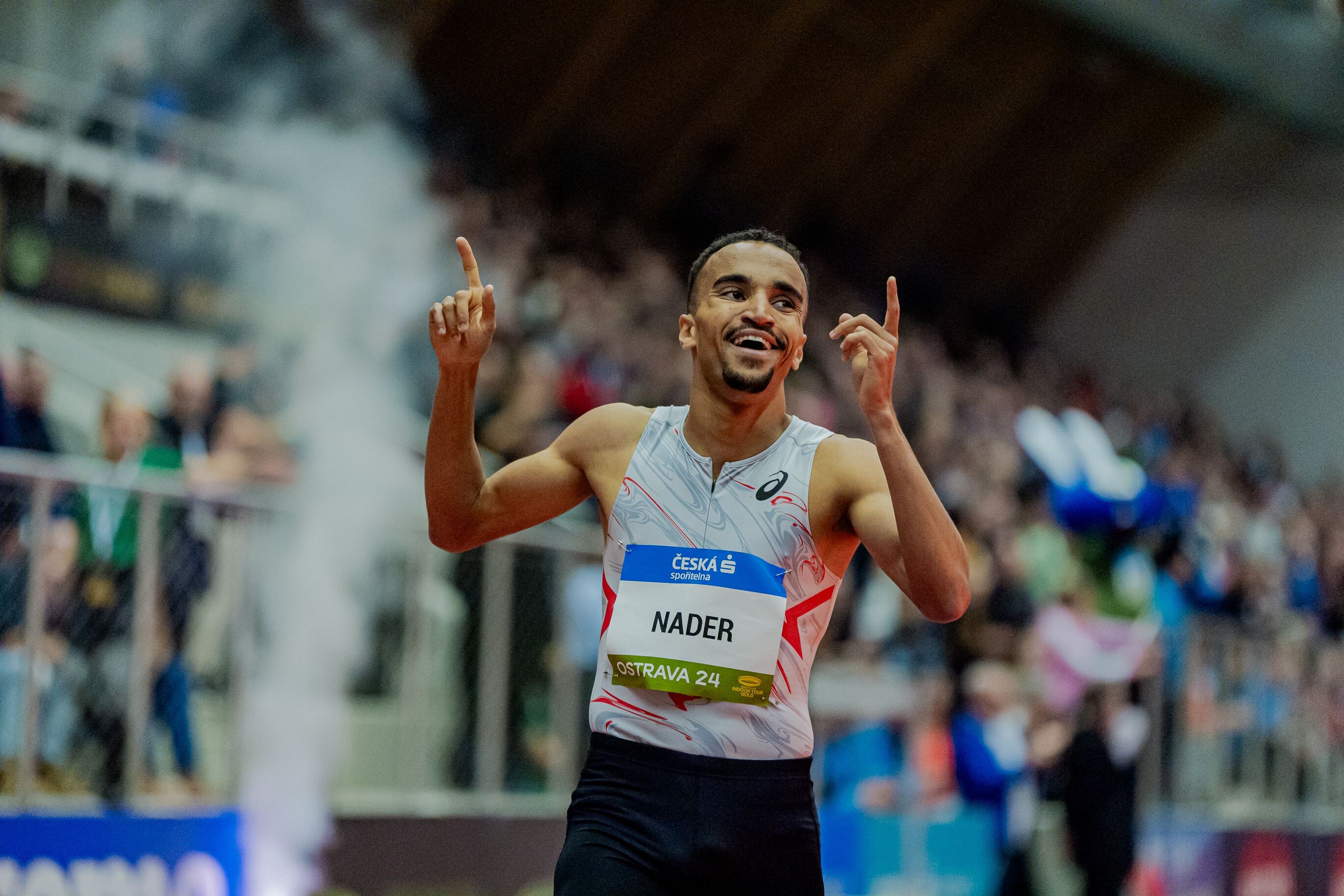
Portugal’s Salome Afonso, who ran with Hailu in the early stages, finished second in a personal best of 8:39.25, followed closely by Kenya’s Purity Kajuju Gitonga in 8:39.36. Great Britain’s 18-year-old Innes FitzGerald shattered the European indoor U20 record by over 10 seconds, running 8:40.05 to claim fourth place.

The men’s 800m also saw a standout performance, with Belgium’s Eliott Crestan breaking the 1:45 barrier indoors for the first time, clocking a national record of 1:44.69 in his season debut. The world indoor bronze medallist improved on his previous best of 1:45.08 from last year’s World Indoor Championships in Glasgow, securing 12th place on the world all-time list. Italy’s Catalin Tecuceanu finished second in 1:45.35, while Algeria’s Slimane Moula, making his indoor debut, took third in 1:45.50.
In the women’s 800m, Gabriela Gajanova emerged victorious in 2:02.16, overtaking world indoor bronze medallist Noelie Yarigo in the final 150m as Yarigo faded in the closing stretch.
Meanwhile, Portugal’s Isaac Nader continued his dominance in Ostrava, setting his second consecutive meeting record with a 3:54.17 mile after breaking the 1500m record last year. He surged past Great Britain’s Elliot Giles in the home straight, with Giles finishing second in 3:54.62 in his first indoor race since 2022. Sweden’s Samuel Pihlstrom also made history, running a Swedish indoor record of 3:54.78 to place third.
With multiple meeting records shattered and world-leading times set, the Czech Indoor Gala in Ostrava reaffirmed its status as a premier stop on the World Athletics Indoor Tour Gold circuit.
Login to leave a comment
Anticipation Builds for Middle-Distance Showdowns at 2025 Czech Indoor Gala
The Czech Indoor Gala, scheduled for February 4, 2025, in Ostrava, is set to feature thrilling middle-distance races, particularly in the men’s 800 meters and the women’s 3000 meters.
Men’s 800 Meters:
Czech national record holder Jakub Dudycha will compete on home soil. As a junior, he set a national U20 indoor record of 1:47.42 at the Czech Indoor Gala, later improving it to 1:47.12. Outdoors, he advanced to the semi-finals at the European Championships in Rome, clocking a time under 1:45, and subsequently set a new Czech senior record of 1:44.82 in Bydgoszcz. Dudycha has expressed his ambition to break the national indoor record this season.
He will face formidable international competitors, including Belgium’s Eliott Crestan, who is the sixth fastest European in history with a national record of 1:42.43 set at the Paris Diamond League meeting. Crestan is a bronze medallist from both the European and World Indoor Championships. Another strong contender is Catalin Tecuceanu, representing Italy since 2022, who secured European bronze in Rome and boasts personal bests of 1:45.00 indoors and 1:43.75 outdoors.
Women’s 3000 Meters:
Kristiina Sasínek Mäki, a Tokyo Olympics finalist, will compete in the 3000 meters. She has been training under Swiss coach Louis Heyer and is eager to showcase her progress. However, she will face stiff competition from African athletes. Ethiopia’s Freweyni Hailu, the 1500m world indoor champion from Glasgow 2024, returns after setting a meeting record in the mile at last year’s Czech Indoor Gala. Joining her is compatriot Sembo Almayew, the junior world record holder in the steeplechase and World U20 champion, as well as Norah Jeruto, the World 3000m steeplechase champion from the 2022 Eugene Championships, now representing Kazakhstan.
The Czech Indoor Gala, part of the World Athletics Indoor Tour Gold series, continues to attract top-tier talent, ensuring a night of exceptional athletic performances in Ostrava.
Login to leave a comment
5 Reasons to run outside all winter—and get stronger, tougher, faster, healthier and happier
In the winter of 1939, when the military posted Swedish miler Gundar Hagg to the far north of that nordic country, he devised a unique training program of running on trails through knee- or hip-deep snow. Most days he would do 2500 meters in snow for strength, followed by 2500 meters on a cleared road for turn-over. But during those times when he couldn’t find cleared roads—sometimes for weeks—he’d run up to the full 5-kilometers in snow. The next summer he set huge PRs, coming within one second of the mile world record.
Hagg continued his routine in subsequent winters, devising a hilly 5K loop in a different locale that trudged through snowy forest for 3000 meters then ended with a 2000 meter stretch of road where he could run at full speed. He kept improving, and the summer of 1942 he set 10 world records between the 1500 and 5,000 meters.
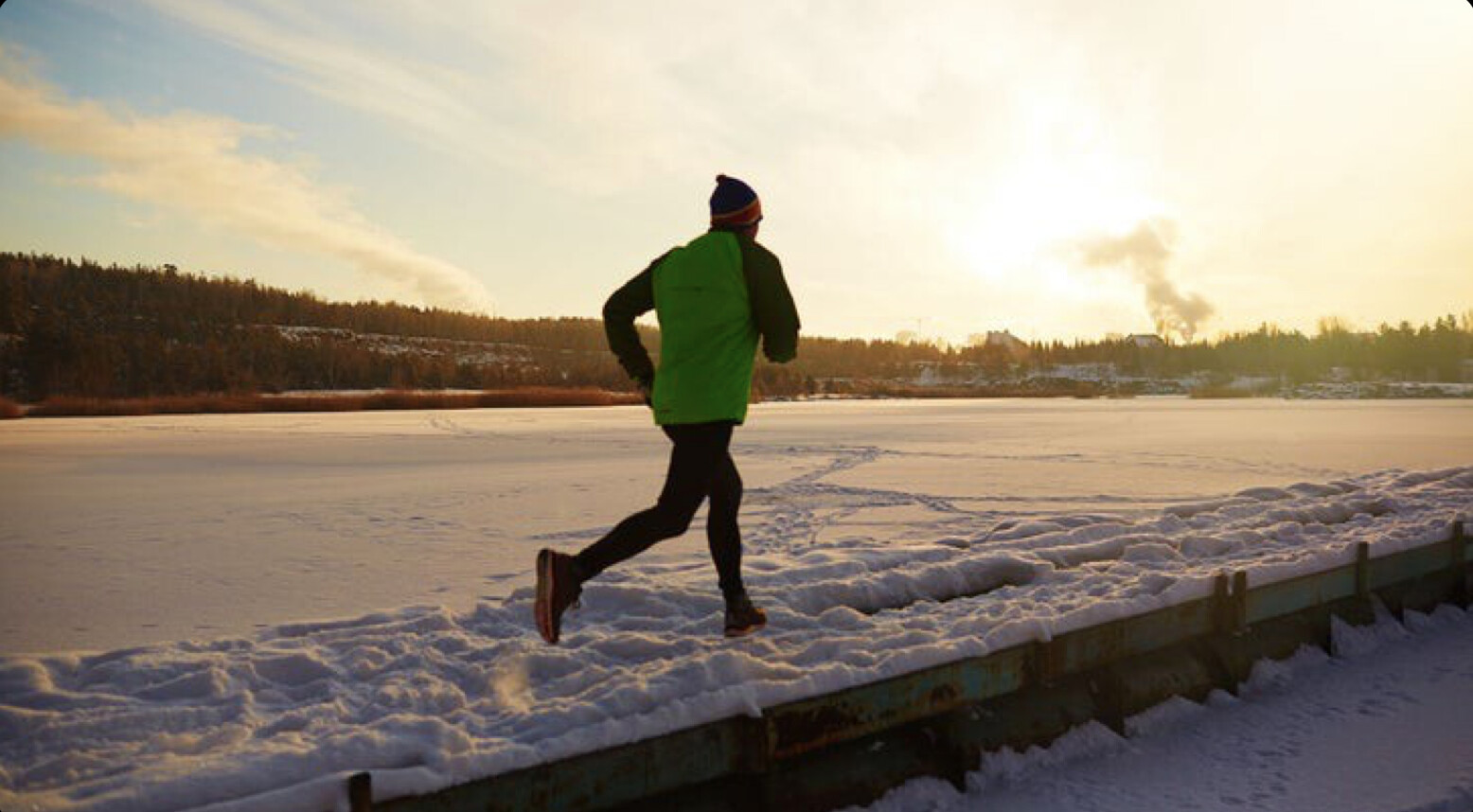
While Hagg’s routine was created out of necessity, he obviously valued the snowy training. When he moved to a city with a milder climate, he wrote in a training journal, “It will be harder running than any previous year. Probably there won’t be much snow.” And every winter he scheduled trips north to train on the familiar, tough, snowy trails.
Hagg isn’t the only runner who has found winter training valuable. Roger Robinson, who raced internationally for England and New Zealand in the 1960s before setting masters road records in the ‘80s, recalls his training for the deep-winter English cross country championships of the 1950’s and 60s. “We ran, often at race pace, over snow, mud, puddles, deep leaves, ploughed fields, scratchy stubble, stumpy grass, sticky clay, sheep-poo, whatever, uphill and down,” Robinson says. “And thus, without going near a gym or a machine, we developed strength, spring, flexibility, and stride versatility that also paid off later on the road or track; I made one of my biggest track breakthroughs after a winter spent running long intervals on a terrain of steep hills and soft shifting sand.”
Robinson, now 85, with two artificial knees, still runs in the cold and slop. “Running is still in great part about feeling the surfaces and shape of the earth under my feet,” he says.
Hagg and Robinson are of a different generation than those of us with web-connected treadmills that can let us run any course on earth from the comfort of our basement, but they’re on to something we might still benefit from: winter can be an effective training tool. Here are five reasons you’ll want to bundle up and head out regardless of the conditions, indeed, why you can delight when it is particularly nasty out.
1) Winter Running Makes You Strong
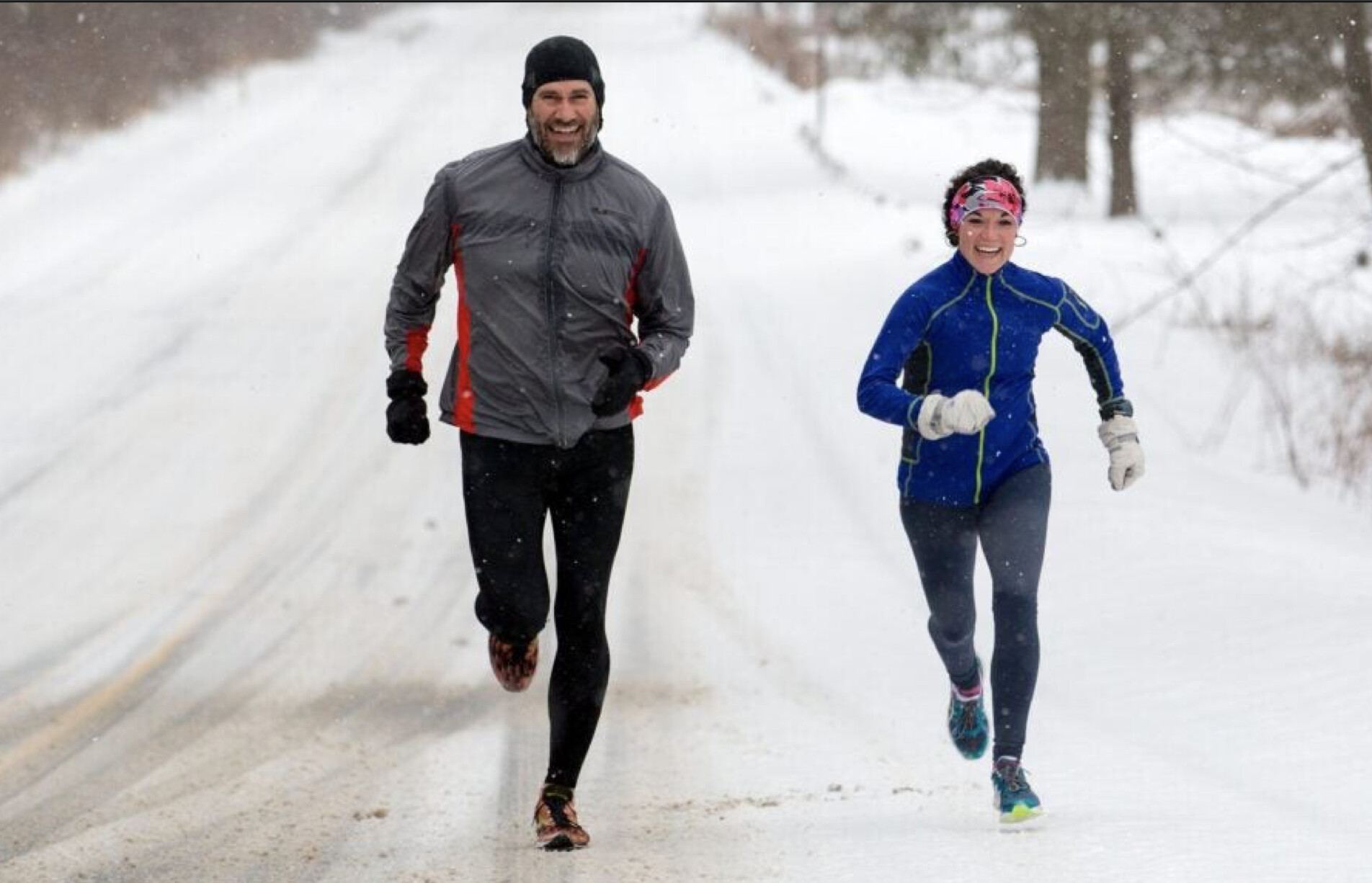
As Hagg demonstrated and Robinson points out, winter conditions work muscles and tendons you’d never recruit on the smooth, dry path. A deep-winter run often ends up being as diverse as a set of form and flexibility drills: high knees, bounds, skips, side-lunges, one-leg balancing.
Bill Aris, coach of the perennially-successful Fayetteville-Manlius high school programs, believes that tough winter conditions are ideal for off-season training that has the goal of building aerobic and muscular strength. He sends the kids out every day during the upstate New York winter, and says they come back, “sweating, exhausted and smiling, feeling like they have completely worked every system in their bodies.”
2) Winter Running Makes You Tough
No matter how much you know it is good for you and that you’ll be glad when you’re done, it takes gumption to bundle up, get out the door and face the wintry blast day after day. But besides getting physically stronger, you’re also building mental steel. When you’ve battled snow and slop, darkness and biting winds all winter, the challenges of distance, hills and speed will seem tame come spring.
3) Winter Running Improves Your Stride
Running on the same smooth, flat ground every day can lead to running ruts. Our neuromuscular patterns become calcified and the same muscles get used repeatedly. This makes running feel easier, but it also predisposes us to injury and prevents us from improving our stride as we get fitter or improve our strength and mobility. Introducing a variety of surfaces and uncertain footplants shakes up our stride, recruits different muscles in different movement patterns, and makes our stride more effective and robust as new patterns are discovered.
You can create this stride shake-up by hitting a technical trail. But as Megan Roche, physician, ultrarunning champion, clinical researcher at Stanford and Strava running coach, points out, “A lot of runners don’t have access to trails. Many runners are running on flat ground, roads—having snow and ice is actually helpful, makes it like a trail.”
In addition to creating variety, slippery winter conditions also encourage elements of an efficient, low-impact stride. “One thing running on snow or ice reinforces is a high turn over rate and a bit more mindfulness of where your feet are hitting the ground,” Roche says. “And those two things combine to a reduced injury risk.” After a winter of taking quicker, more balanced strides, those patterns will persist, and you’ll be a smoother, more durable runner when you start speeding up and going longer on clearer roads.
4) Winter Running Makes You Healthier
“Exercising in general, particularly during periods of higher cold or flu season has a protective effect in terms of the immune system,” says Roche. You get this benefit by getting your heart rate up and getting moving even indoors, but Roche says, “Getting outside is generally preferable—fresh air has its own positive effect.”
Cathy Fieseler, ultrarunner, sports physician, and chairman of the board of directors of the International Institute of Race Medicine (IIRM), says there’s not much scientific literature to prove it, but agrees that in her experience getting outside has health benefits. “In cold weather the furnace heat in the house dries up your throat and thickens the mucous in the sinuses,” Fieseler says. “The cold air clears this out; it really clears your head.”
Fieseler warns, however, that cold can trigger bronchospasms in those with asthma, and Roche suggests that when it gets really cold you wear a balaclava or scarf over your mouth to hold some heat in and keep your lungs warmer. “Anything below zero, you need to be dressed really well and mindful of your lungs, making sure that you’re not exposing your lungs to too cold for too long,” Roche says.
5) Winter Running Makes You Feel Better
For all its training and health benefits, the thing that will most likely get most of us out the door on white and windy days is that it makes us feel great. “A number of runners that I coach and that I see in clinics suffer from feeling more depressed or a little bit lower in winter,” says Roche. “Running is a great way to combat that. There’s something really freeing about getting out doors, feeling the fresh air and having that outdoor stress release.”
Research shows that getting outside is qualitatively different than exercising indoors. A 2011 systematic review of related studies concluded, “Compared with exercising indoors, exercising in natural environments was associated with greater feelings of revitalization and positive engagement, decreases in tension, confusion, anger, and depression, and increased energy.” They also found that “participants reported greater enjoyment and satisfaction with outdoor activity and declared a greater intent to repeat the activity at a later date.”
That “intent to repeat” is important. Running becomes easier and more enjoyable, the more you do it. “Consist running is really the most fun running,” Roche says. “It takes four weeks of consistency to really feel good. Your body just locks into it.”
Most people associate consistency with discipline, and setting goals and being accountable is an effective way to build a consistent habit. Strava data shows that people who set goals are much more consistent and persistent in their activities throughout the year. The desire to achieve a goal can help overcome that moment of inertia when we’re weighing current comfort with potential enjoyment.
But the best way to create long-term consistency is learning to love the run itself. Runners who make it a regular part of their life talk little about discipline and more about how much they appreciate the chance to escape and to experience the world on their run each day—even, perhaps especially, on the blustery, cold, sloppy ones.
Login to leave a comment
Chipotle ends Los Angeles Strava challenge due to the wildfires
Chipotle’s January Strava challenge, offering runners a chance to win free Chipotle for a year, has come to a halt in Los Angeles as devastating wildfires forced the company to end the city competition early. With more than 180,000 residents evacuated due to fires in the city’s northwest, Chipotle decided it would be best to prioritize safety, and stopped the challenge at 11:59 p.m. PT on Thursday.The challenge was a hit in Los Angeles, which led to the global Strava x Chipotle City Challenge competition before the wildfires began on Jan. 7.
The challenge involves runners worldwide competing to become “Local Legends” by completing the most designated Strava segments during the month. The top individual in each participating city wins free Chipotle for a year, while cities collectively logging the highest mileage earn rewards like buy-one-get-one (BOGO) entrée deals for all residents.

Chipotle issued a statement explaining their decision: “Los Angeles, your health and safety is our greatest priority. Due to the devastating wildfires that are impacting the area, we are ending the Chipotle Los Angeles Segment Challenge at 11:59 p.m. PT on January 9, 2025. The Local Legend who has the greatest number of attempts at that time will be awarded with Lifestyle Bowls for a Year.”
Particles from wildfire smoke and other pollutants can be deadly and impact health. This is particularly concerning for runners, as intense outdoor exercise can aggravate the effects of airborne pollutants.
Brandon Fang of Del Rey, Calif., was named the winner after logging an incredible 284 efforts on the 330-metre segment (93.72 kilometres). On the final day of the challenge, Fang ran 12 kilometres on the segment in the morning, then returned later in the evening to run 50K after hearing about the early cutoff–all to secure a year’s worth of Chipotle.
While the Los Angeles competition came to an end due to the catastrophic fires, it continues in 24 other cities across North America and Europe (including Toronto). Runners in those cities still have a chance to win prizes and contribute to their city’s mileage totals.
Login to leave a comment
5 icky running habits to drop in 2025
The new year often comes with a wave of resolutions and the familiar chorus of “New year, new me.” Sure–sticking to these promises is much easier said than done, but it’s worth a try–especially when some running habits don’t deserve a spot in your 2025 plans. Here are five habits runners should ditch while striding into this fresh year of training.
1. Comparing your stats


Whether you’re racing your training partners during intervals or getting lost in a Strava rabbit hole chasing kudos, it’s time to pump the brakes. Running isn’t always a competition, and continuously pushing the pace can sour relationships with your running buddies. No one enjoys being dipped at the finish line of a workout, especially when they’re expecting a chill session.
Remember, comparing stats–be it heart rate or paces–won’t always reveal who is the better athlete. Everyone’s body and running style is different; the workout warrior might not be as strong on race day. Moreover, constantly comparing yourself to your peers will take a toll on your mental health. Focusing on your own progress can allow running to continue being fun and fulfilling.
2. Running through pain
We’ve all done it–brushing off pain as mere stiffness or a minor tweak. But pushing through is a fast track to injury. Your running buddies don’t want to hear your complaints now, and they’ll want to hear them even less if that tweak turns into a major setback.
Taking a day or two off, or even swapping out running for a bike ride or fast hike (i.e., cross-training) could save you from weeks on the sidelines. Listen to your body and leave running through pain in the past.
3. Not washing hats and headbands
Running hats and headbands, usually lost in the bottom of your bag, often get overlooked on laundry day, leaving you with a smelly accessory you’re too embarrassed to admit hasn’t been washed in weeks. It’s official: this is the year we show our headwear as much love as our shirts and shorts. You can even go as far as investing in a couple of extras to keep the rotation fresh; your scalp–and teammates–will thank you.
4. Forgetting sunscreen
Runners are notorious for skipping sun protection. Studies show that runners, especially marathoners, are at a higher risk for skin cancer, due to prolonged sun exposure. Make sunscreen as essential as your winter gloves and dry socks. Toss a bottle into your running bag so you’re always prepared–2025 isn’t the year for excuses.
5. Skipping strength
Complaining about injuries but skipping the weight room? That’s so last year. While strength isn’t as critical to performance for endurance athletes as it is for sprinters, it’s still a key ingredient for injury prevention–for all runners.
Building muscles that support and stabilize joints will help your body handle the repetitive impact of running. Strength isn’t a huge commitment, either; two to three brief sessions per week is the perfect way to invest in your longevity as a runner.
Login to leave a comment
How to review your running year so you can improve in the months to come
THE END OF THE YEAR IS A GREAT TIME TO reflect on your running over the past 12 months – whether your aim has been fun, achieving parkrun PBs or preparing for a marathon.
A year-end review can help you spot trends, address setbacks and enhance your training for the upcoming year – whether that’s to boost performance or increase enjoyment. To do this, I encourage you to conduct a light performance analysis. It doesn’t require extensive data; instead, ask yourself key questions to start the new year with focus.

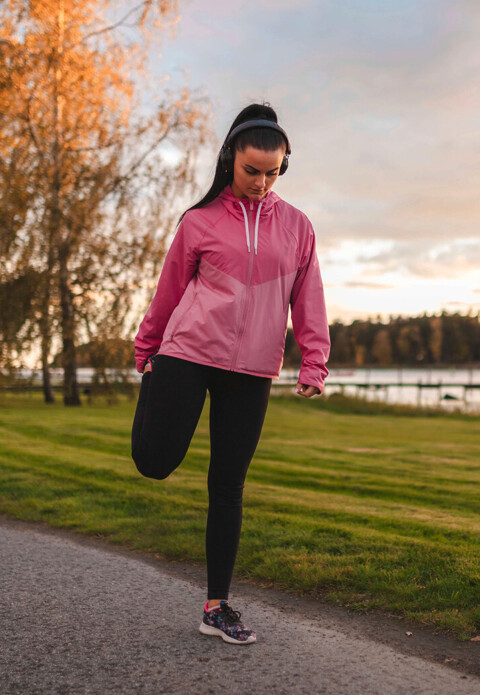
Audit yourself
Begin by reflecting on your goal-setting from a year ago. What were those goals? Are they still relevant? Perhaps you achieved several PBs or completed a couch to 5K programme and need a new challenge. Alternatively, you might need to scale back this year if your previous goals were unattainable. Remember, running should be enjoyable, and it’s normal to experience ups and downs.
Then take a closer look at your training, racing and lifestyle over the past year. Use data, along with the self-reflection questions to follow, to score yourself from one to five in the areas identified. This will guide your goal-setting and action plan for the year ahead.
1. Physical
This covers your overall fitness, strength, endurance and injury prevention. If you’re more experienced, you might use data from apps such as Strava or Garmin Connect, or a detailed training log. This can include metrics such as mileage, heart rate or HRV measurements. For the performance-minded, consider lab testing such as lactate and VO2-max testing. If you’re less experienced, focus on how your rate of perceived exertion (RPE) might have changed in different training sessions and races as the year went on.
● Endurance Review your total volume over the year in distance or time. Were there gaps in consistency owing to injury, motivation or life events? Have you included longer runs regularly? Do you feel your heart rate or effort has reduced for similar paces, or are you able to sustain your pace for longer periods?
● Speed and power Analyse improvements in shorter races compared with longer ones. Use the RW race-time predictor to see if you align more closely on longer or shorter races, or if you are well balanced. Reflect on your training: did you include a mix of long runs, intervals, fartlek sessions, hill workouts, tempo runs and recovery runs? A well-rounded training plan leads to balanced improvement.
● Injury and strength Track how many injuries you’ve had, and their severity and causes. Has strength training supported your running? Use strength and flexibility tests such as knee-to-wall tests and sit-and-reach tests to benchmark yourself against norms for your age.
2. Planning and performance
This section looks at your approach to training plans and race performance.
● Race pace vs training pace Are you performing consistently in races compared with training? Do you feel you underperform or overperform in competitive situations?
● Variety Did you include races of different distances and on various surfaces throughout the year? Or did you stay in a comfort zone with your favourite or strongest type of race?
● Splits Evaluate how you pace yourself during races. Do you start too fast and fade, or do you
3. Mindset and wellbeing
Your mindset and emotional wellbeing play a significant role in your running performance, as well as in maintaining your motivation and consistency.
● Motivation and enjoyment Did you maintain enthusiasm for running or were there periods of low motivation? Identify factors that contributed to any highs and lows.
● Anxiety and pressure Did you regularly feel stressed or anxious about your running or performance? Consider your goal-setting and whether you have the right balance between process and outcome focus.
● Race nerves and focus Evaluate how you handled race-day pressure. Did you feel confident and focused or did nerves affect your performance? Assess your mental approach to tough runs and races – did you stay positive and push through challenging moments? Did you explore any mental techniques such as positive self-talk or mantras for key moments in races?
● Consistency and commitment Look at how disciplined you were with your training. Did you skip runs or stay consistent? What external factors affected your behaviour and how well did you handle those disruptions?
4. Recovery
You can follow the perfect plan with a good mix of training, but if you don’t recover, your fitness gains will be limited and you’re more likely to pick up injuries. Various pieces of data can help you monitor recovery, such as sleep tracking, heart-rate variability and the ‘recovery’ metrics from most GPS watches. Often, however, you’ll know if improvements are needed by answering some key questions:
● Sleep and rest Assess how well you prioritised rest, including sleep quality and duration. Poor recovery can lead to fatigue, injury and decreased performance, so reflect on how (or if) you balanced your hard training with adequate rest.
● Nutrition and hydration Did you fuel properly before during and after runs? Did you hydrate adequately, especially during long runs and races? Have you noticed patterns between nutrition and performance? Did you effectively plan and practise your race-day nutrition?
● Health and vitality Did you frequently catch colds or infections? In the run-up to key races, did you keep doing the simple things, such as using hand gel and taking any supplements you might need?
● Injury recovery Did you give yourself enough time to heal, follow rehab exercises and ease back
Write these down as a simple action plan with up to five priorities. Create objectives that are realistic and motivating, balancing short-term achievements – such as improving your pace or increasing weekly volume – with long-term ambitions, such as completing a marathon or getting a personal best.
Lastly, remember that running isn’t just about performance. Think about how to add enjoyment to your running, such as participating in races of different distances or on various surfaces. Consider joining a club or training group to maximise the social and mental health benefits of running.
Combining all of these lessons will help you get more from your running in 2025, whatever your goal may be. Good luck!
Login to leave a comment
You Failed Your Workout—Now What?
It’s Tuesday. No, it’s not only Tuesday. It’s critical velocity day. My coach has assigned me two warm-up miles and six by 800 meters in 3:13-3:21, with a 90 second jog between each one. I head out to smash the workout. I’m confident. I’m excited. Then, I start.
It’s blistering hot. Sweat is dragging all my face sunscreen down my forehead into my eyes. Water sloshes in my stomach. I’m so thirsty, but I can’t drink anymore or I’ll puke. I start to slow. Miss my paces. What is happening? My head spins and I get this horrible gut-wrenching feeling as I pull through the last interval. My coach is going to be disappointed. My Strava is going to be humiliating. Because I absolutely, undoubtedly failed this run.
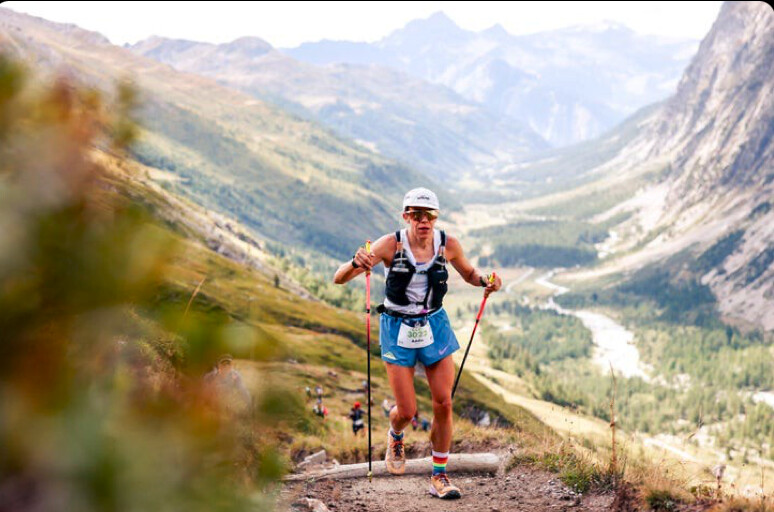
Thinking of yourself or your run as a failure can be debilitating and keep you down for days. For a while, I thought I needed to stifle this feeling. But as it turns out, I should be making nice with failure rather than fighting it.
The ‘F’ Word: Failing a Workout
So what exactly does it mean to “fail” a run? It looks different for everyone, but to many runners it means missing the splits of your prescribed workout. You can fail in training and fail in a race—both can be disheartening. However, running coach and founder of Run Your Personal Best, Cory Smith, says this doesn’t always mean you’re running too slow.
“A lot of people think the faster you run, the better,” he says. “But if you’re trying to hit a certain zone or train a certain adaptation and you run too fast, then you’re training something different than your coach wanted you to train, that can be a failure, too.”
In fact, Smith doesn’t believe going slower than your prescribed paces should be defined as the typical, negative definition of failure.
“Failure is data collection,” he says. “It’s learning information. If I fail a workout, it doesn’t make me a failure as a person or an athlete, it’s just an opportunity to look at the data and figure out how to grow from it.”
Oftentimes you’ll hear runners call it the “F word” or scold others for talking about failure, but
“We have an opportunity, with our language, to normalize failure,” she says. “If we can redefine it, we change our relationship with it.”
What both Foerster and Smith stress the most is that one bad workout doesn’t make or break you. Smith compares it to basing your retirement fund on one day when the market went down, even though we know it goes up and down all the time.
“The most powerful thought around failure is that one workout never makes or breaks a race or athlete,” Foerester says. “We’re in a constant state of learning, if we open ourselves up to be.”
Beating yourself up over a workout can often bleed into your next run, creating a sort of downward spiral effect.
“It puts you into a negative mindset, and then the next workout you’re going to put more pressure on yourself to do well, to convince yourself that last workout was just a fluke,” Smith says. “This leads to anxiety, which can hurt your workout performance.”
One study reports that a negative emotional state can hinder athletic performance. Speed, specifically, was proven to be affected by emotional state. This study examined the correlation between sadness and depression and reduced running speeds, head movements, and arm swinging.
In other words, failure can be heavy, if you let it.
An Upsetting UTMB: Failing a Race
Like we said, failure looks different for everyone. So far, we’ve been talking about failing during training sessions—which can be referred to as process failure. An outcome failure, however, is not meeting an end-result or goal for which you trained. Like a race.
For Addie Bracy, it looks like an uncharacteristic 116th place in the 2023 CCC 100K last September. Bracy is an elite trail runner, winning the 2021 Run Rabbit Run 100 and placing third at the 2023 Speedgoat 50K. She has a consistent track record across the board and even has her masters in Sport and Performance Psychology.
“I had a pretty poor performance,” she says, reflecting on CCC. “Objectively, one of the worst I’ve ever had in trail running, and certainly not the race I trained for.”
Bracy says she can’t pinpoint a rhyme or reason why, but that it just wasn’t clicking that day. At a certain point, she realized the race wasn’t going the way she thought and reframed her mindset. Failure, in her definition, is only when you give up—and she chose not to.
“I think that’s the beauty of ultras—they’re so long that you’re going through the mental process then and there,” she says. “I had thoughts of stopping, but I went through the mentality of ‘That’s not why you do this,’ and gave my best effort to focus on just finishing instead of making a certain time.”
This is what Smith identifies as performance standards versus outcome goals.
“Outcome goals are the splits you or your coach sets or the final finishing time,” he says. “The performance standards aren’t outcomes, but how much effort you put into whatever that task is.”
Meaning, Bracy started with an outcome goal of a particular time, and mid-race, reframed her goals to do
Foerster goes a step further and says that failure is not only okay, it’s actually beneficial.
“Anytime we can meet emotional discomfort where we have to deal with heavy emotions like disappointment, we teach ourselves how to navigate that more effectively,” Foerster says. “So that when we meet another uncomfortable moment in a race, we know we can meet it and process through it.”
In a study conducted by Ayelet Fishbach, Behavioral Science professor at University of Chicago, and Kaitlin Woolley, associate professor at the SC Johnson Cornell College of Business, it was proven that discomfort could lead to personal growth. By applying cognitive reappraisal, study participants assigned a new meaning to discomfort before they experienced it so it served as motivation rather than a reason to stop their goals. And, in the case of this study, participants who were forced into discomfort while doing a task reported a greater sense of achievement.
Much like running itself can be uncomfortable, forcing yourself to address the emotions that come with failure can be an unfamiliar, disagreeable experience. But doing so allows you to feel, process, and recognize that you can change your relationship with failure every time you meet it.
“Discomfort is the currency to our dreams,” Foerster says. “If we’re willing to meet it, all our potential is on the other side.”
So miss those splits. Fail, and fail hard. Address the feeling head-on and don’t let it define you. It’s just one out of many more runs to come.
Login to leave a comment
Strava removes 6.5 million “impossible” performances from leaderboards
Is the popular fitness tracking app finally taking the necessary steps to catch cheaters?
You know that time you “accidentally” uploaded your bike ride as a run on Strava and found yourself launched to the top of the segment leaderboard? Well, the Strava police are out to get you. On Tuesday, the fitness tracking service introduced an upgraded algorithm to pre-emptively remove performances that are a little too good–including your impressive (and very impossible) three-minute mile run. The app also revealed they’ll be erasing 6,500,000 suspicious uploads from existing leaderboards upfront.
With 85 million segment efforts uploaded daily to the app, inspecting each performance thoroughly is hopeless. The service relies heavily on its users to report inaccurate or suspicious results in addition to its current filtration system, but millions of “impossible” activities still make their way past these existing lines of defence onto the leaderboard top 10. The new auto-flagging system is set to detect segment performances that are a little too good to be true before they even reach the leaderboards.

“This is BS! I was 30 seconds off [Kelvin] Kiptum’s world record and I only had to change tires once.” one user joked on Reddit.
Runs that are obviously completed on a bike and rides that are clearly logged from a car or e-bike will be the first to go. Strava runners have found the app’s uploads increasingly demoralizing–imagine running a mile-long segment in a best time of 4:30, only to find all 10 runs in the leaderboard are sub-four minutes and completed at a heart rate of 110 BPM.
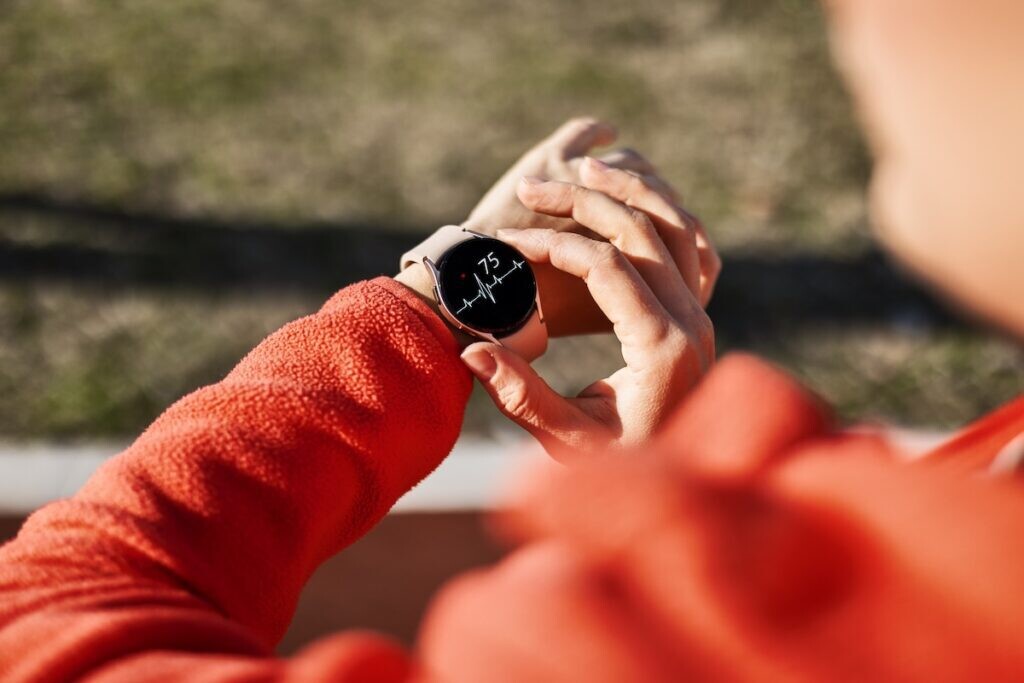
Strava users have raised doubts on how thorough and effective this new algorithm will be–the service had already advertised upgrades to the flagging system in September and last year, but leaderboards saw little improvement. “This was announced over a year ago already and from what I can see, nothing has changed,” one user wrote. Numerous comments also address the need for an in-app flagging function; currently, Strava only allows users to flag suspicious activities through a web browser.
Other users are ecstatic at the chance to have an honest leaderboard and an actual shot at claiming the Local Legend title. “Yea Strava!” one user wrote. “Thanks for the acknowledgment and efforts to straighten out the issue. A big task to deal with, I know.”
“Brilliant news,” another comment reads. “If this also sorts out the challenges at the same time, that will encourage me to enter them again. Too many are blatantly cheating.”
Strava acknowledged they won’t be able to catch 100 per cent of cheaters, but says the added layer of filtration will help ensure that authentic performances and users get the recognition and the “kudos” they deserve.
by Cameron Ormond
Login to leave a comment
Strava users overwhelmed by notifications bug
If you’re one of the millions of Strava users who thought their app glitched after an avalanche of push notifications from people you forgot you followed, rest assured: your app is not broken. On Tuesday, Strava had a “Friends Activities,” a notification bug that alerted users every time someone they followed completed an activity.
From runs and rides to swims and walks, Strava is eager to notify you every time your connections move. Cue the flurry of notifications like: “Your friend just finished a ride!”, “Your friend just completed a run!”, or “Your friend crossed the street!” And don’t forget to give Kudos!According to Strava, all users experienced a bug this morning, (which has now been resolved). While the bug was praised with good intentions, users reacted negatively to it, finding the sheer volume of notifications overwhelming.

While it’s great to celebrate your friends’ accomplishments, not everyone appreciates their phone lighting up with 20+ alerts (especially those who follow triathletes, who log multiple activities a day). It didn’t take long for Strava users to take to X (formerly Twitter), with many questioning whether the app was broken or why they were suddenly bombarded with updates. Strava Support responded, advising users to adjust their notifications settings to regain control.How to turn off “friend” notifications
Open the Strava app.
Navigate to Settings.
Go to Push Notifications.
Under Friends, toggle off Friends Activities.
You’ll thank us later.
Login to leave a comment
Toronto runner takes Strava art to the next level
Toronto-based accountant Duncan McCabe has taken Strava art to new heights. Blending his passions for video editing and running, he has created a viral TikTok featuring a mesmerizing animation of a Strava-art stick man.
As of Friday morning, McCabe’s dancing Strava video has garnered more than eight million views on social media.

We spoke to McCabe, the artist, who said he was surprised at the video’s viral success. He says he was inspired by San Francisco Strava artist Lenny Maughan and Toronto’s Mike Scott, who famously biked a GPS route of a giant beaver across the city’s east end. In 2023, McCabe created a series of animal drawings leading up to the Toronto Waterfront Marathon.
The 32-year-old explained the extensive planning behind his latest project, set to Sofi Tukker’s hit song Purple Hat. “For six months, I had a line across the stick person’s head that was used for animation,” McCabe said. “The hat-tip adds creativity and is a nod to the song.”
McCabe says the biggest challenge was maintaining fluid transitions. “My stick man had to be the same size in the frames,” he explained. “I mapped it out for 10 months.”
McCabe found motivation for the project by consistently seeing his progress and dates on his Strava. “It was the motivating factor for me,” he said.
With viral fame comes scrutiny, and McCabe has faced skepticism on X and TikTok about the video’s diagonal lines. “It’s believable right up until the stick man runs smoothly diagonally through a row of houses again and again,” one user commented.
However, the diagonal lines make his video even more impressive, as McCabe had to start and stop his watch to ensure the lines met precisely at certain points on the map.
Massive kudos!
Login to leave a comment
How Long Does It Take the Average Person to Walk 10,000 Steps?
All you need to know about setting aside time to meet this common goal.
Your fitness tracker probably tells you how many steps you take most days. And your device likely sets the goal of 10,000 steps a day or maybe that’s what you’ve entered as your daily step-count target. This number has become the popular goal for many people and for good reason: Moving more throughout the day is good for your body in numerous ways and it supports your mind, too.
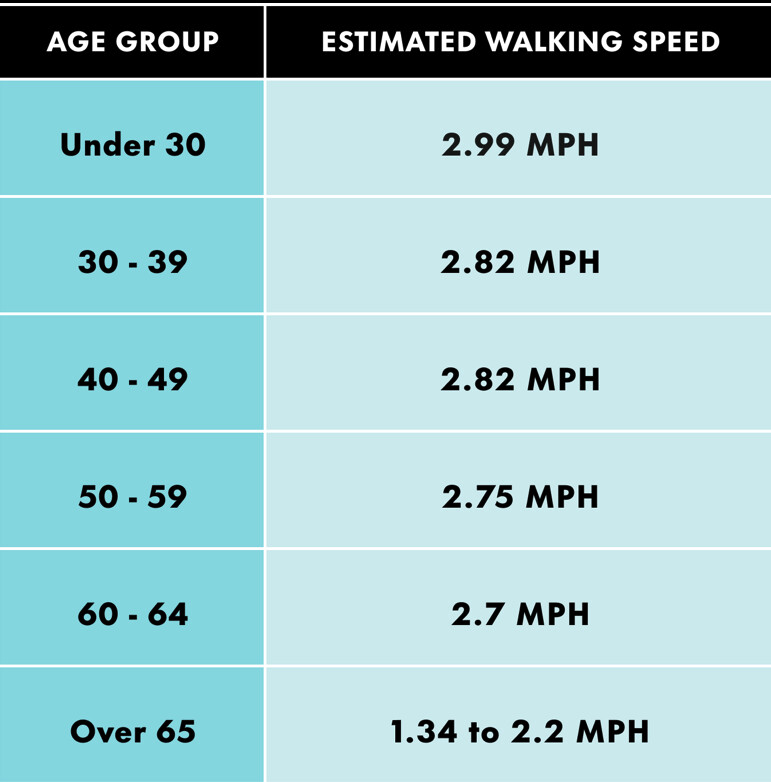
In fact, every 1,000 steps a person takes each day lowers their systolic blood pressure (the top number) by about 0.45 points—that’s a good thing, especially for your heart! The more you move, the more likely you are to lower your risk of chronic illness, like cardiovascular disease, and support your mental health.
Now, if you’re wondering how long it takes to walk 10,000 steps so you actually meet this goal, we got you! Here, two exercise physiologists explain how long it typically takes to cover 10,000 steps, depending on your average pace, so you can carve out time for your body and mind to clock more movement.
How long does it take to walk 10,000 steps?
For a person of average height (5-foot-3-inches for women and 5-foot-9-inches for men), a 2,000-step walk is about a mile, according to Laura A. Richardson, Ph.D., a clinical exercise physiologist and clinical associate professor at the University of Michigan School of Kinesiology.
This step count varies depending on the length of someone’s leg and the length of their stride, as well as their cadence. However, say it takes you 2,000 steps to cover one mile, and you walk at an average pace of about 20 minutes per mile, then it would take you about 100 minutes to walk 10,000 steps, Richardson explains Runner’s World. That’s one hour and 40 minutes.
Authors of a 2020 article published in Sustainability reviewed studies that examined walking habits in order to suggest ways to increase activity, and they came to a similar conclusion on timing. They found that healthy older adults typically average 100 steps per minute when moving at a moderate pace. This translates to about 100 minutes to clock 10,000 steps.
This will obviously change depending on your walking pace, though. If you walk a 15
The numbers change, of course, if you run some of those 10,000 steps, explains Rachelle Reed, Ph.D., an exercise physiologist, tells Runner’s World. Based on Strava, the average mile pace for American men is a 9:32 and 10:37 for American women. It would take those men about 47 minutes to take 10,000 steps and the women would need about 53 minutes to do the same.
How many calories do you burn per 10,000 steps?
To figure out how many calories you burn walking 10,000 steps, you need to know the metabolic equivalent rate (MET) for your exact pace. A MET is determined by multiplying the body’s oxygen consumption by bodyweight every minute. One MET is roughly equal to the amount of oxygen you consume at rest and is also equal to one calorie.
Following that equation, the National Academy of Sports Medicine says walking at a less than two miles per hour is equivalent to 2 METs per minute, which means someone who weights 150 pounds burns fewer than 140 calories per hour. Meanwhile, that same person walking at a brisk pace of approximately 3.5 miles per hour is equivalent to 4.5 METs, leading to a calorie burn of about 306 per hour.
Walking at a very brisk pace of four to six miles per hour is roughly equivalent to 5 METs, per the NASM. “It’s five times the amount of energy you need compared to rest,” Reed adds. Thus, you can burn around 340 calories per hour.
To put that in the context of 10,000 steps: Let’s say you walk about three miles per
How can you boost the benefits of your 10,000 steps?
To truly kick up the calorie burn, you have to change the intensity of your movement, which might mean adding in some running, walking at an incline on the treadmill, or walking up a hill, according to Richardson.
Reed suggests adding a weighted vest to your walks (or runs) a.k.a. rucking to increase the intensity level.
Finally, you may wonder if getting those steps on the treadmill is as beneficial as heading outside. There are pros and cons to both. “Pros of a treadmill are it’s easier to manipulate,” Reed says. “You can have complete control over the length of the intervals, the speed, and the incline much more easily there. But there’s also something to be said about getting your physical activity outside. There are additional mental benefits like stress relief and feeling more connected with your environment that people can gain from being active outside.”
Richardson agrees: “The nice thing about being outdoors is the sunlight, the fresh air, the different level terrain, depending on what type of surface someone’s walking on, that can engage different muscles,” she says. “So again, pros and cons to both. Really, choose
Login to leave a comment
Runners have gone wild in the current boom, increasingly hitting the trails and embracing ultra distances
that immerse us in nature, where mile splits matter far less than the experience of respondents to a 2024 Runner’s World survey have run an ultramarathon.
65%
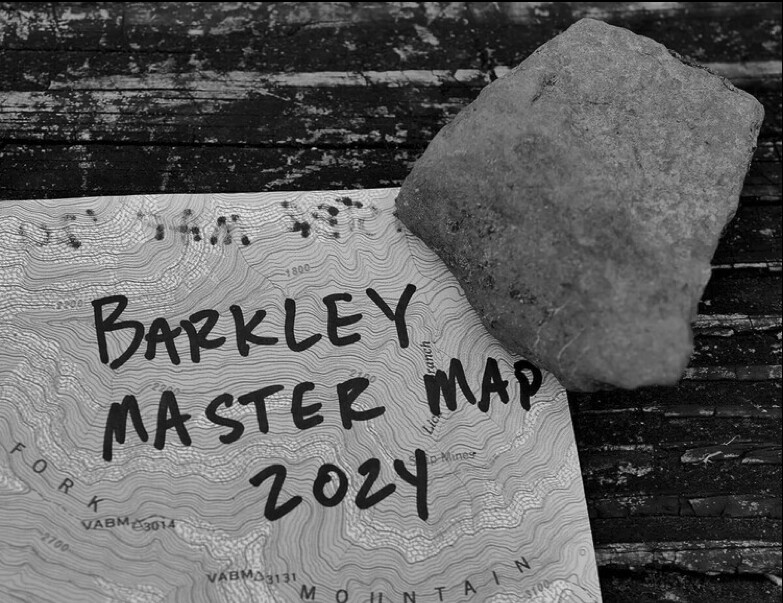
of those ran their first ultra in the past five years.
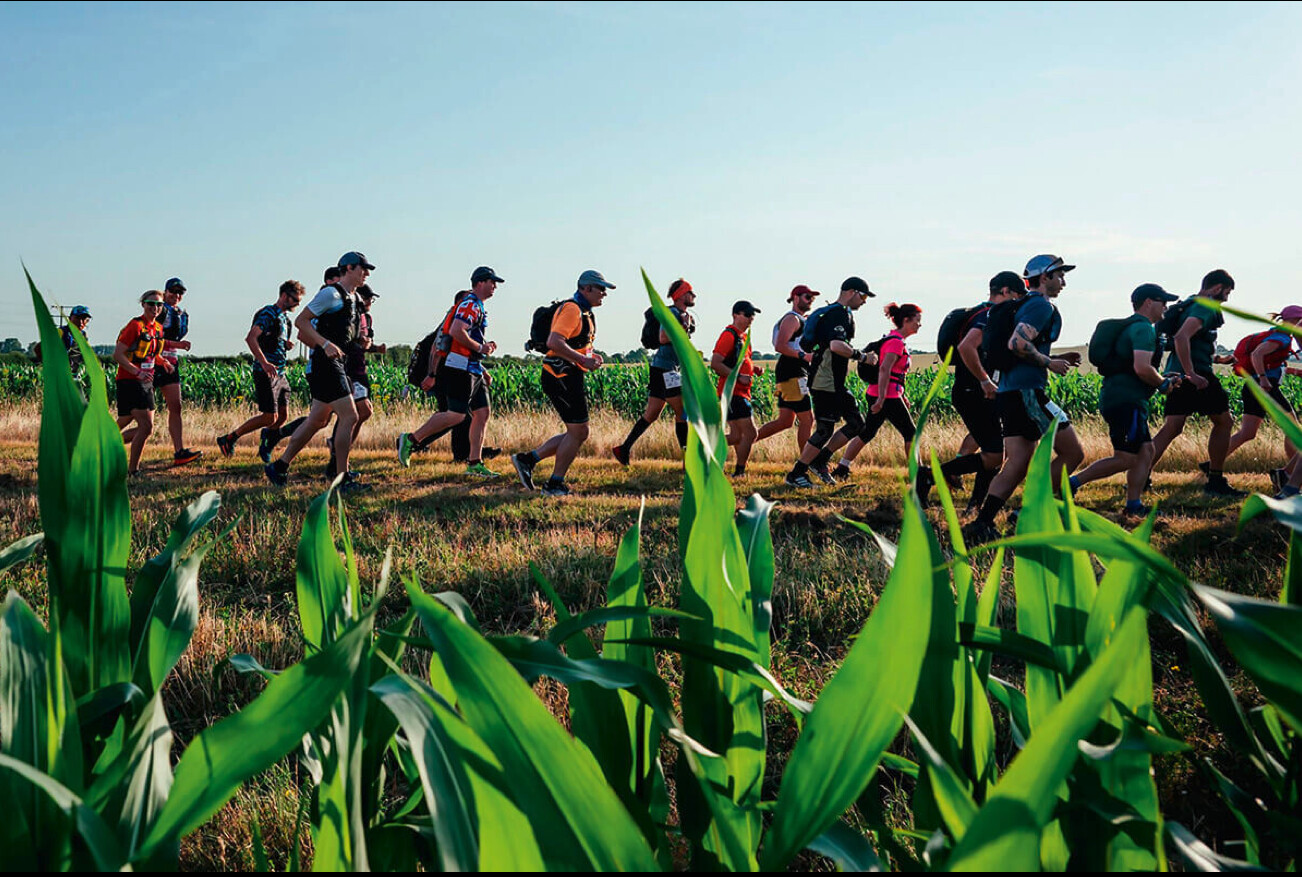
33%
said that they’re planning to run or considering running an ultra in the next two years.
‘It definitely feels more people are running trail and ultra, certainly post-Covid. The scene is really exciting with more races (and more accessible races), more brands, more sport-specific media, more younger, faster runners and more women – but they’re still a minority. Black Trail Runners and others are doing great work to make the scene more diverse. It’d be great to see more diversity, more accessibility and gender equality.’
Damian Hall, author and record-breaking ultrarunner236%
The year-on-year increase in internet searches for the Barkley Marathons from August 2023.
61%
of those surveyed by RW are interested or may be interested in following the big ultra races, such as the Barkley Marathons, Spine and Ultra-Trail du Mont-Blanc. 34%
This year’s increase in registrations for the Ultra-Trail du Mont-Blanc World Series Finals, compared with 2023. Demand is two to three times higher than max capacity.
43
Events in UTMB World Series in 2024, in Asia, Oceania, Europe, Africa and the Americas.
$7.3 billion
The value of the global trail running shoes market in 2022, according to a report by Allied Market Research. Up from $1.38bn in 2016, according to data from Grand View Research.
$12.4 billion
Predicted value of the global trail running shoes market in 2032, according to Allied Market Research.
30%
Year-on-year increase in numbers for the Montane Spine races. ‘The Montane Spine has expanded with more races within the events and more locations. We’ve had to organise other races to keep up with demand because the Montane Spine races continue to consistently sell out. We’re seeing people looking for ultramarathons to help with their mental health.’
Phil Hayday-Brown, founder of the Montane Spine Race
63%
The year-on-year increase in participants at Black To The Trails, with a waiting list operating for 2024’s sold-out event. 58% of runners were people of colour, with 14 of the 19 UK ethnic categories represented; 70% of participants were women.‘The Black Trail Runners community continues to grow daily with thousands of followers in the UK and globally, we’re a registered community and campaigning charity with the mission to increase the inclusion, participation and representation of people of Black ethnicity in trail running. If you want to see a more ethnically diverse sector, you can join us to help us do that – you don’t need to be of Black ethnicity to support the work that we do.’
Sabrina Pace-Humphreys, ultrarunner and co-founder of Black Trail Runners
5,252%
Growth in trail races with 500 or more participants in the 10 years leading up to 2022, according to RunRepeat. 11%
The year-on-year increase in runners on Strava completing at least one ultra, according to 2024 Strava data, growing at the same rate for men and women.
10% year-on-year increase in 50Ks.16% year-on-year increase in 50-milers. 14% year-on-year increase in 100Ks.
1,676% increase in ultra participation between 1996 and 2018, according to a recent report from RunRepeat, with numbers rising from just 34,401 to 611,098.
5,590 races
on the International Trail Runners Association calendar between January and August 2024: a 458% increase from the 1,002 races planned a decade ago.
49%
of respondents to the RW survey who run on trails started trail running within the past five years.
231%
Growth in trail running worldwide in the decade leading up to 2022, according to RunRepeat research. ‘All our events have been sell-outs the last couple of years. The Tolkien Trail Race sells out 500 entries in under an hour, and we’re noticing races fill up quicker and quicker each year. Trail racing has the least barriers to compete, with less emphasis on times than road racing, which can be intimidating. There’s an element of adventure, a test of endurance and the release of being in nature that’s evidently being enjoyed across ages and genders.’
Chris Holdsworth, race director for Pennine Trailsitting the trails and embracing ultra distances that immerse us in nature, where mile splits matter far less than the experience
Login to leave a comment
Kilian Jornet summits 82 Alpine peaks in 19 days
On Monday, Spain’s Kilian Jornet, four-time UTMB champion and a legend in ski mountaineering and climbing, completed his monumental mountain challenge to summit all 82 Alpine peaks over 4,000m high in only 19 days. Jornet shattered the previous Fastest Known Time (FKT) of 62 days, set in 2015 by Swiss alpinist Ueli Steck, who used a combination of cycling and paragliding.
Following his remarkable 10th victory at the Sierre-Zinal race (where he beat his own course record by a single second), Jornet embarked on a quest, dubbed “Alpine Connections,” to ascend as many of the 4,000-metre peaks in the Alps as possible, using only human-powered methods to travel between them. This endeavour seamlessly combined trail running, mountaineering, climbing and cycling.
In 2023, Jornet took on his toughest challenges yet, summiting all 177 peaks over 3,000 metres in the Pyrenees in just eight days. Reflecting on the feat at the time, he called it “one of the most difficult things I’ve ever done.” With the “Alpine Connections” project, Jornet pushed his limits even further as he continued to use only running or cycling between mountains, being careful to leave no trace that he was there.
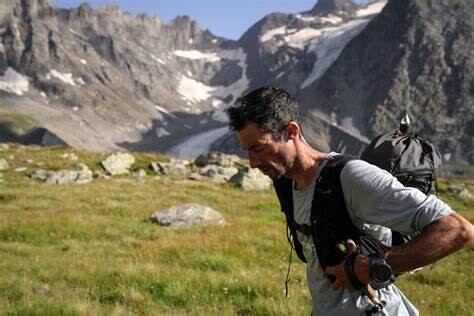
Jornet started his journey in the Bernina range of eastern Switzerland. In just a few days, he conquered 10 peaks, covering 423 km with a staggering 19,831m of elevation gain. The early stages of the challenge tested both his physical and mental endurance, and Jornet worked closely with scientists to track the physical and mental demands of his trek. He also provided daily recaps, stats and tracking on the Nnormal blog, Strava and @nnormal_official.
Jornet faced other, more humourous challenges during his journey: at one point, police threatened to tow his vehicle when work needed to be done on the parking lot he had left it in—2,500km away, and 4,000 metres below him.
Upon reaching the summits of Dôme and Barre des Écrins (the westernmost peaks in the series) on Instagram, Jornet shared his thoughts on Instagram. “This was, without any doubt, the most challenging thing I’ve ever done in my life, mentally, physically, and technically, but also maybe the most beautiful.”
“It’s difficult to process all my emotions just now, but this is a journey that I will never forget. It’s time for a bit of rest now.”
by Keeley Milne
Login to leave a comment
Rampaging Edmonton Marathon runner claims he was drugged with meth
On Sunday, Aug. 18, thousands of runners took to the streets for the 2024 Servus Edmonton Marathon, marking the largest event in the marathon’s 33-year history. However, the event was marred by a disturbing incident involving a University of Alberta student who was detained by police after allegedly assaulting other marathon runners at the 27 km mark. Days later, the student/runner shared his side of the story on Reddit, alleging that he was drugged with methamphetamine shortly after the race began.
The runner’s story

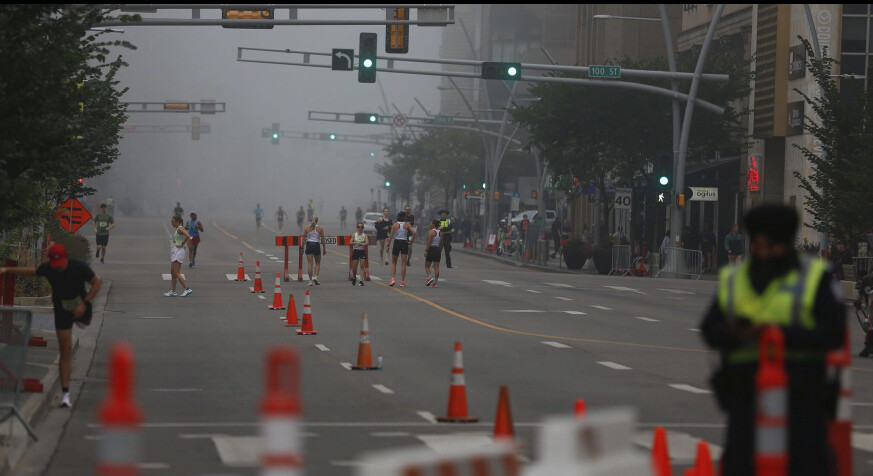
In a detailed statement, the runner recounted being low on sleep, anxious and rushed as he arrived late to the marathon. Just minutes into the race, he says he took water from what he thought was a legitimate water station. It was at this moment that he suspects he was drugged.
He described how his condition quickly deteriorated after consuming the drink. His stomach became uneasy, his heart rate spiked and breathing became difficult—symptoms highly unusual for someone running at his usual training pace. By the halfway point of the marathon, he recalls his memory fading. Data from his Strava activity indicated that his path grew erratic, and several witnesses later reported seeing him running shirtless, screaming and obstructing other participants.
The runner said he has no memory of these actions but vividly recalls the terror he felt as the police on the course detained him, resulting in physical injuries including cuts, a concussion and a sprained wrist. Race director Tom Keogh confirmed that the runner was detained about two and a half hours into the race, just after the 27 km mark. “Our medical team and police on-site responded quickly and appropriately,” Keogh said in an interview. “He appeared fine in post-race photographs and was even seen flashing a peace sign to the camera around the 10-kilometre mark [58 minutes into his race].”
The police report
The runner described his arrest experience as traumatic, involving a bag over his head, a cold concrete cell and wavering confusion. According to the Edmonton Police Service (EPS), he was released around 2 p.m. on Aug. 18, dazed and without a clear understanding of what had happened. He was then dropped off at his home. It wasn’t until the following day that he visited the hospital, where he claims he was informed that he had been drugged with methamphetamine.
EPS provided a detailed account of their interaction with the runner, explaining that they responded to multiple reports of a man behaving aggressively on the marathon route and assaulting other runners. Due to his erratic behaviour, which included spitting and kicking at the police cruiser windows, officers restrained him and applied a spit mask before transporting him to the Detainee Management Unit. The runner questioned why he was not assessed for drug intoxication at the time, the police believed his behaviour to be related to intoxication or mental health issues. No charges were laid.
EPS stated that they are continuing to investigate the reported assaults against other race participants, as one victim has filed a formal complaint. The EPS says they have not received any other reports of drugging along the race route. They also noted that there has been no evidence of a fraudulent water station, as claimed by the runner.
Keogh dismissed allegations of widespread drugging at the marathon, stating that other medical cases during the event were related to dehydration and heat, with no other suspected drug incidents reported. He encouraged the runner to file a formal complaint with the police if he wished to pursue the matter further.
Methamphetamine can have dangerous and unpredictable short-term mental and physical effects, which typically last eight hours but can sometimes extend up to 24 hours, depending on the method of consumption. According to Health Canada, the drug’s effects are felt within seconds if injected or smoked, and within 20 to 30 minutes if taken orally.
The runner’s motivation for posting his story on Reddit appears to be driven by a sense of bewilderment and embarrassment over his experience. Canadian Running has been in contact with the runner (who has not been named in this article due to privacy); he has not been able to verify any aspects of his account. “This has been one of the most frightening and dehumanizing experiences of my life. I’m deeply frustrated by the lack of support from the Edmonton Marathon organizers and the way the police treated me,” the runner says.
by Running Magazine
Login to leave a comment
Skeezy New Trend: Strava ‘Surrogates’ Are Making Money by Logging Runs for Other People
Want to make some money on your next run? An Indonesian teenager has found a lucrative way to do just that by, well, running for other people.
Wahyu Wicaksono, 17, has become what’s known in the country as a “Strava jockey,” logging running achievements for others on the app for a fee.
“I am active on X and it is booming there,” Wahya told Channel News Asia. He charges 10,000 rupiah (about 62 cents) per kilometer for running at a “Pace 4” (one kilometer in four minutes). For a more leisurely “Pace 8” (one kilometer in eight minutes), the fee is 5,000 rupiah per kilometer. Clients pay upfront, and Wahyu tracks his runs by logging in to the buyer’s account. elling data from runs or bike rides has gone viral in Indonesia. Another Strava jockey who spoke to CNA is 17-year-old Satria, who charges 5,000 rupiah per kilometer. “I have taken part in marathons before, so running is my hobby. I’ve got nothing to lose,” he told the outlet.
Except maybe his Strava account.
“Strava’s mission is to motivate people to live their best lives. Part of the platform’s magic comes from the authenticity of our global community in uploading an activity, giving kudos, or engaging in a club,” Linh Le, Strava’s director of corporate communications, told Runner’s World, adding that sharing accounts or credentials is a violation of the app’s terms of service. “This is important to safeguarding and respecting the progress and work of our athletes as they lace up every day.”
Strava has more than 100 million subscribers across 190 countries, but the publicized trend seems largely isolated to Indonesia for now. Still, with the ever-increasing desire for validation in the form of likes and other engagement, it doesn’t seem outside the realm of possibility that overworked runners desperate to “earn” that final segment might pay a fast neighborhood kid to crank out some miles on their behalf.
After all, as Strava’s motto goes, “If it’s not on Strava, it didn’t happen.” elling data from runs or bike rides has gone viral in Indonesia. Another Strava jockey who spoke to CNA is 17-year-old Satria, who charges 5,000 rupiah per kilometer. “I have taken part in marathons before, so running is my hobby. I’ve got nothing to lose,” he told the outlet.
Login to leave a comment
Experts Say You Should Ditch the Watch at Least Twice a Week and Run Based on Feel—Here’s Why
It’s time to incorporate more effort-based training into your schedule.Running is both an art and a science in many ways, and sometimes, you choose whether you want to lean into the former or the latter. Such is the case when running by feel (art) or pace (science).
Running by feel is also known as effort-based training or going by your rate of perceived exertion (RPE). “We define perceived exertion as your own subjective intensity of effort, strain, discomfort, or fatigue that you experience during exercise,” says Luke Haile, Ph.D., an associate professor in the Department of Health and Exercise Science at Commonwealth University of Pennsylvania. Your RPE is affected by numerous factors, from your emotional state to the weather to how well you slept the night before. “When you can understand it, it can really guide your training,” Haile says.
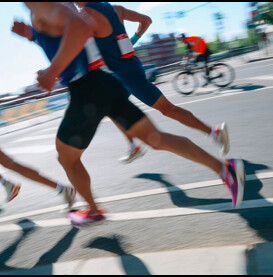
The easiest way to look at running by feel is on a scale of one to 10 (although some versions of RPE go up to 15 or 20), says Greg Laraia, a running coach at Motiv in New York City. One means you’re exercising with barely any effort at all while a 10 would be an all-out, can-barely-breathe effort. In practice, this looks like heading out to run at a six or seven for your easy runs (rather than at, say, 10-minute mile pace).
If you know your body and your paces well, you can also run by feel sans RPE scale and just going off what an eight-minute mile ~feels~ like, for example. Experienced runners can get so good at knowing how a particular pace feels to them that they don’t even need the feedback from tech—they can simply decide that they want to run eight-minute miles and, more or less, nail it.
But can ditching your watch and running by feel versus pace still get you to your goals? Read on to find out the pros and cons to both approaches, and how to know which is best for you. (Spoiler: Most likely, you’ll want to integrate a mix of both metrics!)
Pros of Running By Feel
“The real gift of running by feel is [that it’s] almost a mindfulness practice that, with training, allows you to feel how the body is in that moment and to take notice of how your feet feel, how your calves feel, down to your heart rate, breathing, noticing your sweating, and knowing what it feels like when you are at the right pace for a given goal,” says Haile.
The more in tune you get with your body and learn to listen to it, the more you learn when you have more to give to a run or when there’s something lurking under the surface, like an injury coming on, that isn’t allowing you to reach your full potential, Haile adds.
Because of this, running by feel can help reduce your risk of injury or burnout, says Laraia. If you have a “bad” day but your training plan says you need to run at a higher heart rate zone or a particular pace, you might push yourself to hit that and overdo it. But if you’re running by feel, you keep your pace and heart rate in check (because it feels challenging enough).
Cons of Running By Feel
For starters, running by feel may not be as accurate for novice runners: Haile and his team have conducted a number of experiments around RPE in both recreational and more experienced (not necessarily fast!) runners.
“We’ll put somebody through a VO2 max test and see how hard they can actually go, then see how well they can reproduce intensities that are around that [same] anaerobic threshold because that’s really where race pace often lies,” says Haile.
The verdict: The more experienced the runner, the better they tend to do at reproducing those same intensities. “To tell somebody that’s relatively inexperienced or beginner level to go out and sprint as hard as they can or run a 10 RPE, they might not run that hard,” says Laraia, because they don’t have context for what hard and really hard actually means. Four months later, it’s going to feel way different. (Still, he argues that this could be seen as a positive in some causes, because it shows there’s room for growth.)
Even for more experienced runners, though, accuracy varies. In one of Haile’s studies, published in the journal Perceptual Motor Skills, the 34 men involved in the research were less able to judge how hard they were actually working when running on a treadmill at relatively lower speeds and RPE, compared to working at a higher effort. Interestingly, “when intensity and RPE were higher, they had a finer perceptual acuity,” Haile says.
Another potential drawback is that it’s possible that running by feel can push runners too hard—or hold them back. “That’s where some of these other factors can come into play and cloud that mindful listening of the body,” says Haile.
For example, maybe you’re exceeding your goal pace (or heart rate) because of some external motivational factors—like trying to run faster that your Strava friends—that are at play and this leads to overreaching. Or maybe there are emotional things going on that are causing you to feel things a little bit more physically when it’s not necessarily a physical issue. “We’ve all been in a place where emotionally it is draining and [that] doesn’t allow us to achieve what our body is actually capable of doing,” Haile says.
Finally, running by feel is more difficult to quantify. “There’s no measurable data,” Laraia says. “If you were to write down your RPE on paper, everyone’s looks the same because it’s based off the sensation that you’re feeling.”
Pros of Running by Pace
If you have a goal in mind, like a time goal for a race that’s attainable—and that’s a key word here—you want to take a more scientific approach, per Laraia. That could mean using your watch to nail a specific pace during each of your training runs. Doing so will enable you to hit the proper pace you need to achieve your race-day goal time.
Practicing specific paces also allows you to test faster speeds and push your limits, which is important if your main goal is getting faster. If you’re running by feel all the time, it’s hard to see your progress in speed.
As mentioned, running by pace may be the better bet for runners with less experience as it helps them to learn how it feels to stick to various paces, which they can then riff off of later in their training journey. To do that, you still want to tune into how you feel on the run, but you’re examining that based on the pace your running (rather than vice versa). Cons of Running by Pace
The main issue with this approach is that it doesn’t take into account all those aforementioned factors that can affect how you feel—physically and mentally—on a particular day. A 8:30-per-mile pace may feel easy on some days and really, really hard on others.
“A lot of running, especially distance running, does come down to how you’re feeling mentally,” says Laraia, and he keeps this in mind when working with clients. “If they’re feeling great, by all means let’s go, but if they’re feeling shitty, I’m not going to force them to do a hard effort.”
Again, pushing to hit a certain pace despite not feeling truly up for it can lead to injury and/or burnout. Take the long slow distance run for example: These efforts are meant to feel easy and should be done at a lower heart rate. If you’re trying to keep up with a specific pace, despite that pace actually feeling difficult, then you won’t gain the benefits of those long zone 2 efforts.
Second, running by pace may drive runners to pursue unrealistic race goal times. With running by feel, you may realize that your original goal pace/finish time is too ambitious, and you can adjust accordingly.
Pace vs Feel: How to Determine Which Metric Is Right for You
Everyone could probably benefit from running one or two runs per week by feel, based on all the above benefits! But just how much you lean into this artful approach depends on:
If you’re training for a race, whether it’s a 5K or a marathon, and have a particular time goal in mind, you’ll likely benefit from running most of your training runs by pace. And on race day, this becomes more important the longer the race is: “Sticking with pace early on especially is important when you don’t want to overdo it and then have nothing left or underdo it and then you have some left in the tank when the finish line’s already crossed,” Haile says. “Sometimes it seems that letting pace guide you early and then letting feel guide you later is something that works really well for runners.”
If you’re a new runner, it would be wise to opt for running by pace until you have enough runs under their belt to truly understand what various paces and efforts feel like. This is especially true if you eventually want to sign up for a race.
If you’re more experienced and/or aren’t training for a race (or don’t have a firm race-day goal), you may want to consider adding more runs by feel into your routine to benefit from the mindfulness aspect.
Another option to add to the mix beyond running by pace versus feel would be to run based on your heart rate zones: Run your easy run at a low heart rate and your hard days in higher heart rate zones with your long runs in those middle ranges, Laraia explains. This somewhat straddles the line between running by pace and by feel as it’s more objective than the latter but more forgiving than the former. Tips for Running by Feel
Running by feel is a skill that you can improve. Haile suggests scheduling a couple of runs by feel per week, one easier and one harder, and during those sessions, pay extra attention to the different parts of your body and how you truly feel. You can’t know if a certain pace feels right, if you don’t really know what “right” is, after all.
“When you’re really noticing it and feeling it (‘oh, that feels too fast’ or ‘this is too slow’) beyond whatever the [watch] is telling you, you can listen into your body and know that this is what is right [in this moment] given this heat or humidity or maybe this nice cool evening,” says Haile.
Laraia also suggests taking some notes in a training journal after each run by feel. Consider how you felt at the start, middle, and end of the run and jot that down. You could then look at your watch data (even if you did not look during the run) to get a little more science- and data-driven and see where your heart rate was during each of those runs and cross-reference that with how you felt, per Laraia. Maybe mentally you felt great but your heart rate was a little elevated (for you). Having these little self check-ins is a good way to help make running by feel more accurate, Laraia explains.
“The biggest thing is just keeping in mind that it is just another tool in your toolbox versus an end-all be-all,” says Laraia. “It’s safe and it’s relatively reliable because it’s based on you, the person actually training or using it, which is great. The more time you practice and check in with yourself and either write it down or provide feedback to a coach, the better off you’ll be using it.”
by Runner’s World
Login to leave a comment
How Long Does It Take to Run a Mile?
Knowing the average pace can help you set new goals.
The best way to find your average running speed is by tracking your mile pace.
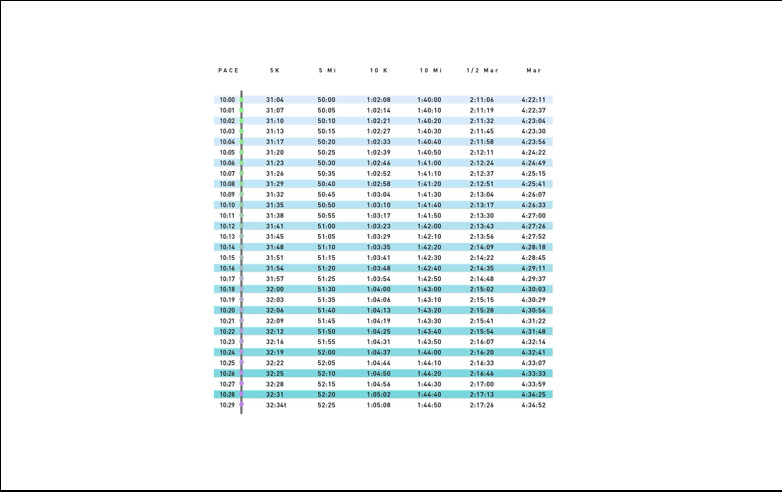
For example, say you go out for a three-mile race. You might start off running fast because of an adrenaline rush, then slow down once you realize you’re running too hard. But toward the end, when the finish is in sight you might catch a second wind and pick up speed again. This all results in different mile times.
Your average mile time, which will be the sum of all your mile times divided by the number of miles completed, may look different than each individual mile. The more you train, not only will your average mile pace drop, but each individual mile time will likely become closer in time to the others.
That’s why tracking your average mile time is a great way to monitor your progress. Plus, when you reach a new barrier—like the first time you run faster than a 10-minute mile, for example—it allows you to search out new goals in your running journey and also scope out your competition.
How long does it take to run a mile on average?
Based on real-life data from all public uploads to Strava from August 1 2022 to July 30 2023, the average mile time across the globe is 10 minutes and 25 seconds (10:25). That number adjusts based on gender: 10:02 for men and 11:17 for women. In the U.S., the average running speed is 9:54 and breaks down to a 9:32 mile pace for U.S. men and 10:37 for U.S. women.
These paces have changed since 2018 when the average global mile pace hit 9:48 and U.S. pace averaged 9:44.
Don’t fret if your current average time is a little off from those marks. Keep in mind that, while sizable, the dedicated Strava community doesn’t represent the entire running community.
What factors affect average running speed?
The following factors play a big role in every runner’s mile speed:
Gender
Age
Weather/wind
Nutrition and hydration
Injuries
Height
Weight
Terrain
The list could go on. Even what you think about or your mindset can affect how fast you run, and that’s under your control. Other factors, however—such as height and age—are things you obviously can’t change.
Also, according to recent number crunching at Runner’s World, based on data from platforms like MapMyRun, even the type of year you’re having has an effect on one’s average mile time and pace. From mid-April to mid-September—during the start and midpoint of the coronavirus pandemic—the average mile pace recorded was 8.5 percent slower compared with the same range in 2019, which the MapMyRun team attributes to a new or returning runner effect.
When it comes to age, one data analysis performed in 2010 and based on 10,000 U.S. runners who completed a 5K showed the average minutes per mile for runners of different ages. The average overall was 11:47 per mile. Men in the 16- to 19-year-old age range finished the run with an average pace of 9:34; women in the same age group finished in 12:09. The numbers gradually increased as the age groups got older.
In most cases, though, the gaps between the finishing times of the different age groups weren’t drastic. And you might not necessarily get slower with age. As Runner’s World has reported, many pro runners and average runners peak in their 30s, and even runners in their 70s can keep getting better with age.
Because of the many variables associated with running pace, it can be difficult to establish an across-the-board average running speed.
How fast should you run a race?
If you’re looking to find out what your average running pace should be to hit a specific time goal in a race, you’re in luck. Our Runner’s World Pace Charts (in both minutes per mile and kilometer) show what time a given pace will produce for six common race distances: 5K, 5 miles, 10K, 10 miles, half marathon, and marathon. As an example in the chart below, if you want to run under 1 hour and 45 minutes for a 10-mile race, you’d need to have an average pace of 10 minutes and 29 seconds per mile to accomplish your goal.
Use our charts as a reference point after you start training so you can know what average pace is necessary (and realistic) for your upcoming goal race.
How can you boost your average running speed?
If you want your average running pace to be faster, there are several steps you can take to improve, like figuring out how to breathe properly and mixing up your types of runs. You should also recognize the importance of nutrition and hydration.
Adopt a holistic approach to your training, doing regular conditioning workouts to improve your strength and flexibility in addition to running, as a stronger, mobile body can help you run faster and avoid injury.
What’s the fastest ever mile speed?
The fastest mile ever recorded was set by Hicham El Guerrouj, a Moroccan runner who ran a mile in 3:43.13 in 1999. Guerrouj was 24 years old at the time.
For women, the fastest mile ever was run by Faith Kipyegon, which she snagged just this month, with a time of 4:07.64.
If you’re looking for the fastest average running paces over the course of 26.2 miles, look no further than the world record holders in the marathon—Eliud Kipchoge (4:37.2 per mile) and Brigid Kosgei (5:06.8 per mile).
And just for fun, if Usain Bolt were to ever keep his jaw-dropping sprint going for a full mile at his peak ability, the Jamaican’s top speed in 2009 during his 9.58 world record 100-meter dash would have put him just over 27 miles per hour.
by Runner’s World
Login to leave a comment
There Are Going to Be People Walking:’ A Look at the Grueling Olympic Marathon Course
Getting to run by all those historic spots requires some epic climbs and descents.The final weekend of the 2024 Paris Olympics will host back-to-back days of thrilling marathons. These prestigious races, set against the backdrop of two of France’s most iconic landscapes—Paris and Versailles—will weave through a tapestry of history, culture, and breathtaking scenery. They begin on August 10 with the men’s race, and then, in a nod to the 40th anniversary of the first women’s Olympic Marathon in Los Angeles, the Paris Olympics will conclude on August 11 with the women’s race for the first time in history.
Here are some of the key details you’ll want to know:
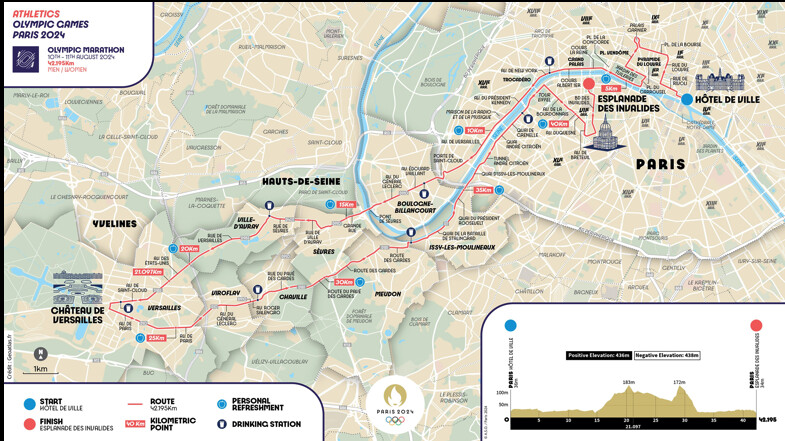
What sites will the runners pass?
It’s not a bad way to tour the area, and it’s quite different than the Paris Marathon that is held each April. Athletes will find themselves tracing a route that dances through nine arrondissements (neighborhoods) of Paris along the banks of the Seine. The runners will begin at the Hôtel de Ville, or city hall, and then pass landmarks such as the Palais Garnier opera house, Place Vendôme, the Louvre museum, and past the Trocadéro.
Next, they will leave the city to run through historic French towns, including Sevres, on their way to Versailles. The return to the city is a different route and will take them through the Forêt Domaniale de Meudon, a forest. When back in the city, they will be on the Left Bank and run past the Eiffel Tower as well as Parisian neighborhoods. The race ends at the Esplanade des Invalides, in which Napoleon is buried.
This route is based on significant French history. In October 1789, between 6,000 and 7,000 Parisian women, joined by men, marched from the Hôtel de Ville through the city to Versailles. It was because of that march that Louis XVI agreed to ratify the Universal Declaration of the Rights of Man and Citizens. The marathoners are symbolically running in their footsteps.
How tough is the course?
Unlike some more recent Olympics and U.S. Marathon Trials races, this course isn’t a circuit of repeated loops. Instead, it’s a full loop starting in Paris and loops down to Versailles outside of the city.
While the elevation profile for the first nine miles looks fairly tame, once the runners are past the halfway mark the landscape changes. The most notable course feature is the three uphill stretches—they’re incredibly steep and very long.
The first big hill comes just before the 10-mile mark, and it climbs at a 4 percent grade, which is roughly the same as Boston’s famed Newton hills. The difference with the Paris version is that it ascends for about 1.25 miles before it levels off for a bit. (Boston’s longest hill is less than half a mile, according to Sean Hartnett, emeritus professor of geography at the University of Wisconsin-Eau Claire, who specializes in marathon routes and other running competitions.)
The next hill at the 12-mile mark is at 5 percent, steeper than anything on the Boston course and 900 meters long. But those two are just appetizers for the real challenge. That hits just after the 18-mile mark.
Runners will have to climb for 600 meters, at an average grade of 10.5 percent. Yes, picture putting your treadmill at 10 percent and trying to run up it at marathon pace. Hartnett calls it a “doozy” and struggles to find courses to compare it to. The Bix 7 in Davenport, Iowa, perhaps? Then he gives up. “It’s unlike anything in any competitive road marathon,” he said. (You can view a detailed description of the 15K-33K section as mapped by Hartnett here.)
In total, the route will include 1,430 feet of elevation gain. Possibly more challenging is the 1,437 feet of descent. The make-or-break point for the route might be just after that final brutal uphill, when they are bombing downhill—at some points at a gradient of 13.5 percent. Runners will have to be efficient going down, without pounding so much they trash their quads before the final flat stretch before the finish. To put the course into some more perspective, the World Marathon Majors that are considered the hilliest—Boston and New York City—each have an elevation gain of a little over 800 total feet. And for one final nugget, the average grade of the Mount Washington Auto Road Race is 12 percent. The course record for that 7.4-miler is at around 8:00 pace.
This course will make the fastest marathoners in the world look almost human at times.
How do the marathoners feel about the course?
Pat Tiernan, an Olympian for Australia who is running the marathon, made two trips to Paris from his training base with Puma in North Carolina to examine the course. His first trip, in early April, was just to get a feel for the course. The second, in late May, was to train on it.
“The first thing you notice,” Tiernan said in a phone call with Runner’s World, “is that it’s going to be a brutal course. There are going to be people walking.”
If you look closely at the official Strava route, you can spot some U.S. Olympic marathoners on the leaderboards of the course’s toughest segments.
On April 10, U.S. team member Clayton Young did a 12.80-mile run on the hilliest section of the course, where he “pushed the uphills, chilled the downhills.” During the steepest climb—right before the mile 18 split—Young tackled a .44-mile segment in 3:09, giving him a modest average pace (for a world-class marathoner) of 7:01 per mile. But if you look at Strava’s “grade adjusted pace,” which factors in elevation, that 7:01 converts to 5:03 mile pace. His average heart rate was 179 beats per minute.
Dakotah Lindwurm, a U.S. team member for the women, also previewed the course in April in a run she called, “Tour de La Olympic hills ?].” She racked up an impressive 16 “course records” during her 10.87-mile workout, and on the same steep segment that Young ran, she averaged 7:43 pace with a grade-adjusted pace of 5:21 per mile.
Emily Sisson, the U.S. record holder in the marathon, has been training for both the hills and the flats. “We’ve been doing a lot of stuff on hills, because [we] want to come out of the hills into the last 10K feeling good,” she says. “That’s also why you don’t want to slack on 10K work, because it could be quite fast at the end. So kind of trying to do it all.”
Tiernan agreed with Sisson on the unique challenge. If marathoners go too hard through the hills, they could struggle at the end, he said. If they go too easy through the hills and subsequent descents, they might be out of touch by the final 10K. He said the Paris course is as “if you were to do a 10K road race, then go and run a hard 10K hill cross country course, then a 10K road race.”
If nothing else, it could make for some surprises on the podium.
When exactly are the races?
The men’s event happens on Saturday, August 10. If you want to watch live, get your favorite espresso ready. The event begins at 2 a.m. ET/11 p.m. PT in the U.S. The following day for the women’s race, the 2024 Paris Olympics fully conclude in honor of the 40th anniversary of the first women’s Olympic marathon event, won by Joan Benoit-Samuelson. The start time is also at 2 a.m. ET/11 p.m. PT.
Who are the major names in each race?
Both races are packed with star power in the form of returning Olympic champions, world record holders, and World Marathon Majors winners. The biggest storyline in the men’s race is whether Eliud Kipchoge, the two-time Olympic marathon gold medalist who many consider to be the greatest of all time, will be able to retain his crown in what may be his final Olympics at age 39.
The women’s event is even more stacked and should make for quite the event to cap off the 2024 Olympics. Newly ratified world record holder Tigist Assefa of Ethiopia will have to match speed and strategy against the likes of Hellen Obiri and Peres Jepchirchir of Kenya and the Netherlands’s Sifan Hassan, who is running the marathon after racing in the 5,000 and 10,000 meters on the track.
Men’s Marathon Contenders
Eliud Kipchoge, Kenya (2:01:09)
Kenenisa Bekele, Ethiopia (2:01:41)
Benson Kipruto, Kenya (2:02:16)
Tamirat Tola, Ethiopia (2:03:39)
Conner Mantz, USA (2:07:47)
Clayton Young, USA (2:08:00)
Women’s Marathon Contenders
Tigist Assefa, Ethiopia (2:11:53)
Sifan Hassan, Netherlands (2:13:44)
Peres Jepchirchir, Kenya (2:16:16)
Emily Sisson, USA (2:18:29)
Hellen Obiri, Kenya (2:21:38)
Rose Chelimo, Bahrain (2:22:51)
Fiona O’Keeffe, USA (2:22:10)
Sharon Lokedi, Kenya (2:22:45)
Did you know there is a mass participation race?
If not, now you do. It’s called the Marathon Pour Tous, and we’re pretty jealous we can’t run this one. There will be a full marathon and a 10K on the same route as the Olympic marathon on the evening of August 10. Yes, a night race in the City of Lights. More than 20,000 participants are expected for each event.
by Runner’s World
Login to leave a comment
Strava denies Canadian marathon record holder a pro athlete account
Canada’s Natasha Wodak has had an impressive career on both the track and the roads, and is considered one of the country’s greatest-ever female distance runners. She has represented Canada at two Olympic Games and holds the national marathon record of 2:23:12. Despite her achievements, the fitness tracking app Strava does not seem to recognize their significance; it denied her a pro athlete subscription for 2024.
“I am not sure what hurts more, not making the Canadian Olympic team or getting rejected by Strava for my PRO badge renewal,” Wodak wrote on her Instagram.
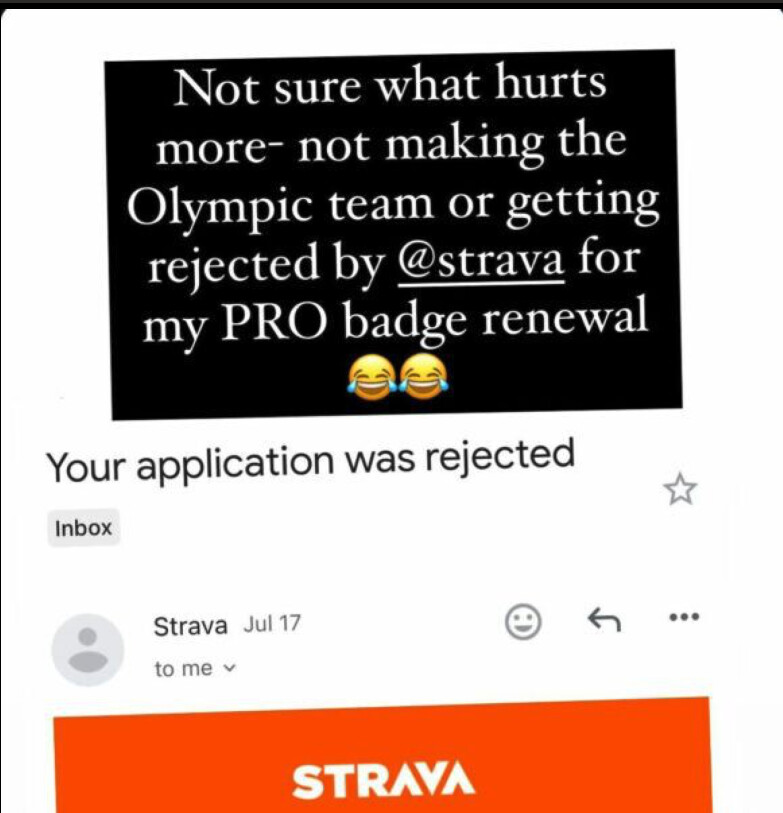
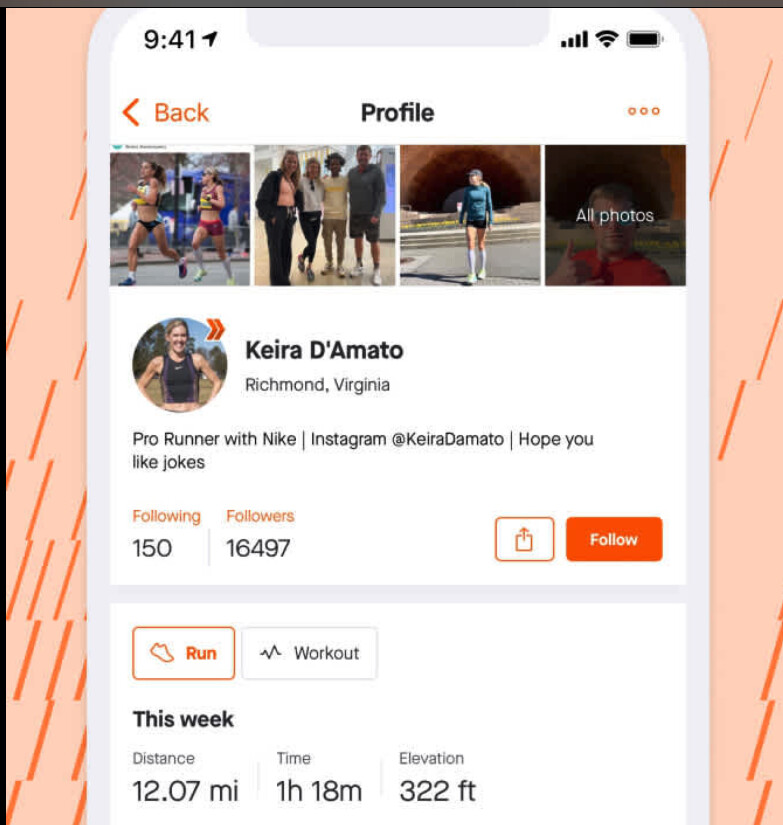
A Strava Pro Athlete and Verified Badge offers several benefits, including exclusive features on Strava, such as advanced analytics, performance insights and the ability to create and share custom challenges or events for free. Pro athletes are highlighted on Strava, making it easier for fans and followers to find and follow them. The badge exists to recognize public figures, noteworthy community builders and influential individuals around the world.
According to Strava, for a professional runner to be approved for a pro athlete badge, they must have achieved a World Athletics entry standard in the past 18 months or placed in the top five at a national championship (e.g. USA Track & Field or Athletics Canada). An athlete must also provide proof of financial compensation for training and athletic endeavours, whether through a travel stipend, training cost stipend or salary from notable sponsors (e.g. Brooks, Asics, Nike).
In Wodak’s case, she meets both of these verification criteria, which is why the rejection email came as a shock. She qualified and competed for Canada at the 2023 World Athletics Championships in Budapest in the women’s marathon and has won three Canadian national titles in the last 18 months. Additionally, she receives financial compensation through a professional (salary-based) contract with Asics Canada.
Wodak took three shots at making the Canadian marathon team for Paris 2024, but came up just a few minutes short of the women’s marathon standard of 2:26:50.
Strava’s pro-athlete community includes more than 2,300 athletes from 195 countries. This status not only recognizes them as professional athletes, but also provides them with a complimentary Strava subscription and access to a community of active followers.
Login to leave a comment
Western Quebec police seek to identify nude runner doing late-night hill repeats
A small community in western Quebec is grappling with a mystery as they aim to identify a nude runner caught on camera during a late-night jog in Val-des-Monts, Que., earlier this month.
According to a police report, the owner of a Val-des-Monts business discovered security footage showing someone running naked across his property on June 8 around 1:30 a.m. The video footage captures the man running up and down a gravel hill on private property before making a gesture to the surveillance camera and running off.
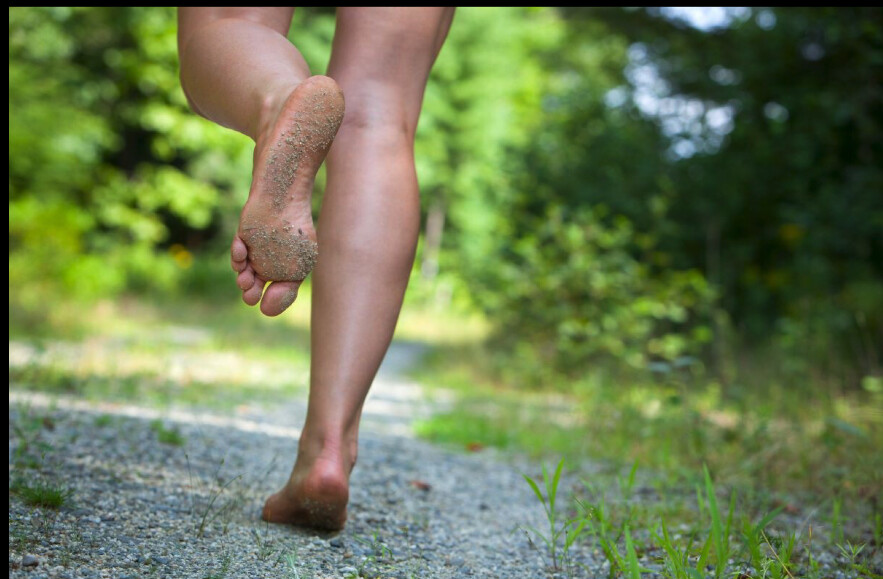
CTV News Ottawa reported that this was not the first incident of a late-night streaker in Val-des-Monts in the past two years. Local police believe the runner is somehow linked to Tenpenny Road Industrial Park, where he was spotted on surveillance footage.

“While the nudist runner may be funny to some people, the whole thing remains a criminal offense and is punishable by one or more statements of offense,” said MRC des Collines-de-l’Outaouais authorities to CTV News Ottawa.
In the video, the caucasian male appeared to be completely nude, not even wearing shoes, which would be quite uncomfortable when running on small stones. A quick Strava investigation to see if there were any nearby running KOM segments the streaker might have been targeting yielded no results.
The police have asked members of the public who may recognize or have any information about this naked runner to contact authorities at 819-459-2422, ext. 3262.
Login to leave a comment
David Rudisha names 3 key athletes to shape 800m race this Olympic season
World 800m record holder David Rudisha has revealed the three key athletes who will shape the two-lap race this Olympic season and might even threaten his world record.
World 800m record holder David Rudisha has singled out three athletes that could shape the 800m at the Paris 2024 Olympic Games and beyond.
Rudisha was an 800m maestro and defined the two-lap race in his prime and he believes other athletes are coming up and have the ability to change the quality of the 800m race.

The two-time Olympic champion set his first 800m World Record of 1:41.09 on August 22, 2010 in Berlin, Germany before lowering his time to clock another world record of 1:40.91 set during the 2012 London Olympic Games.
No athlete has gotten near to the world record but the two-time world champion believes the trio of Emmanuel Wanyonyi, Marco Arop and Djamel Sedjati have the ability to redefine that.
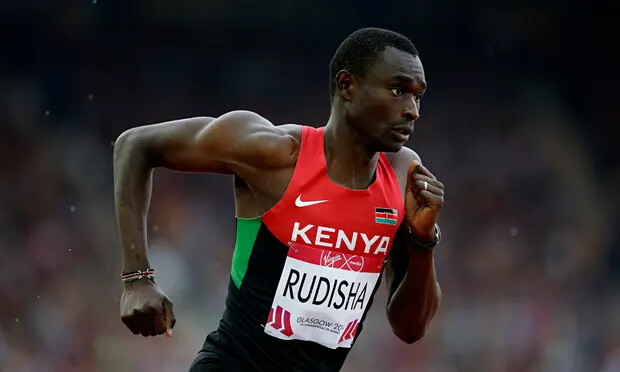
“From Kenya, we have Emmanuel Wanyonyi. Marco Arop from Canada. And I saw also a young kid Djamel Sedjati from Algeria running the world-leading time in Ostrava,” Rudisha told AFP.
“This is really amazing. We are looking forward to seeing how they are going to perform. In the Olympics, anything can happen. It's always very competitive and everybody goes there to win. So, there's a lot of expectation.”
Wanyonyi, the youngest of the three, has been in great form this season, and he will certainly be an athlete to watch in the city of love.
The world 800m silver medallist has been unbeaten in the 800m this season, winning the Kip Keino Classic and the Diamond League Meeting in Rabat, Morocco. He also set the road mile world record at the Adizero road to records event.
Meanwhile, Arop, the reigning world champion, has only raced once in the 800m outdoor and won in the Diamond League Meeting in Xiamen. He has been in great form, however, in his indoor events and will certainly be out to give his competitors a run for their money one more time.
Sedjati, 25, has also proven to be a strong athlete, striking with a world leading time of 1:43.51 in Ostrava in his season opener. He will also be looking to impress at the Paris 2024 Olympic Games, following his silver medal at the 2022 World Championships in Eugene, Oregon.
by Abigael Wuafula
Login to leave a comment
Why women-only run clubs are dominating the scene
Amid 2024’s run-mania, with races frequently selling out across Canada, female-exclusive run clubs are gaining momentum. In honour of Sexual Assault Awareness Month, we’re discussing how the sport has evolved, with women’s run clubs paving the way for female runners to feel seen, safe and empowered.
Run clubs are in
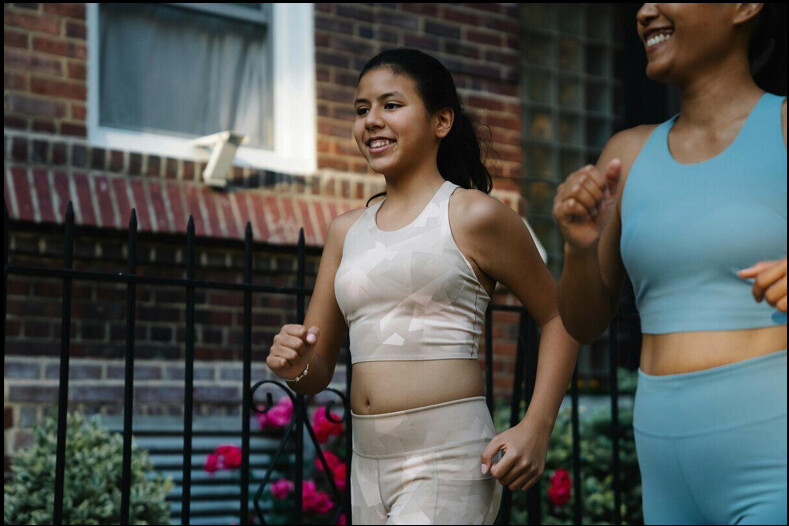

Women’s running has been on the rise since the ’70s, when recreational jogging first became popular. However, the recent surge in gender-exclusive running clubs is a significant development. According to Reddit, this is not just a passing trend. Women’s run clubs have become especially attractive to women who’ve experienced gender-based discrimination or sexual harassment in mixed-gender clubs.“As a woman that has participated in many mixed-company athletic pursuits, [I feel that] men often react poorly to women being skilled or successful in a sport, in addition to the usual perils of being harassed or bothered,” said one Reddit user. Another pointed out that “this obnoxious masculinity is woven into the history of run clubs.”
Confronting patriarchy
Running, like many other sports, was designed by men for men. Women in France began challenging this norm in 1903 with a race in Paris known as “The Race of the Midinettes” (a 12-km walking race for seamstresses or assistants in the Paris fashion industry). While the French press called these midinettes derogatory names like “streetwalkers” (sex workers), feminist scholars such as Florys Castan-Vicenet (in her 2023 report in Front Sports Act Living) strongly argue otherwise, considering them pioneers. Amsterdam’s 1928 Olympic Games marked a revolutionary moment in women’s running. For the first time, female runners were invited to participate in the 800m. This feat was short-lived however, as the event was immediately banned, and would remain so until 1960. In 1967, Kathrine Switzer became the first woman to run the Boston Marathon with an official bib (though she was physically assaulted by the race manager for doing so).
“Female runners were spearheading a revolution, changing common beliefs about the limits of women’s physical endurance,” shared Louise Wood in her story “Into the Boys’ Club”. By the turn of the 21st century, feminist movements were changing the landscape of women’s running.
Women supporting women
During this time, feminist thinkers like Sara Ahmed confronted topics like gender inequity and female objectification that commonly deterred women from joining the sport. “What I hate is, for example when someone comments on your run,” wrote Ahmed in her 2000 novel Strange Encounters. “They mean it as a compliment, but for me, it just emphasizes, ‘I don’t expect this from someone who looks like you.'” As female runners and feminists continued to reshape the narrative, gender-exclusive run clubs emerged, reflecting a significant rise in women’s participation in running. A report by International Journal of Environmental Research and Public Health says between 1953 and 2017, sex differences decreased dramatically in 100-mile ultras worldwide. By 2020, according to RunRpeat, 57 per cent of Canadian runners and 23 per cent of ultramarathon participants identified as female, marking a significant increase.
Strength in numbers
Today, women are choosing to forgo late nights on the town for a good night’s sleep and morning run club with the girls. These clubs are not just about running; they are about women sprinting together through life’s challenges, forming strong bonds and a sense of community that extends beyond the club. Women-only run clubs across Canada, such as Switzer’s 261 Fearless (which has chapters in 14 countries; the Canadian chapter is in Toronto), and runs celebrating women, like Lululemon’s Further 6-day ultra (based in Vancouver), are surging in popularity. Still, in a 2023 study by Adidas, it was reported that 38 per cent of women have experienced physical or verbal harassment while running, with more than half receiving unwanted attention (56 per cent), sexist comments or unwanted sexual attention (55 per cent). According to a 2024 study by Asics, a startling number of Canadian women have cited “lack of safe spaces” as a barrier to running.
Chix Run (located in Toronto and Calgary) has been dedicated to offering women this safe space. Since founding the club four years ago, Amanda Richardson, 42, has observed a significant improvement in the sport’s female representation. “Toronto run clubs used to be focused just on performance, but now it’s all about community, where women are out there connecting on topics like motherhood, marriage or their love of coffee—a post-run highlight.”
The club strives to take the emphasis off competing and winning to make running more about having fun, being active with other women and creating friendships. “Many people have noticed running is advertised as a place to date,” Richardson laughs. “Turning up to a running club where you know it’s all women there, free to say what you want to say, be who you want to be, they don’t have to worry about how they look; there is no hidden agenda.”
Girlhood and good vibes
According to Strava, women under 25 are the fastest-growing community using the app today, promising a more balanced and inclusive future for running. The Girls run the 6ix run club has quickly become a regular hotspot for young female runners in Toronto. The club was founded in December by Jill Amirault, 26, and Claire Milburn, 23, and already has 5,000 Instagram followers.“I think for someone new to running, it can be really intimidating to go to a gender-diverse run club, because men are typically competitive,” says Amirault. “Some women need that safe space, similar to a gym with a ‘women only’ section.” The club embarks once a week on a 6-km route through the city, in which its members can be found swapping stories about dating misadventures and connecting about girlhood. For a long time, there was a lack of female-exclusive run clubs in Toronto, says Amirault.
“Now, with more female run clubs and influencers, people are certainly beginning to notice that this is an environment where women can succeed,” says Amirault. “Pace doesn’t matter; what’s important is that we motivate, connect and celebrate our womanhood.”
by Running Magazine
Login to leave a comment
How to Use Running to Overcome Your Anxiety, According to Experts
If you have running anxiety instead of finding relief in the movement, here’s why and how to change that.
I learned that I suffer from anxiety when, some 10 years ago at the age of 20, I checked myself into a hospital for what I was convinced was an impending heart attack. My chest felt tight, my breathing rapid, my head spinning, arms tingling. I couldn’t think straight. After a series of tests, the ER doctor told me that physically, I was healthy. Then he gently suggested what I’d just experienced may have been a panic attack.
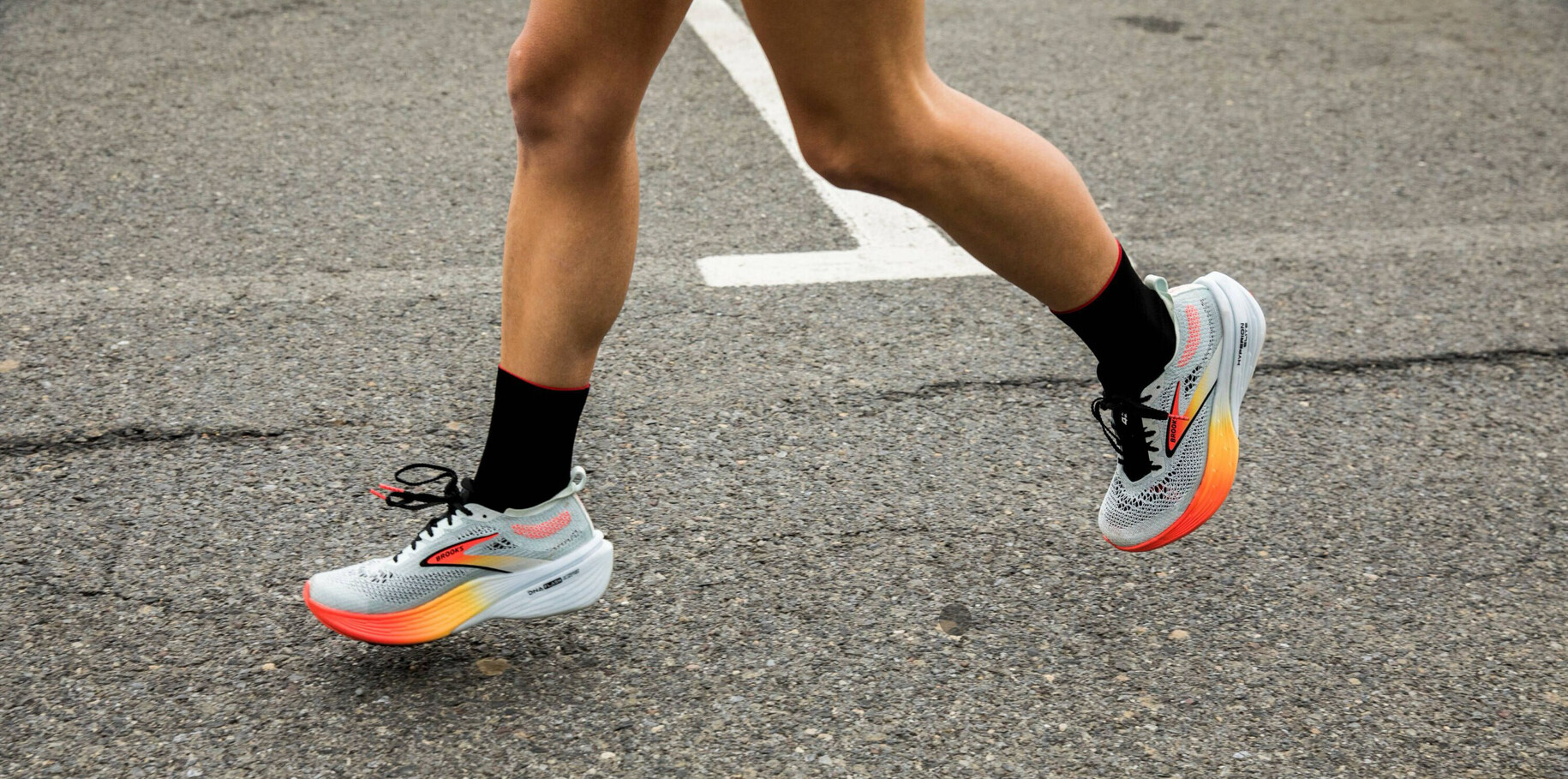
That a mental state could manifest itself as physical symptoms was a complete revelation to me. I’d experienced a variety of them before (usually attributing them to post-illness recovery or environmental reactions) but not at this magnitude. To help treat my anxiety, among other things, he recommended aerobic exercise. Because of its low barrier to entry, I turned to running.
My controlled treadmill runs went fine, but the moment I ran outside, it took a mere few minutes before a wave of tension washed over my body, leading to the symptoms I knew so intimately: shortness of breath, a fast-beating heart, sweating. Running made me more anxious, I figured. I tossed the idea—together with my running shoes—in the corner, and that was where my short-lived running venture ended.
It would take years for me to lace up my running sneakers again. I had to learn about how to get into running gradually and pace myself, along with accepting that I can walk when I need to. Now, running helps me manage my anxiety in ways I’d never expect.
After talking to other runners and psychologists, I learned that my situation isn’t unique. So with the help of experts, we’re sharing tips on how to make running work for your anxiety, alleviating your symptoms instead of exacerbating it.
What is anxiety?
Anxiety is the world’s most common mental health disorder, according to the World Health Organization (WHO).
“We have fear and we have anxiety,” says Arash Javanbakht, M.D., a psychiatrist and director of the Stress, Trauma, and Anxiety Research Clinic at Wayne State University, and the author of AFRAID: Understanding the Purpose of Fear, and Harnessing the Power of Anxiety. “Fear is when I’m perceiving a danger that is clear and identified. Anxiety is a vague state of fear when I’m worried about something happening with no specific thread detected yet.”
Around the world, 301 million people had an anxiety disorder in 2019, WHO reported, and although it’s highly treatable, only one in four people receive treatment.
We think of anxiety in two ways, says Jacob Meyer, Ph.D., an associate professor of exercise psychology and the director of the Wellbeing and Exercise Lab at Iowa State University. There is state anxiety, which is situational and can fluctuate throughout the day. Then there is trait anxiety, which, unlike state anxiety, stays with the individual and is thought of as less modifiable but can potentially improve with the right intervention over time.
Running can be part of this intervention.
What is the link between running and anxiety?
Running is scientifically proven to positively affect not only your physical, but also your mental health.
“People who exercise generally feel less stressed, less depressed, less anxious, less fatigued, more energetic, and tend to have better cognitive function,” Meyer says. “Almost any psychological process you might be worried about, at least in the short term, can be influenced positively by exercise.”
Zooming in on anxiety specifically, running can play an important role in treating the mental condition because it triggers the release of neurotransmitters like serotonin, a chemical that acts as a natural mood stabilizer, and a lack of which is linked to anxiety. It plays a role so important, in fact, that we dedicated a whole section to the science of it in The Runner’s World Guide to Mental Health.
As a plus, exposure to physical symptoms of anxiety can have a therapeutic effect, as you’ll learn to feel safer and more comfortable with these symptoms.
“Your brain automatically feels less worried about, say, increased heart rate or a tightness in the chest because it has happened over and over in a friendly environment where you had fun and nothing bad happened,” Javanbakht says.
By running, you’re creating more resilience against anxiety and exerting a bit of control over the situation.
How can you overcome running anxiety?
Understanding the science behind running’s positive influence on anxiety is a great first step toward utilizing the sport to improve your mental health. Here are some more suggestions on how to overcome running anxiety:
Get the official “clear”: If you have medical concerns, talk to your doctor to ensure you’re physically healthy and have no reason to worry about the sudden increase in heart rate or shortness of breath that aerobic exercise causes.
Start exposing yourself to running: If you previously thought of your running symptoms as anxiety symptoms, you created a link in your head that needs to be rewritten. One tool to help you do that is exposure therapy, especially in a controlled environment, like on a treadmill. “You crank it up, you feel your heart rate and your breathing getting labored, then you turn down the intensity,” says Jennifer Heisz, Ph.D., an associate professor in the department of kinesiology at McMaster University and the author of Move The Body, Heal The Mind: Overcome Anxiety, Depression, and Dementia and Improve Focus, Creativity, and Sleep. “As you watch all those body symptoms return to baseline, you realize you’re okay. In theory, exposing yourself to those symptoms can create a habituation to them so they’re not as fear-provoking.”
Keep your run under control: Slow progress is key. While on the run, reach the level of anxiety you can tolerate, say four or five out of 10 on a scale of perceived exertion, and stay there, Javanbakht says. Don’t let it get up, instead, stay with it until it recedes. “You have now developed a new learning,” he says. “Master this level, don’t rush it because, at the same time, you’re gaining confidence. Then you can move to the next level of exertion. Gradually, you’ll overcome your anxiety.”
Find a running buddy or group: “Social support is a major factor in how people feel in response to activity,” Meyer says. Surround yourself with like-minded runners who match your pace and goals. From helping you keep it slow while chatting to distracting you from your symptoms, experiencing running alongside others, and having a support network right alongside you goes a long way—and so does accountability.
How can you deal with anxiety if it comes up on the run?
The anxious state often arrives unexpectedly. If you feel anxiety creeping up while running, try the following strategies:
Repeat to yourself: You’re safe: If your anxiety doesn’t have any roots in your physical state, reminding yourself that you’re safe can help reduce the feeling of anxiety, Javanbakht says. Remember that most of your anxieties are false alarms.
Reframe your thoughts: When you start experiencing symptoms you perceive as anxiety, such as sweating, instead of negative concerns, try to link it to a positive thing, being caused by the movement you’re doing. “Think, how do I link my behavior to my feelings in an intentional and systematic way? Let’s make it my goal to reorient the way I think about sweating,” Meyer says. The same goes for other symptoms. Reframe them as you go.
Practice mindfulness: Anxiety means that your mind is in the past or the future, instead of the present. Mindfulness exercises can help bring you back to your body. While on the run, pay attention to the sounds you hear, or look around and list the colors you see, with all its shades, Javanbakht says. You can use all five senses, including your bodily feelings, to ground yourself in your body and the present moment.
Try humming: In one of the latest podcast episodes of Brene Brown’s Unlocking Us, Esther Perel, a psychotherapist, explained the soothing benefit of humming, which not only recreates the sounds heard by a baby when still in utero and the sensation of hearing the voice on the inside, but also, while humming, you’re very likely to focus on doing that instead of other worries on your mind. “When you hum, you create a barrier, a space between the thought that is creating the anguish and your nervous system,” Perel says.
What if anxiety perseveres?
On days when you go for a run already feeling anxious, be extra kind to yourself. Your heart rate may be elevated or you may already feel short of breath going into it, so take it slower than you normally would. Taking a break from tracking metrics on apps like Strava and letting go of expectations may be beneficial.
“Uncoupling exercise from performance for mental health may help,” Heisz says. “On days I’m not feeling very good, I take the intensity off and just put in the time. More of a compassionate approach to exercise is absolutely necessary.”
In the end, just remember that you’re not anxious as your default, you just have anxiety. Not every run will feel like a million bucks, but it doesn’t mean that running isn’t your thing. Tomorrow is always another day for another run.
As for me, it’s been a long journey to get here. These days, I run to soothe my anxiety, to silence it while being in control of the symptoms that once stood in my way. Hand-in-hand with therapy, I found it to be the best tool to help me make it through any day, but especially the ones ridden with anxiety. I may have been skeptical once, but I now believe that running is for everyone.
Login to leave a comment
5 Tips for Leveling Up Your Trail Running
Five ways to measure your progress trail running across surfaces, distances, and routes
Many of us get into trail running because of its non-linear, anti-cookie cutter method of training. Sometimes it’s less about miles and times and more about focusing on where your feet—or hands if you’re scrabbling—are going.. However, that can also be the most frustrating aspect to accept, especially as we strive to improve. Unlike road running, where distances and times are easily measurable, trail running often lacks the same level of precision. But don’t worry, you can still assess and benchmark your progress. Here, we’ll explore various methods of how to track trail running progress that don’t require pinning on a race bib.

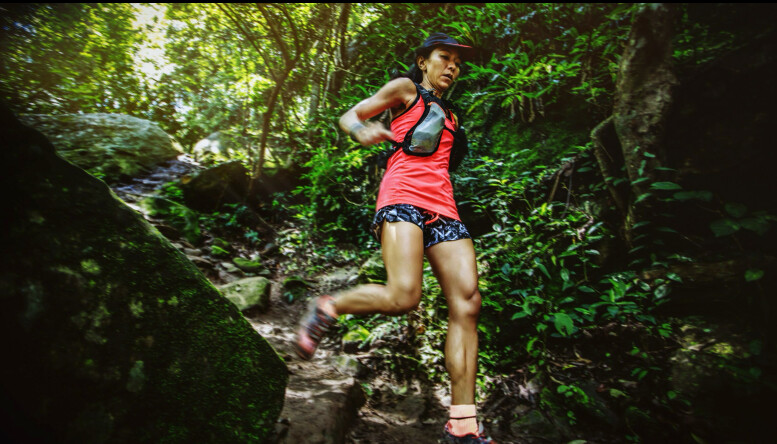
One of the simplest ways to measure progress, both in trail and road running, is by repeating looped routes regularly. Choose a trail that offers a mix of terrains, elevations, and technical challenges. By running the same loop consistently, you can monitor improvements in your pacing, endurance, and overall comfort level with the terrain. Take note of how you navigate tricky sections more confidently and efficiently over time.
Dana Katz, coach at UltraU Fitness, often prescribes what she calls a “money loop.”
“My athletes get to choose this for themselves,” Katz says. “This could be a Strava segment or local favorite and typically takes them one hour roughly, or five to eight miles. We revisit this every few weeks. It’s a great way for us to assess progress over time.”
Crafting a loop or two that you can use to benchmark your progress on a moderate-to-hard effort day can be a handy way to see how you’ve progressed over time. While Katz says you don’t need to be all-out to track results, her athletes get excited to see their heart rate and perceived effort level decline with training..
Similarly, one of my local favorite challenges is called “Golden Hell Week,” organized by local running group, Golden Mountain Runners, where runners test themselves on five routes over the course of a single week. While I don’t suggest doing back-to-back attempts at a fastest time, approaching these routes at different times throughout the year has been a great way to challenge myself in lieu of a tempo effort, and a sound method to see how I’m faring (if you ever find yourself in Golden, Colorado, I challenge you to the main loop around North Table Mountain).
Hills are a significant aspect of trail running, demanding strength and stamina. Designate specific hills or ascents on your favorite trail and incorporate them into your training routine. By regularly tackling these inclines, you can measure progress through increased speed, improved form, and enhanced cardiovascular endurance. Improving on hills is a clear indicator that your trail running skills are advancing. You can find a host of hill repeat training sessions from Coach David Roche’s 8 Favorite Hill Workouts.
Hills can be just as uncomplicated as running 400-meter intervals on the track. Simply put, select a hill near your house or on a favorite trail and run it several times fast. Rest, jog, and repeat. Note your time for each one, or run hard for a designated amount of time and note how far you made it up the hill. Hill repeats, money loops, and Strava segments (if you use that platform), can be useful strategies to assess progress within a shorter duration effort.
When switching from roads to trails, one of the hardest aspects to wrap our brains around is the concept of effort versus pace. To help gauge ourselves for the shift, Dee Stasullli, coach at Zeal Endurance Coaching, recommends incorporating practicing effort-based workouts and runs in your training. Craft “purposeful race plan, which involves switching from pace-based exercise prescription to effort-based,” Stasullli says. “I use a lot of the same prescriptors,like 10K effort or percentage of Lactate Threshold. It should feel hard but controlled and can translate to other variable conditions.”
You might start with a Lactate Threshold (LT) assessment, or a 5K to 10K race (or self-marked course) to find that sweet spot. From there, you’ll have a better gauge on what effort level corresponds to each pace and distance.“The more you can tune into how it feels at each effort level in your training, that can help you tune into the effort level needed for your race,” Stasullli says. While there are many factors that can influence our pace on the trails, effort is a gauge we can tap into regardless of the terrain, vertical gain, or other factors involved in the adventure.
Trail running is not just about speed; endurance plays a crucial role. As you progress, focus on increasing your “time on feet.” Gradually extend the duration of your trail runs, emphasizing steady pacing and consistent energy levels. This approach helps build endurance, allowing you to cover longer distances comfortably. Similarly, if you’re transitioning from running a certain number of miles a week on the roads to training on trails, consider how long you’re training per week by time, not just mileage. Road miles and trail miles are not created equally. Although you may not cover as much ground on the trails within the same timeframe, consider the amount of vertical feet you’re gaining and your overall effort level. Your body doesn’t know how far you run, it just knows how much stress it’s been under.
Heather Hart, coach at Hart Strength & Endurance Coaching, advises that athletes focus on training by time versus mileage “When I meet an athlete going from road to trail, we’re going to throw out pace suggestions and heart rate training,” she says. “Ask yourself: Are you getting a little further in an hour run this month versus last month? Overall, gauging how comfortable you feel on the trail and perceived exertion is a great start.”
While this training mindset isn’t easy to reframe, it can be empowering to ditch the watch or pace gauge to which you’re accustomed. If you’re unsure how long a loop on the trails might take you, start with out-and-backs or going up and down a hill, enjoying the negative split as you run down.
If you’ve been on trails throughout different regions,or even areas of town, you might realize how different paths can be depending on their location. Benchmark your progress by exploring trails over diverse surfaces. Transition between soft dirt, rocky paths, and hillier routes to challenge different muscle groups and improve overall adaptability. As you become more adept at handling various surfaces, you’ll notice enhanced stability and control during your runs.
For instance, if you want to improve your technical downhill running over loose scree, but you’re completely new to running over rocks, start with a handful of pebbles or crushed gravel. Focus on one segment of a pebble-filled trail you run often, practicing your technique and getting comfortable with the setup before introducing a new trail with obstacles you haven’t yet encountered, such as those big, burly rocks or loose scree found on big mountains. You might consider starting with a lesser-grade before moving onto steeper inclines and descents, especially when considering extra elements.
With unpredictable terrain and scenic routes, trails don’t always offer the straightforward metrics of road running, especially without races to gauge our improvement. However, by strategically incorporating looped routes, hill repeats, Strava segments, technical trail proficiency, time on feet, and variety in trail surfaces into your training regimen, you can effectively benchmark your progress.
These non-racing methods not only offer tangible ways to assess improvement but also contribute to the holistic and fulfilling experience of trail running. Because, afterall, metaphorically losing yourself on the trail is probably a big reason why you got into the sport in the first place. So, lace up your trail shoes, embrace the adventure, and, if you’re so inclined, check in with your progress every once in a while.
by Outside Online
Login to leave a comment
Running 300,000 Vertical Feet In a Year: Noble Goal or a Fool’s Errand?
Arbitrary goals are nonsensical. They also can be the source of great joy.In the pursuit of any goal, we all face a moment of questioning ourselves, sometimes out loud.The first week of last December, I had that moment, a question as I power-hiked up an icy trail, listening to my own labored breath:The answer, of course, was: No, it was not necessary. I had a cold, or enough remnants of a cold that I should have been at home resting instead of semi-vigorously exercising outside.
But I had a goal. Or, rather, I had committed to a goal, with a deadline: 300,000 feet of uphill human-powered movement, in the year 2023. Before I started hiking uphill that day, I had logged 289,476 feet of climbing via running, hiking, ski touring, and cycling. I had 10,524 feet left to climb, and 24 more days to do it. And I wanted to get done early so I could stop worrying about it. So I kept tromping uphill.
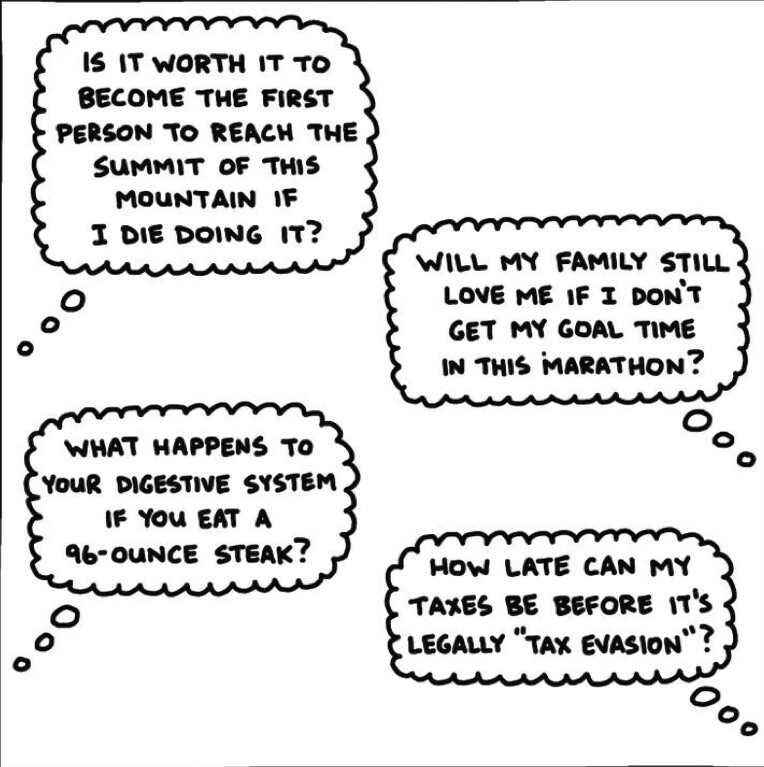
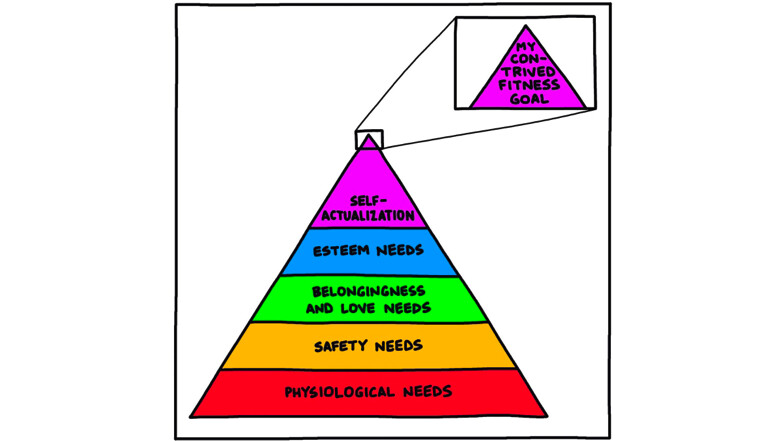
Even though I’d have a hard time convincing anyone it was “necessary,” in the sense of Maslow’s Hierarchy of Needs.Every year, human beings such as myself and yourself take part in an ancient ritual going back at least dozens of years: We decide how we are going to become a different person than we were the year before.
Sometimes we become completely different people, finally going to therapy, or deleting all of our social media accounts, or deciding to adopt the extensive and possibly unsustainable morning routine of a person who is an influencer on LinkedIn. Sometimes we just become a slightly different person, by committing to being on time, drinking more water, or meditating for one minute every day.
This probably sounds familiar. You may know it as a “new year’s resolution,” which is a common manifestation of this sort of idea, and also helpful in selling gym memberships. New year’s resolutions work for some people, but I have never had much success with them. Usually I think more along the lines of “what can I do that would make this year interesting/different from previous years?” Which I think is a good place to start, as opposed to “What’s wrong with me that I can attempt to fix or improve this year?” (If you’re asking yourself that same question, let me just say that you’re probably doing great, and at least a few people probably love you just the way you are. But yeah, we could all drink more water and eat more vegetables.)A few years back, a friend of mine mentioned he was going to try to log half a million vertical feet biking and hiking, and I don’t remember if he ended up getting it done, but I think he was probably inspired by a guy named Greg Hill who climbed and skied two million vertical feet in a year in 2010, and Greg Hill was probably inspired by himself, Greg Hill, skiing one million vertical feet in a year in 2005. I’m no Greg Hill. But what about 200,000 feet of ascent in a year? Certainly more doable by a middle-aged dad with a day job? That’s a little under 4,000 feet per week.
So I decided on that. I did a few backcountry ski laps at our local hill, just under 2,000 feet per lap, and hiked/ran up steep trails a couple times a week, trying to log a few hundred feet here or there. If Jay was awake and we had time between naps, I’d put him in the baby carrier backpack and chug up a trail for a few minutes or an hour, the dad version of a weighted training vest. I signed up for a steep 50K trail race, the Tiger Claw, which would get me almost 9,000 feet of climbing in one day, a big chunk.
Then in mid-May, my young friend Torrey, who has not been to my house recently to see my daily life trying to be a present and helpful dad, husband, self-employed artist and writer, said, “200,000 feet? I think you could do 300,000 easy.”
I thanked him for the encouragement by replying, “Fuck you,” and then we argued for a few minutes about who would buy dinner.
And then of course I started doing the math, which really amounted to a big question, How do I want to live my life this year, which is really a series of smaller questions:We’re lucky, as human beings, to have the time and resources to come up with ideas we refer to as “dreams,” and then spend time and resources pursuing those.
Some people put a lot of time and resources into one dream, like thru-hiking the Pacific Crest Trail, or climbing a big mountain halfway across the world, or completing an Ironman triathlon.Since I am a coward, I often tend to shy away from big goals with a high chance of failure, and instead choose to pursue goals with longer timelines, in order to have some flexibility. A bad week of weather can derail a big mountain summit attempt, and an injury can derail a plan to qualify for the Boston Marathon (I guess so could gastrointestinal distress on race day), but an annual goal of a bunch of vertical feet can withstand some bad weather or minor injuries during the year. Or, in my case, catching every communicable disease Jay brought home from daycare in his first six months of attendance, which included something like six colds, and norovirus or something similarly explosive and miserable.
Even with a week off here and there, I kept chugging along. I started a Strava club called 100 Grand, because I thought other people might think it was fun to try to log 100,000 feet of climbing, or 200,000 feet, or 500,000 feet, or whatever, depending on where they lived and how much time they had to devote to it. I know not everyone lives in a mountainous area, or even a hilly place, but I also knew about this group of people in Iowa and Illinois who race to see who can log 25,000 feet of vert the fastest (and in the smallest amount of horizontal distance) every December. I mean, look at this spreadsheet:Almost 2,000 people signed up for the 100 Grand Strava club, despite it launching in the middle of the year, and I’m not sure how much it motivated people, but I’m going to do it again in 2024. As soon as I finish mailing out stickers to everyone who clocked 100K or more in 2023.
As I rolled over 200,000 feet in September, and then 250,000 feet (in early October), I started to reflect on how the 300,000-foot number had changed my year of running. I have never been one to pay attention to my per-mile pace, but it went completely out the window this year, since a typical run for me looked like this:Mt. Sentinel is essentially a straight line two miles from my house and roughly 2000 vertical feet higher than my front door*, so I defaulted to it often this year. I stood on the summit 47 times, often enough that it started to feel quite ridiculous, but also a sort of home. Which is probably how my dad feels about certain holes on his home golf course, or how my brother feels about his favorite fishing spots.Every time I got home from a run, I’d check my yearly total on Strava as it ticked upward—except on the rare days I did a flat run, when I was short on time or had to run Jay to or from day care in the jogging stroller.
Eventually, I had a little less than 2,000 feet to go. Unless something crazy happened, I’d just need to get to the summit of Mt. Sentinel one more time and I could stop obsessing about it. My friend Forest had offered to go with me, but also said he understood if I wanted to go up alone. I decided to keep this one to myself, microspikes on my shoes for the icy sections, trekking poles as insurance to keep myself upright.
The last climb up the steep trail on the south ridge seemed like it was taking forever, and I watched several paragliders take off from near the top, a surprise sunny December day. I jogged through the snowy forest between the south and north summits, and then started the steep hike up the final 100 feet to the top. A figure in an orange jacket was starting down from the summit, headed my way.
The person stopped on the trail when they saw me, and without being able to see quite that far, I knew it was Forest. He started clapping, and then went back to the summit with me. He asked if I wanted to have the top to myself, to process it a little bit, and I said Nah, it’s just the last few feet of my dumb goal for the year. Which was true.
The closer I got to finishing, the more ridiculous it felt, and as much as I’d like to have had some epiphany about life, I know sometimes you just need a new motivation to get out the door and experience something, even if you end up on the same mountaintop *checks notes* 47 times. But as ridiculous as it was, I still followed through with it, which has some sort of meaning, maybe.
You don’t need to go far these days to find inspirational quotes about pursuing your goals, and I think everyone is looking for something different. The older I get, the more I think about a line from the late, great, philosopher and restaurateur Kenny Shopsin, in the 2004 documentary I Like Killing Flies:
by Outside Online
Login to leave a comment
Ferdinand Omanyala's track rival hoping to bounce back as he eyes Olympic title
Ferdinand Omanyala's Italian track rival hopes to make a grand return this season as he gears up to defend his Olympic title in Paris, France.
Ferdinand Omanyala’s track rival Marcel Jacobs had a poor run last season due to a bout of injuries but the Italian hopes to make a strong comeback this season.
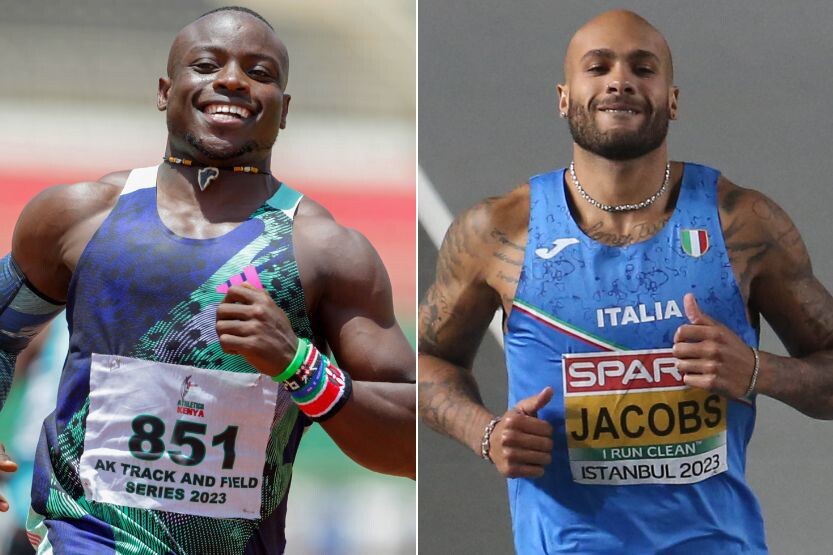
Jacobs, the reigning Olympic champion made a few changes at the end of last season where he parted ways with his coach Paolo Camossi who guided him to the 100m title at the delayed 2020 Olympic Games.
At the time, Jacobs had yet to decide on his new coach but noted that he would be leaving Rome where he had been based. Last season, he competed in four 100m races and failed to clock a sub-10 in all four and also failed to win any of the 100m races.
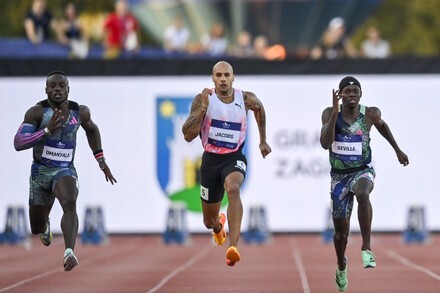
His final race last season was the Memorial Borisa Hanžekovića in Croatia where he finished third and he hopes to bounce back this season as he gears up to defend his Olympic title.
The Italian has also skipped the indoor tour this season, a move that is unlike him since he is usually a frequent competitor during the indoor races.
As per World Athletics, Jacobs will head straight to the outdoor season where he intends to open his season at the Ostrava Golden Spike for the first time as he works towards the European Championships on home soil.
As per World Athletics, Jacobs will head straight to the outdoor season where he intends to open his season at the Ostrava Golden Spike for the first time as he works towards the European Championships on home soil.
by Abigael Wuafula
Login to leave a comment
Paris 2024 Olympic Games
For this historic event, the City of Light is thinking big! Visitors will be able to watch events at top sporting venues in Paris and the Paris region, as well as at emblematic monuments in the capital visited by several millions of tourists each year. The promise of exceptional moments to experience in an exceptional setting! A great way to...
more...Conquer Your Longest Distance Yet With These 9 Tips
Ultrarunners and coaches share their best advice for building mileage without getting injured.
Whether you want to progress from a 5K to a half marathon or a marathon to an ultra, a few general rules on how to run longer can help you get there.

While building mileage and time on your feet is paramount, the key to doing it successfully involves patience and persistence. “As much as volume matters—volume is king—too much volume too soon can get you on the sidelines,” Bertrand Newson, RRCA-certified run coach and founder and team captain of Too Legit Fitness, based in San Jose, California, tells Runner’s World.
Follow these tips from Newson and other coaches and ultramarathoners to successfully increase your mileage, avoid injuries, and crush your longest distances.
1. Build a Base, Then Keep It Consistent
“I steadily built up to running 250-mile races over many years, but I started by running one mile at a time,” says Sarah Ostaszewski, pro ultrarunner with Tailwind Nutrition who won the 2023 Ouray 100-Mile Endurance Run. “Build a strong base and try to keep a consistent running routine, so then adding a little extra here and there won’t seem so daunting.”
Base training typically requires about four to eight weeks (before following a race training schedule) to strengthen your cardiovascular system and your muscles, but the longer you can regularly run and set a foundation, the better. Your base work should involve mostly easy runs, low mileage, and maybe low-key speedwork (depending on your fitness level), like ending a run with strides. This part of your training is all about consistency, rather than actually building mileage.
Ultrarunner Mirna Valerio stays consistent by focusing on time on her feet, rather than distance. “This has been mentally freeing,” the author of A Beautiful Work in Progress tells Runner’s World.
“I have a standing appointment with my treadmill a couple times a week,” says Valerio, who will aim to run a minimum of 12 hours a day over six days at the Lululemon Further event, an ultramarathon for women in March. “I just get it done, which incidentally is one of my mantras.”
2. Find Your Best Approach to Building Volume
If you’re new to running and want to run longer, add another day of a short, easy run to your schedule, suggests Stefanie Flippin, an ultrarunner, Lululemon ambassador, and doctor of podiatric medicine, who has earned a first-place finish at several 100-milers.
Maxed out on available days of the week? Add to your long-run mileage, which is what Leah Yingling, ultrarunner and biochemical engineer who will see how far she can run in 24 hours at Lululemon Further, does first when aiming to build volume. The general rule is to increase your weekly mileage by about 10 percent each week, adding to that long run. For example, if you currently clock 17 miles per week with three four-mile runs during the week and a long run of five miles on the weekend, you would keep your midweek mileage the same, but kick up your long run to about seven miles next weekend.
Yingling, and many other pros, also do two runs a day. While this won’t work for everyone, if you don’t have a significant single block of time, clocking some miles in the morning and again in the evening and resting between can help you clock more mileage. One must-do to make it work: Tame the intensity on at least one of those runs.
Charlie Lawrence, 50-mile world record holder, views his second run of the day as a sort of active recovery. He often goes for double digits in the mornings, then runs for about four miles (at minimum) in the evening, keeping the effort light.
No matter what, testing out strategies to see what works for your schedule is the best way to run longer. “That might be adding a walk a few days a week in addition to your daily runs, or maybe you’re adding back-to-back long runs,” says Yingling. “Whatever you do, find something that is sustainable.”
3. Follow a Progressive Training Plan
A good training plan will slowly build mileage to decrease your risk of getting sidelined, as research shows taking on too many miles too soon is one of the biggest risk factors for overuse injuries.
When choosing your training plan, you have to be realistic about the time you have to build up to the distance you want to conquer—and where you’re at now, says Newson. For example, if you have your sights set on a half or full marathon, think about what you can comfortably run today. Then, following the loose rule of adding 10 percent more miles each week, how long do you need to train? If you currently run five miles without stopping and feel good after, and can comfortably clock 12 miles per week, you can probably conquer a 10-week half marathon plan.
Another important factor to look for when it comes to mileage on a training plan: recovery weeks. Newson explains you’ll typically see this as three weeks of building, then a week in which you back off mileage a little to give your body time to recover and actually make gains from all the work you put into your plan. This will also keep your body strong and help you sidestep aches and pains, he adds.
4. Keep Easy Runs Easy
You’ve heard it before but it’s especially true when trying to run longer: Don’t overdo your low-effort days.
“It’s important for me to always run my easy runs, short or long, at a conversational, aerobic rate of perceived exertion. This means that I can easily chat with a training partner for the duration of my runs without becoming out of breath,” Flippin says, who also clocks her heart rate to make sure she’s in an easy zone.
Don’t worry about what shows on Strava, either. “I think a lot of runners run their easy runs too hard and that is because of ego and they don’t want people to think they are slow,” says Devon Yanko, ultrarunner who’s placed first in several 100-mile races and will aim to conquer her longest distance over six days at the Lululemon Further event. “I delight in the idea that people may look at my Strava and think I am too slow, because on race day that won’t be the case!”
More generally, applying the 80/20 rule to your training overall can also help you record more low-intensity runs, Newson says, as it means 80 percent of your workouts should happen at a low intensity, and 20 percent at a hard effort.
It’s these easy runs that will help keep you running consistently—the key that unlocks higher mileage. “A B+ average of consistent runs, strength work, and recovery measures stacked over weeks, months, and years will always trump sporadic A+ weeks followed by a total drop-off,” Flippin says.
5. Master the Long Run
For most people, the long run will make up the bulk of your weekly mileage, but it doesn’t just help you clock more time on your feet. It also teaches you mental stamina, how to deal with fatigue, and it can help you get comfortable with being uncomfortable. With years of practice, this is what many pros say pulls them through farther distances.
Even though Lawrence can deal with being uncomfortable for long periods of time, he still turns to mind games to mentally check off miles. For example, he often breaks a race down into small, manageable chunks, often focusing on the next fuel stop (typically about every four miles) as a check point. If he’s struggling to get to the next four-mile marker, he may tell himself he’ll feel better in 10 to 15 minutes and checks in again then.
In addition to breaking your long run up into segments, Newson also suggests dedicating each mile to someone else, which takes it outside of yourself and gives you another reason to keep going, and says to focus on the mile you’re in, simply putting one foot in front of the other.
Finally, the long run is the perfect time to practice your fueling and fluid intake, Newson says, considering you need energy to clock longer miles. Aim to take in carbs when going for 90 minutes or longer, and go for about 30 to 60 grams per hour after the first hour.
6. Schedule a Few Harder Workouts
To build endurance, you want to run long, but you can also add intervals and speed work into your schedule.
Lawrence gets on the track for VO2 max-specific workouts at least once a week. VO2 max is the amount of oxygen you can take in while running and is a major marker of fitness—the better this metric, the easier running will feel, which will help you go longer with less effort. Focusing on VO2 max intensities on runs means going for about 90 to 100 percent of your max heart rate or about 5K pace, and it could involve intervals like 400-meter repeats.
You could also focus on lactate threshold training. Your lactate threshold is the point at which your body produces lactate at a rate you can no longer clear, leading to fatigue. To help you prolong that side effect—helping you go faster for longer—practice running at your threshold pace. (Here’s how to calculate your running speed at lactate threshold).
To do this, Ostaszewski prefers longer interval workouts with work periods ranging from six to 10 minutes near aerobic threshold. But tempo runs at your threshold speed are also smart.
7. Supplement Your Runs With Mobility and Strength
Before you jump into high mileage, you need a solid warmup. Lawrence has been doing the same activation drills before runs for a long time. He starts with foam rolling most of the lower body, then does a series of exercises, like:
Leg swings
Down dog to lunge rotation
Ankle mobility moves
Banded work, like glute bridges
This go-to routine wakes him up and gets him in run mode, even when he’s not feeling it.
Cross-training workouts are also key. Valerio mixes strength training, mobility workouts, Pilates, and rowing into her training schedule, which she says helps her avoid overuse injuries. Meanwhile, Flippin points to strength training in particular as crucial to running longer. She suggests starting with one day a week to build consistency, then adding on days from there.
Lawrence focuses specifically on doing core workouts every day (one of his go-to moves: the ab roll out), along with dedicated gym time for lifting, in which he conquers moves like hex bar deadlifts.
8. Make Recovery a Priority
Many pro runners turn to a solid nutrition practice to jumpstart recovery and fuel future performances. “I ensure I’m always getting in carbohydrates and protein within 30 minutes of finishing a key workout or long run,” Yingling says.
Finding time for other recovery practices, like mobility work, foam rolling, even meditating, can also support your training and get you prepped for the next round of mileage, Newson says. Full rest days are also important, especially if you’re feeling any aches and pains.
And you can’t forget about sleep for recovery—striving for at least the recommended seven to nine hours—especially for those looking to push their mileage.
9. Don’t Rely on Motivation Alone
Running your longest distance takes dedication and determination, but don’t expect to feel motivated every day. “People often wait to do things until they are motivated, when instead, they should have been focused on completing their plan or working toward their goal,” says Yanko. “I don’t jump out of bed every morning peppy and excited to run, but I am committed to doing the work and thus, I simply get the work done.”
Yanko also suggests tapping into curiosity to keep you going longer. “That is, instead of being intimidated by a workout or long run, I allow myself the opportunity to be curious about what might happen if I simply begin the session,” she says. “I do not believe that one workout or one long run ‘proves’ anything about my fitness or ability to race, so having curiosity means I can get into a session and allow it to unfold with confidence that if I just continue to show up and do the work, I will build my fitness brick by brick.”
Newson also suggests a running group to keep you accountable and consistent, and to elevate the fun of your workouts.
“On the mental side, I always try to see the big picture and remember that all the miles I’m running are for fun and for my own personal enjoyment,” Ostaszewski adds. “I’m always aiming to enjoy the process and recognize growth in the journey.”
by Runner’s World
Login to leave a comment
British journalist exonerated for alleged cheating at London Marathon
In one of the most high-profile cheating cases in recent years, British running journalist Kate Carter has been cleared of wrongdoing by England Athletics after facing accusations of cheating during the 2023 London Marathon and London Landmarks Half Marathon events.
Carter, a journalist and editor for Runner’s World UK, was under suspicion for allegedly entering a fake time at the London Marathon and course-cutting the London Landmarks Half Marathon last April. Marathon Investigation blogger Derek Murphy publicized the allegations, claiming there was no evidence Carter had run the entire London Marathon and that she may have used software to manually create GPS data based on an out-of-date course map. Murphy’s second allegation was that there was no record of her having completed the 10K to 20K section of the Landmarks event. Besides missing the timing mats, early race photos show Carter’s bib fully visible, compared to photos from later stages in the race, where her bib is folded, only revealing part of her number.
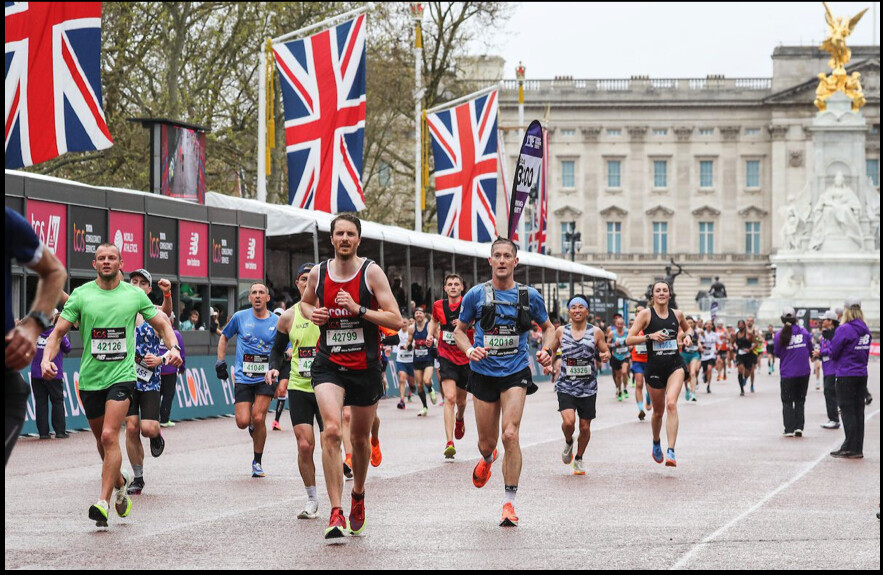
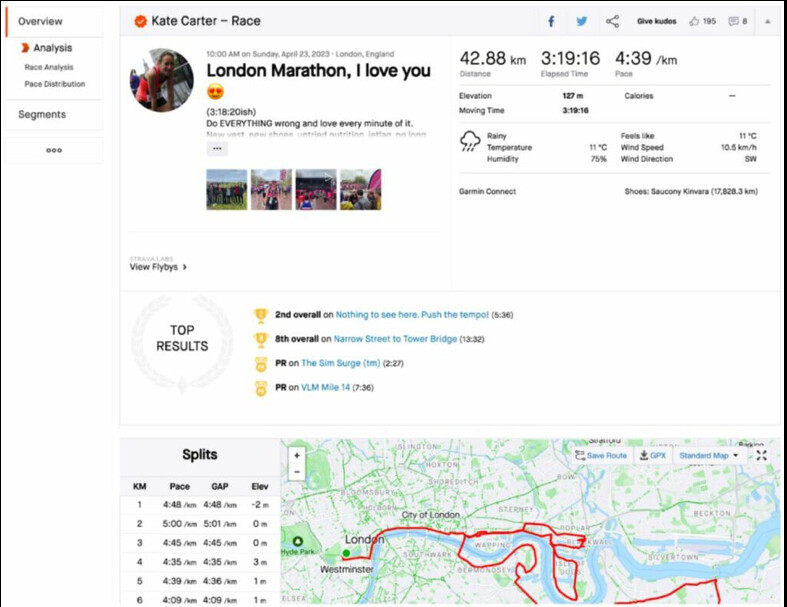
Carter denied the allegations, telling Athletics Weekly that she was not a cheat but just made some ill-considered decisions. Her defense was that, at the London Marathon, she decided not to run with a chip, as she felt she wasn’t in good shape and did not want an official time. However, she later decided to give herself a personal record on Strava, and used the app to draw a map of her run. Having later realized the map was inaccurate, she removed the post. At the London Landmarks Half Marathon, a race used by thousands of runners in preparation for the London Marathon, Carter says she had to leave the course because she had urinated on herself. She did not rejoin the race at the same point (which she claims was unintentional), and insists that her GPS watch had died.
England Athletics (EA), the governing body of all road races in the country, launched an investigation and found there was “no intention to deceive and no attempt to benefit from the results.” A spokesperson from EA told Athletics Weekly that every effort was made to arrive at the correct outcome.
“Investigators found that I did run last year’s London Marathon without a timing chip, as I have always said,” Carter said. “To reiterate: I am not a cheat. And I have never cheated. I ran without a timing chip as I thought I would perform poorly, and I didn’t get a time. I then attempted to draw the run on my Strava so my miles counted towards the monthly total.”
“At the London Landmarks race, I stepped off the course after wetting myself in a bid to find a bin and clean myself up. This was a hugely embarrassing moment, and I accept that I then inadvertently re-entered the race in a different spot. However, England Athletics have now told me that, after speaking to organizers who have also provided details of my timing chip, they have ruled that: ‘This was not a deliberate act of deception, and you did not gain any benefit or win anything as a result’,” Carter reveals.
Murphy told Canadian Running in a statement that he believes England Athletics’ investigation did not dispute any of the facts from his original article. “The findings pertain to her intent to deceive and whether her actions rose to the level of ‘serious misconduct’,” he says. “I do understand that they probably don’t want to open the door to receiving complaints on every mid-packer that cuts the course or doctors their Strava. I am not sure how they would conclude that there is no intent [from Carter] to deceive based on the verifiable and admitted facts.”
Carter, 47, is known for her achievements as an age grouper and for holding the world record for the fastest marathon by a woman in an animal costume (3:48:32). She told Athletics Weekly that the entire process has been damaging to her mental and physical health, and her reputation. “Running was a big part of my identity,” said Carter. Having been cleared, I really hope to find that joy again.”
The London Landmarks Half Marathon has offered Carter an invitation to run this year’s race.
by Running Magazine
Login to leave a comment
Your dog can now be a Strava local legend
Shoutout to all dog walkers and proud pet owners out there: the world’s largest fitness-tracking app is teaming up with Fi, a smart dog collar brand, to bring canine athletic achievements to your activity feed. Last week, Strava announced this pet-friendly collaboration to showcase their four-legged friends’ fitness alongside their owners’.
Fi collars are equipped with built-in satellite systems (like your GPS sports watch) and are primarily designed to locate lost pets; they also monitor basic health metrics, like sleep and step counts. Now, this same technology enables pet parents to log their dog’s activities online, receive kudos and compare their numbers with other pets of the same breed.With a membership, users can track their dog’s distance travelled and the total number of steps taken, while also monitoring their best friend’s progress toward daily goals and sleep totals. The app seamlessly uploads routes of your dog’s walks or play sessions onto a map, providing a visual representation of their adventures. Like run data privacy, there is also an option for the maps to be hidden, visible only to your followers (or to you).
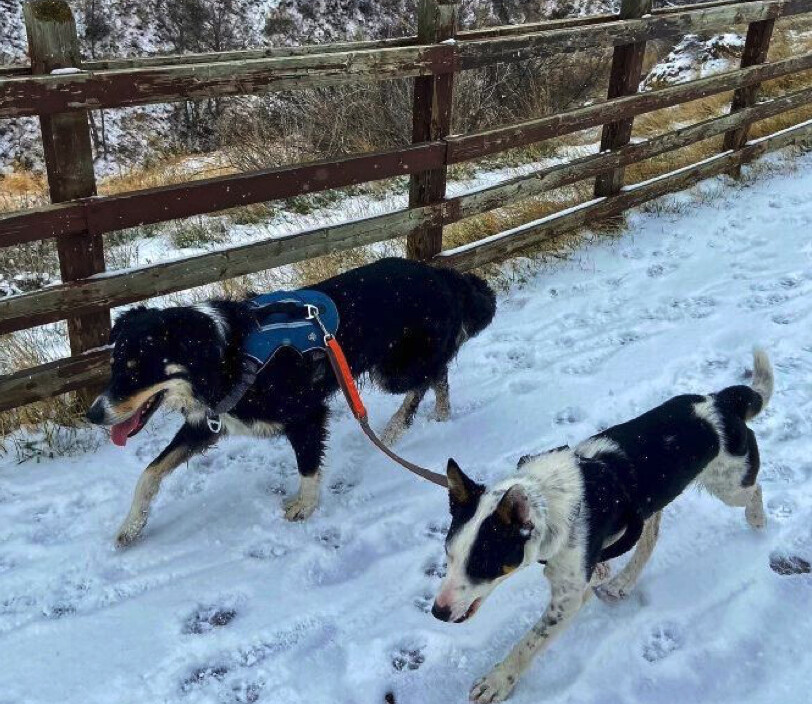

According to the 2023 Strava Year In Sport report, 76 per cent of all Strava athletes with pets say their furry companions motivate them to get active. With the integration of Strava and Fi, users can now track dog-specific stats and share their pet’s progress with their community.
If you already use Fi, you can sync your Fi and Strava accounts and begin seamlessly uploading your dog’s walk activities.To celebrate this collaboration, limited edition co-branded Fi x Strava collars are available for purchase at the Fi store, allowing pet parents to showcase their love for Strava while keeping their furry friends safe and stylish. To learn more about the Strava and Fi partnership, visit tryfi.com/strava.Like GPS watches, pet tracking on Strava does come with a cost; Fi plans start at USD $192.00 annually.
by Running Magazine
Login to leave a comment
Runners Are Racing More than Ever
Strava’s year-end report shows that more runners are turning to competition and how different generations compete differently
This month, Strava released its annual Year in Sport, with fascinating insights about where running might be headed. Running was the most-uploaded sport in 2023. (Hear that? That’s the sound of job security!) Most runners log their miles solo, 9 percent are in groups of three or more people, and an additional 9 percent are logged running in a pair.
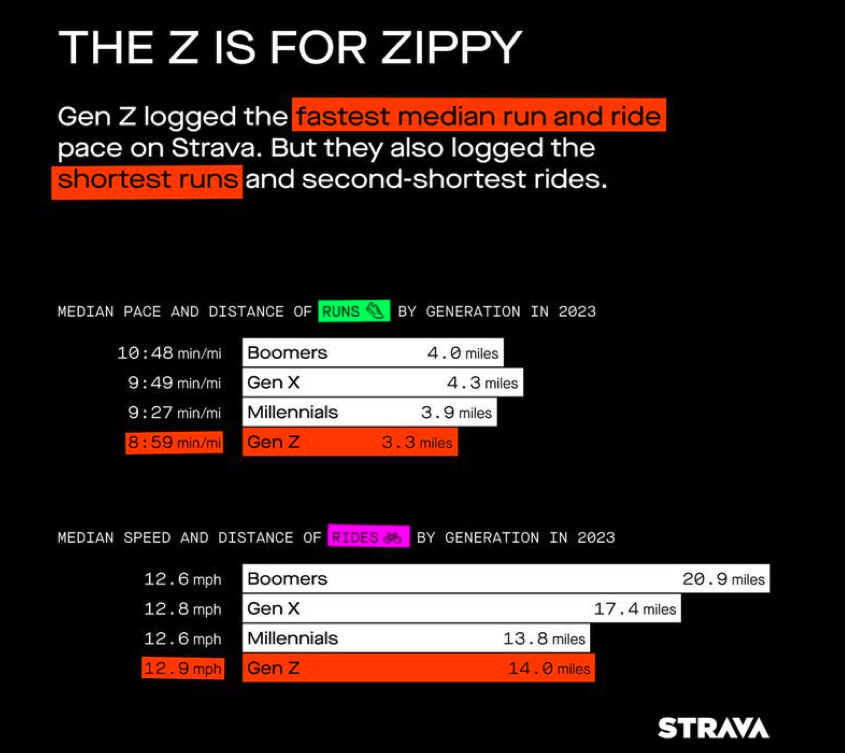
Trail running, specifically, continues its trend upwards, with the share of athletes running off-road up 6 percent year over year. Almost half (47 percent!) of runners took at least one trail run. Friends, welcome to the club. We have jackets! (Haha, no we don’t.)
Many runners use competition as motivation and inspiration. Plus, athletes who race are 5.3 times more likely to set a distance PR. While men are currently more likely to compete than women, the rate at which men and women are participating is increasing at the same speed.
When life after the COVID lockdowns stabilized for many folks, the Strava Year in Sport review shows that they laced up their running shoes to compete. Twenty-one percent of runners on Strava ran at least one race in 2023, a 24 percent increase over 2022.
Racing was equally split across genders, with 21 percent of men and women competing at least once. Runners from Gen X (born between 1965 and 1980) were the most likely to race, with 26 percent logging at least one competition on Strava. Twenty-two percent of millennials (born between 1981 and 1996) raced, and 24 percent of boomers (born before 1965) pinned on a bib in 2023.
Ultramarathons, while still less popular than shorter distances, are steadily becoming more popular, too, according to statistics. While just 2 percent of runners on Strava completed an ultra in 2023, that’s still up 11 percent from 2022.
Out of all ultrarunners on the app, two-thirds completed at least one 50K, meaning plenty of runners double-dipped on super long-distance runs in 2023. Women were 43 percent less likely to have run an ultra of any distance (so, yeah, we might have a problem). Participation in ultras may be growing at the same rate among men and women, but there is still plenty of work to be done—for instance, addressing childcare disparities that leave women with three to four fewer hours per week to train—in order to reach equity. The longer the distance, the greater the gender gap tends to be, with half marathons having the smallest disparity—7 percent of women completing a half and 8 percent of men.
Longer races are less popular this year, sure, but participation is growing by about 10 to 15 percent. Less than 1 percent of runners on Strava completed an ultra over 50K, though this distance remains the most popular to run. Participation in 50 miles is roughly half that of 50Ks, and 100K participation is roughly half that. So, if you ran a 100K this year, pat yourself on the back, as you’re part of the 1 percent (.0025 percent, to be exact).
Marathons remain a popular distance for runners. Five percent of runners on Strava ran a 26.2-mile race in 2023, up 20 percent from last year. Again, women were 32 percent less likely to have run a marathon than men (4 percent of women on Strava ran a marathon versus. 5 percent of men), but both groups saw participation jump 20 percent compared to last year.
Gen Zers are not running as much as previous generations did at their age. Running, while less cost-prohibitive than, say, surfing, skiing, or mountain biking, still requires some financial investment. A 2020 survey by the Running Shoes Guru pinned the “average” run budget to between $937 and $1,132 annually. I guess those gels really do add up!
And when you consider that 60 percent of young adults don’t feel their basic needs are met, a decline in participation makes sense. According to Running USA, an independent group that produces industry surveys, the number of runners in the 35-44 and 45-54 age groups has dropped significantly since 2015, while participation in the 25-34 age group only increased slightly. According to the report, Gen Z runners prefer to run for experiential benefits like socializing, fun, and mental health.
Interestingly, data about Gen Z runners on the Strava Year in Sport says the opposite, reporting that this generation is 31 percent less likely to exercise primarily for their health compared to millennial and Gen X counterparts. The difference could be that runners committed enough to sign up for an activity tracking app are already a self-select group. Zoomers on Strava report that their primary motivation for exercise is athletic performance. This is echoed by the speed of their training runs, which average out to be a pace of 8:59 a mile. Zoinks!
Interestingly, data about Gen Z runners on the Strava Year in Sport says the opposite, reporting that this generation is 31 percent less likely to exercise primarily for their health compared to millennial and Gen X counterparts. The difference could be that runners committed enough to sign up for an activity tracking app are already a self-select group. Zoomers on Strava report that their primary motivation for exercise is athletic performance. This is echoed by the speed of their training runs, which average out to be a pace of 8:59 a mile. Zoinks!
Gen Z runners are also more run-dominant than other generations. Seventy percent of the generation’s Strava users uploaded runs onto the app versus 52 percent of Gen X, a 35 percent higher likelihood (this might as well be the likelihood to Google “What is a Zendaya?”) Gen Z runners saw the greatest percentage of growth in race participation this year, with a 60 percent jump in attendance at the marathon distance and a 68 percent increase at 13.1. (My mind would fully melt if I lined up against someone born in 2004, but also, welcome! Please be gentle.) According to Running USA, Gen Z runners gravitate towards races with a compelling theme or cause that resonates with their values.
Trends are different across training habits, too. Gen Z runners are twice as likely as boomers to have weekday activity after 4 P.M. and are 31 percent less likely to exercise before 10 A.M.. Fascinatingly, 39 percent of Gen Z Strava athletes started a new job, and a third of the cohort reported relocating in 2023, which could speak to flexibility or economic instability for younger runners.
Over the year, Gen Z runners logged 17 percent less mileage than Gen X athletes, explained primarily with a shorter average run length. Plus, Gen Z athletes have slightly fewer running weeks in a year. (Maybe if they weren’t so busy eating all that avocado toast, they could run more!) JK, as the kids on TikTok say. In truth, Gen Z runners might train less because they are shooting for shorter distances, or the other way around—it’s impossible to disentangle causation here.
It’s not only a fun pastime to browse the year-in-review data, poking fun at the generations before or after us like they’re siblings (“No, I run more!” “Well, I run faster!”), but it’s also a way to see where the industry is lacking.
The Strava Year in Sport data shows that the running industry will have to work to bring in more Gen Z athletes. This might mean that race directors and event organizers will have to continue tailoring their offerings to speak to a younger, more experience-driven demographic. Numbers also prove that, while the female section of the running pie has grown overall, more changes need to be made to reach gender equity. The statistics tell us a lot, but one of the biggest, if not the biggest, takeaways is that people are running more now than ever. And that? Well, that’s pretty rad.
Login to leave a comment
Swoboda's sights set on medal glory in Glasgow
Sprinter Ewa Swoboda is bang on target for her first global senior medal at the World Athletics Indoor Championships Glasgow 24 next month. And the Pole, No.2 in the world this year over 60m, is sure to be well supported at the Scottish venue on March 1-3.
Not only is it the same arena in which she won European Indoor Championships 60m gold in 2019, but she also has strong family ties nearby.
“It’s a big event for me,” she says. “I want to win a medal and a PB.
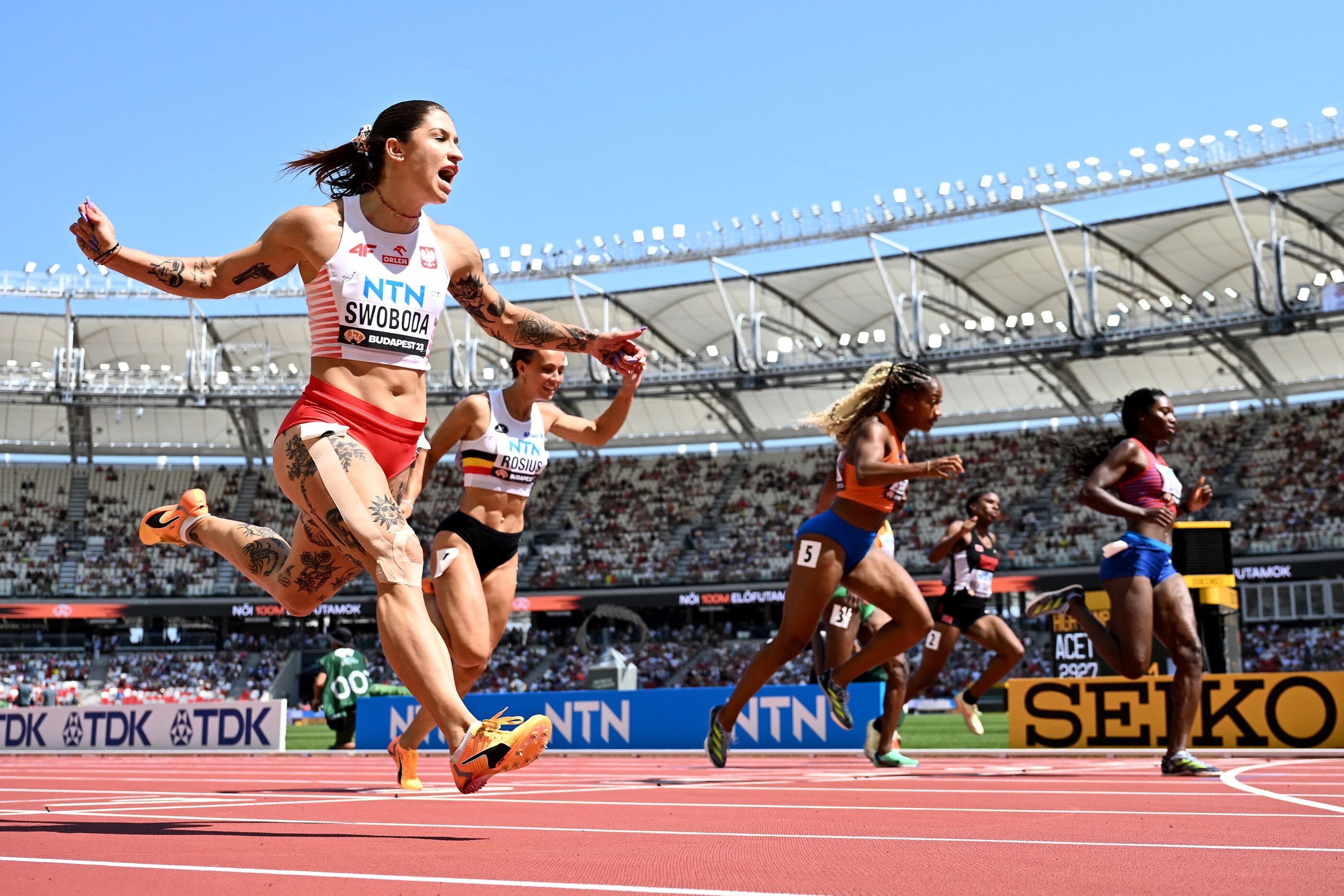
“I like Glasgow. It’s also close to where my brother lives in Edinburgh.”
Swoboda opened her year in searing style, winning at the World Athletics Indoor Tour Bronze event in Lodz and then at World Indoor Tour Gold events in Ostrava and Torun. At the latter, she clocked a then world lead of 7.01, her best time for two years. Only Julien Alfred, with the 6.99 she ran in New York, has gone faster so far this year. That 6.99 matches Swoboda's PB, set in Torun in 2022.

Speed has always been a feature in the life of the Zory-born runner, who also takes an interest in fast cars. Recalling her school days, Swoboda says: “I (was) faster than the boys too and my teacher looked at me and she told my parents, ‘She must go to training.’ And here I am, since 2009.”
Her first major competition saw her finish fourth in the 2013 World U20 Championships in Donetsk, Ukraine, aged 16. She then placed fifth at the same event in 2014 in Eugene, USA, and became European U20 champion in Eskilstuna, Sweden, in 2015.
Then, at the 2016 Bydgoszcz World U20 Championships, she thrilled the home crowd by winning 100m silver. She went on to represent her country at the Rio Olympic Games, where she reached the semifinals.
Now, 26, she is asserting herself on the world stage. She was fourth at the 2022 World Indoor Championships in Belgrade and last year she reached her first World Athletics Championships final, placing sixth over 100m.
It followed an unfortunate career blip, which meant she missed the opportunity to defend her 60m title at the 2021 Torun European Indoor Championships in her home country due to Covid-19 and then the Tokyo Olympics through injury.
Now, as well as enjoying her current success on the track, Swoboda embraces being an extrovert figure in the sport. Her heavily tattooed body, painted nails and playful personality have won her a legion of fans at home and overseas.
“I am not playing any role,” she says “I am just Ewa. I am open, I don’t have a problem smiling! It’s important. I like what I do, and I am happy.”
She also welcomes being part of the current era of the women’s 100m and its colourful crop of champions, particularly world champion Sha’Carri Richardson.
“I love to run with Sha’Carri,” smiles Swoboda. “Sha’Carri is a gorgeous girl, and her energy is welcome and it’s nice to be a part of this little family.”
This year promises to be a huge one for Swoboda, with the World Indoor Championships, European Athletics Championships and the Olympic Games all in her plans: “First Glasgow, then Rome and Paris!”
As for whether, there will be more body art this year, she says: “Not now. Maybe when I win something? Maybe after (the) indoors, some more tattoos.
“I like this, it’s my hobby,” she adds, putting precious metal above tattoos as her favoured decoration for now.
by World Athletics
Login to leave a comment
World Athletics Indoor Championships
World-Class Competition Lands in China: 2025 World Athletics Championships The global spotlight shines on China as it hosts the 2025 World Athletics Championships, bringing together the planet’s most elite runners, jumpers, and throwers. This prestigious event, organized by World Athletics, represents the pinnacle of track and field competition—where national pride, personal records, and world titles are on the line. ...
more...How change of shoes helped youngster Letsile Tebogo smash world record
Letsile Tebogo ran faster than Michael Johnson and Usain Bolt to set a new world 300m record but that would perhaps not have happened had he not changed his running shoes.
Botswana sprint sensation Letsile Tebogo is currently basking in the glory of his new world record after lowering the 300m mark last weekend.
Tebogo smashed the world 300m record following an incredible run at the Simbine Curro Classic in South Africa, running 30.71, to beat South African Wayde van Niekerk's mark of 30.81 set in Ostrava, Czech Republic in 2017.

In what was a world lead and his personal best over the distance, the 20-year-old obliterated the field to take a giant lead, leaving a big gape between him and the chasing pack as he sprinted to the finish line.
It has now emerged that things would have perhaps been different had he not opted for a change of shoes, having decided to ditch his trainers for spikes ahead of the race.
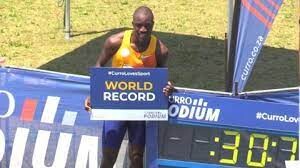
Since sustaining an injury that locked him out of the Zurich Diamond League 200m finals, Tebogo has not used spikes and wore trainers in his season-opening race in January, but his coach Dose Mosimanyane advised him to use spikes in last Saturday’s race in Pretoria only to yield a world record.
“The world record was not in the plan. But I am not surprised. With his training partner, Bayapo Ndori and other athletes in the mix, I knew he would do something but this is not what we came here for,” Mosimanyane said.
The world 100m silver medallist did not just break the seven-year world record but his time was faster than that of American great Michael Johnson, who clocked 30.85 at the same venue in 2000, and Jamaican sprint legend Usain Bolt, who timed 30.97 in 2010.
The world 200m bronze medallist had an impressive 2023 season when he became the first African to win a medal at the World Championships in 100m and also the first from his country to achieve such a feat.
He is hoping to go one better this during the Paris 2024 Games in France where he is seeking to make history by winning his country’s first ever Olympics gold.
by Joel Omotto
Login to leave a comment
Kelvin Kiptum's legacy lives on with two-hour challenge
Last Sunday, the running world lost marathon world record holder Kelvin Kiptum at the age of 24 after he lost control of his car in Kaptagat, Kenya. Kiptum was one of the most promising athletes in the sport, setting the marathon world record of 2:00:35 at the 2023 Chicago Marathon, and was slated to challenge the two-hour barrier at the 2024 Rotterdam Marathon.
In memory of Kiptum, the running community has come up with an idea to honour his legacy: a virtual two-hour run on April 14, the day he was scheduled to run Rotterdam.The challenge isn’t asking runners to go out and try to break the world record, but they can use the challenge as a long run for their upcoming race or see how far they can run in the elapsed time.The two-hour challenge also does not have to be a run; it could be a ride, or even a walk. Just be sure to tag #TwoHours4Kiptum on your Strava or social media post.
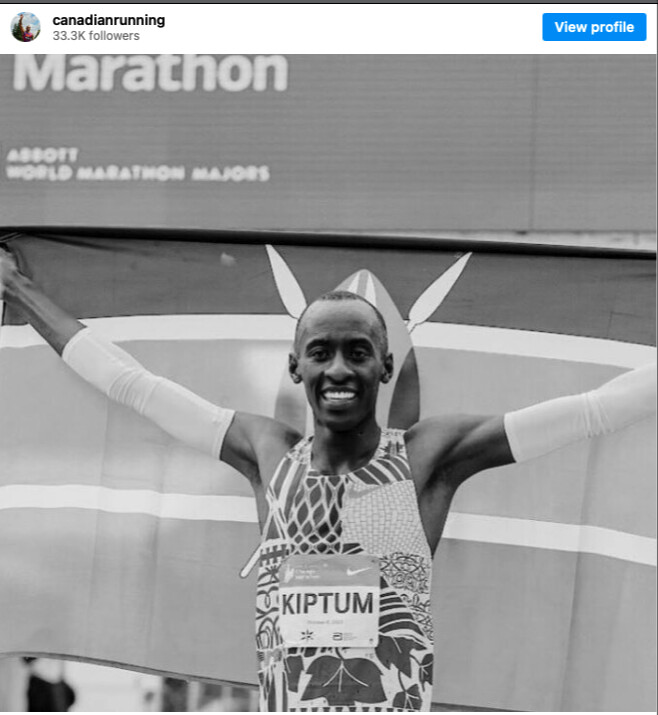
Kiptum had a rapid rise to superstardom in the sport, recording the fastest-ever marathon debut at the Valencia Marathon in 2022. Five months later, he broke Eliud Kipchoge’s course record at the 2023 London Marathon, where he ran an impressive negative split of 2:01:25. Then came the one he’ll most be remembered for–setting a world record of 2:00:35 at the Chicago Marathon last fall.“Athletics world mourns death of marathon world record holder Kelvin Kiptum” — Canadian Running Magazine
After his world-record run, Kiptum said he never felt he was challenged by the marathon distance, and there was a fascination around what he might run in Rotterdam–a topic that will forever be debated, and a question that the world will never know the answer to. The running community will forever remember Kiptum and his drive to show people that anything is possible.
by Running Magazine
Login to leave a comment
Burnout Is Complicated
Kieran Abbotts is a PhD student at the University of Oregon, studying human physiology. He earned his master's degree in Metabolism and Exercise Physiology at Colorado State University. The lab that he works at now studies exercise and environment and stressors on physiology. In other words, he's an expert on how the chemicals in the body work during exercise, and what happens when things get out of whack.
"Essentially, there are two kinds of training. There's functional overreaching, which means you stress the body with hard workouts and long runs. Then you provide adequate time to recover, and you induce adaptations," Abbotts said. This kind of training is ideal-your body is getting stronger. "You want to be functionally overreaching as an elite athlete-so that you're making progress and becoming a better runner, but also giving yourself adequate recovery."
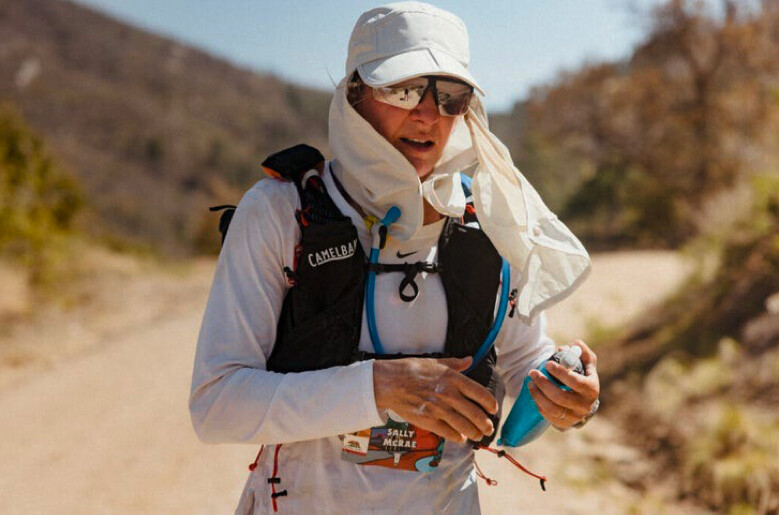
And then there's non-functional overreaching, which can feel the same to many athletes, but it's very different.
"With non-functional overreaching you're essentially doing the same thing-big workouts, stressing the body-but not giving yourself enough time to recover. And so you start doing damage." That damage might take a long time to show itself, Abbots said, but it eventually will.
This might be the most important thing to know about being an athlete at any level. Non-functional overreaching is exactly the same as very healthy training, except without enough rest. And rest is different for everyone, which makes it exceptionally easy to slip from functional overreaching into damaging non-functional overreaching without realizing it. Without adequate rest, the body begins to break down instead of build stronger.
Stress Is Stress
Professional ultrarunner Cat Bradley, 31, living in Hawaii, has experienced fatigue and burnout in various forms, including just after she won Western States in 2017.
Winning a big race is great, but it also means all eyes are on you-the pressure is high to stay on top. "After winning Western States, I took a month off, but I was still running at a high level. And for lack of a better term, I felt like I had a gun to my back," Bradley said. "I wanted Western States so badly, and after I won, so many things happened and I never shook that gun-to-the-back feeling. After a while, it led to burnout. I had to take a mental break."
For many athletes, finding success can be the stress that makes non-functional overreaching feel necessary. How can you take an extended break when you're winning and signing new sponsor contracts?
A second version of burnout for Bradley came when she went through an especially stressful situation outside of running. She was dealing with such extreme daily emotional stress in her personal life that everything else was affected, including running and training. When the body is enduring stress, it doesn't know (or care) what the cause is. We can't put our life into silos. If there's stress in one's life, everything else needs to be adjusted. It doesn't matter if that stress is "just work" or illness, or relationships.
When you're overtraining, or chronically overstressed, your body is creating higher levels of "catecholamines" hormones released by your adrenal glands during times of stress like epinephrine, norepinephrine, or adrenaline. "Having those chronically high levels of overstimulation and not enough recovery, you wind up with a desensitization," Abbotts said. "Overstimulation also causes decreased levels of plasma cortisol. Cortisol is the stress hormone, and it plays a very important role in your physiology."
When you're exercising or stressing the body, cortisol will go up, to help the body deal with the stress. But if you're constantly requiring lots of cortisol, your body will eventually down-regulate. It will adapt and then you'll have low levels of cortisol. This means trouble dealing with physical and mental stress.
In February, Bradley experienced her most recent version of burnout, and it happened mid-race. Bradley was running the Tarawera 100-miler in New Zealand. Besides training for such a big race, she was also working full-time and planning and preparing for her wedding, which was just days after the race. On top of everything, travel to the event was incredibly stressful.
"I was in fourth place, I could see third, and at mile 85, I passed out and hit my head on a rock," Bradley said. "We can talk about the reasons that I fainted, but I really think my brain just shut down-it was too much."
For Bradley, reaching burnout has a lot more to do with outside stressors than the actual running. But now she's aware of that-she continues to work on not reaching the gun-to-the-back feeling. The need to please others. The fear of losing fitness in order to take care of her body. It's an ongoing process, but an important one.
Overdoing Is the American Way
Professional ultrarunner Sally McRae said, based on her observations, Americans are really bad at taking time off. "I've traveled the world and Americans are really bad at resting," she said. "It's part of our work system. You go anywhere in Europe and everyone takes a month-long holiday. You have a kid and you take a year off. We're not conditioned like that in America. It's like you get one week and then after you work a decade, you get two weeks of vacation."
For McRae, avoiding burnout and overtraining has a lot to do with creating a life that's sustainable. She started working when she was 15-years-old, so she realized earlier than most that life couldn't just be working as hard as possible to count down to retirement.
"Perspective is massive when it comes to burnout. My goal every year is to find the wonder and the beauty and the joy in what I do. Because it's my job, but it's also my life," McRae said. "And I really believe we're supposed to rest-it should be a normal part of our life. Whether that's taking a vacation or taking an off-season. I take a two-month offseason and I have for a long time."
One of the most important parts about rest and not overstressing the body is that everyone is different. An overstressed body can lead to hormonal imbalances, which in turn affects everything.
"When you're overtraining, you tend to get mood changes and have trouble sleeping," Abbotts said. "Two of the big things that stand out are you're exhausted but you can't sleep. And the other is irritability-mood swings, and depression." When you get to the point that you've overstressed your body for so long that the chemicals are changing, pretty much everything starts falling apart.
And even though everyone is different, you'd never know that from looking at social media. "I know social media makes it seem like ultrarunners are running 40 miles a day, doing a 100-mile race every other weekend," McRae said. "And that's insane. You've got to be in touch with yourself. It's very different to wake up and feel sore or tired, but if you wake up and feel like you have no joy in the thing you're doing, you need a real break from it."
How Can the Running Community Do Better?
Elite ultrarunner and running coach Sandi Nypaver wants runners to get more in touch with how they're feeling and less concerned about numbers or what anyone else is doing.
"I have to have honest talks with people I'm coaching. I need them to feel like they can tell me how they feel, because sometimes they think they have to stick to the training plan for the week no matter what," she said. "But the plan is never set in stone. It's meant to be adjusted based on how you're feeling. Some weeks we might feel great and not need to change anything, while other weeks we might have to totally crash the plan and do something else."
It's easy to judge ourselves against everyone else, especially when results and reactions are so public and available.
"It's easy to say, 'if that person only took three days off after a big race, and now they're already back to training, that must be what you're supposed to do,'" she said. "But even at the highest level, training is different for everyone. Resting is different for everyone."
"Something that's really, really hard for many runners to understand is that once you're not sore anymore, that you're still not recovered," Nypaver said. "A lot of research says that things are still going on in your body for up to four weeks after, for certain races, depending on the distance."
Sometimes it's difficult to be aware of subtle signs when the soreness is gone. "Convincing people that they need to chill out for a while, even past the soreness, can be really difficult." But after a huge effort, and before the next, people rarely end up saying things like, "I really wish I hadn't rested so thoroughly." Part of it is actually having a recovery plan. Putting rest days on the calendar, focusing on foam rolling and mobility on days that you're not "doing."
"And, actually just relaxing. Taking it easy. It's not just a running model, we live in a culture where we're always being asked to do more," Nypaver said. "I wish instead of always thinking about doing more, we'd focus on how we want to be more. A lot of us want to be more relaxed and less stressed and happier and enjoy our lives. We need to put our attention on that instead of trying to do so much. It's something I struggle with all the time."
We don't get validation for resting, relaxing, and being present because there's no tangible thing to show for it. There's no "be really calm often" challenge on Strava. But the bigger rewards are great. You just have to trade in immediate dopamine hits for a much more balanced, happier life.
Simple, right?
"One thing I'm doing, and asking my athletes to do, is to write down your intentions," Nypaver said. "One of my intentions is to chill out more this summer and enjoy it. I grew up thinking it's all about running, and I have to go all-in on running. But having other outlets, other things that I like to do, is so important."
When you've reached burnout-an extended period of non-functional overreaching, prolonged rest is the only way to let the body fix itself.
"Once you are overtrained, you need to stop training," Abbotts said. "It's just kind of the bottom line. Maybe some people can get away with greatly reducing their training load, but most of the time you need to stop. You need an extended amount of time off."
There's nothing glamorous about rest. There's no prize money in relaxing. But it's the absolute key ingredient in extended performance, and in a much healthier, happier life.
by Trail Runner Magazine
Login to leave a comment
Five tips from top Canadian ultrarunner Jazmine Lowther
Canadian ultrarunning star Jazmine Lowther has worked through some epic highs and challenging lows since she turned pro in 2022. Lowther took the top spot at the 2022 Canyons Endurance Runs by UTMB, followed by a fourth-place finish in the 2022 CCC race at Ultra-Trail du Mont Blanc (UTMB).
While she managed to speed to second at Transgrancanaria 128K in Spain in 2023, she has also struggled with injuries and biomechanics issues. Lowther recently shared five things she wishes she had embraced when she first dove into ultrarunning; newbies and seasoned athletes alike can learn from her wisdom and suggestions.
1.- Befriend your heart rate
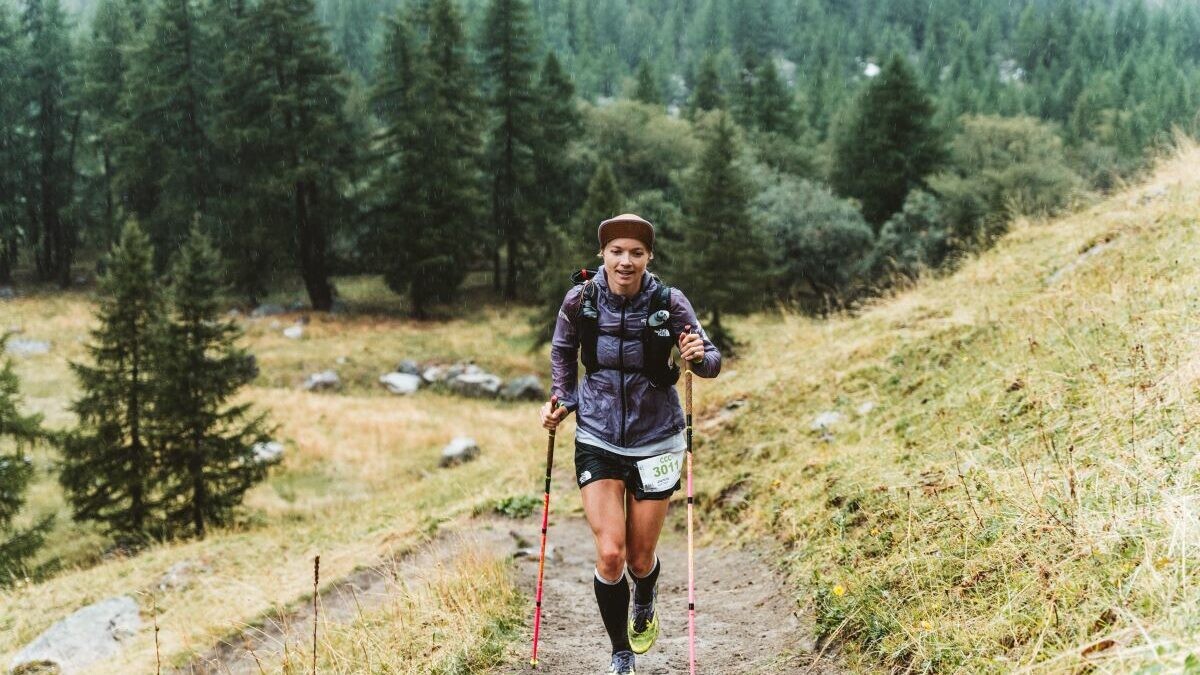
Lowther says she mostly runs by RPE (rate of perceived exertion), but adopting an approach that leans more toward heart-rate-based training has allowed her to “understand my own physiology much deeper, recover properly, and respect pacing.”
Becoming familiar with your heart rate zones can be a valuable skill, and paying attention to your performance metrics, such as pace and endurance, in relation to your zones will help you become a more responsive, tuned-in, healthy athlete. You’ll also be better able to notice if your body needs more rest and recovery time.
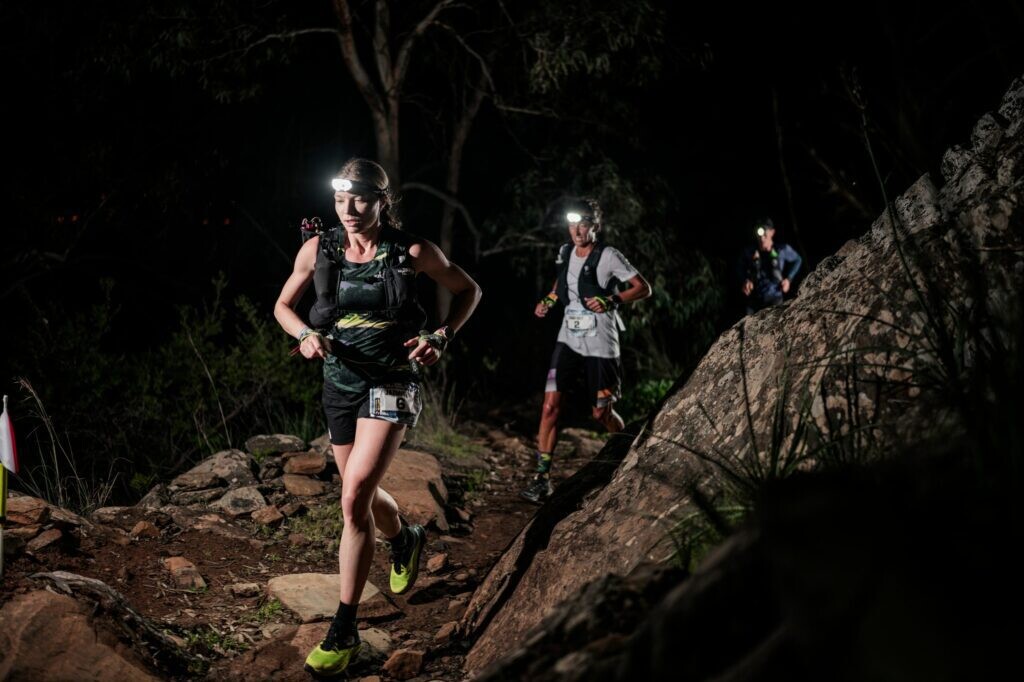
2.- Start a training log
While many runners count on apps like Strava to capture their running data, spending time logging more in-depth information about your training is worthwhile, as it provides unique insights over time. “Strava is great (it has most of my training),” says Lowther, “but it doesn’t include how I felt, what workouts I completed, what I ate before/after, caffeinated, fatigue, etc.”
3.- Wear sunscreen
This one is as simple as it sounds. “Protect thy skin,” says Lowther. “Ultrarunning takes you out there for mega-long hours! Slather up!” While most of us know that prolonged sun exposure during outdoor running can increase the risk of skin damage, including sunburn, premature aging and an elevated risk of skin cancer, it can be easy to forget to reapply after hours on the trails. Wearing sunscreen helps to create a protective barrier, reducing the absorption of UV rays and minimizing the potential harm to the skin, and, as Lowther notes, is an essential precautionary measure (in all kinds of weather) for maintaining skin health.
4.- Find your baseline
Lowther suggests integrating benchmark training runs into your routine to establish an initial baseline. The process involves finishing a predetermined course or distance to use as a reference tool and provides a basis for assessing your performance and comparing it to others in terms of time, pace, or other relevant metrics. “I suppose I’ve done this in an unstructured way (Strava segments anyone?) but seriously, repeating workouts in the same location/distance is great for checking in on things,” she says.
5.- Have patience in the process
Focus on consistency and long-term goals and gains. Consider each run and workout as an investment in your fitness and training bank, even if it didn’t go exactly as planned. “One day at a time, year over year,” says Lowther. “Consistency, is that you?”
by Keeley Milne
Login to leave a comment
7 Legit Benefits of Running At Night—And How To Do It Safely
It was around mile two of the Joshua Tree Half Marathon that I started to hear animals I couldn’t see. Was that a horse? I wondered (and hoped). The daylight was officially gone.
But I realized that as spooky as night running might be, it also creates an eerie kind of magic. Lights twinkled in the valley below the hilly path I was climbing, but all around me it was pitch black, aside from the few feet of sandy trail that each runner’s headlamp illuminated. With nothing else to see, all I had to focus on were my own footsteps and my breath—and how I could race through the desert as quickly as possible.

Amie Dworecki, B.S., M.A., MBA, Amie Dworecki, B.S., M.A., MBA, is a running coach and founder of Running With Life.
Brad Whitley, DPT, physical therapist at Bespoke Treatments in Seattle
Marnie Kunz, CPT2, USATF- and RRCA-certified running coach
Most long-distance races take place in the morning, but this half marathon starts right around sunset. Because the scenery of the course is a tad monotonous, the race organizers embrace the adrenaline rush you can get from running under the stars.
I joined as part of a press trip sponsored by Nathan Sports, Skechers, and Swiftwick. The experience reminded me that even when the days are short during the winter and pushing your pace after the sun goes down becomes the norm, night running can be its own unique adventure.
The more I looked into running at night, the more advantages I found—even if you need to take a few extra safety precautions when you’re lacing up.
The perks of running at night
What are the main benefits of night running? Here are a few of the top reasons to get in a nocturnal workout.
1. The temperature is cooler
Earlier in the day before the Joshua Tree race, I’d been cowering from the heat anytime the sun touched my skin. But once it was dark out, the desert air got so cool that my sweat-wicking T-shirt barely had any work to do.
As it turns out, temperatures around 40° Fahrenheit are ideal for long-distance running, largely because our hearts don’t have to work quite as hard to pump our blood to cool us down, according to a May 2012 study in PLOS One.
Even if the mercury doesn’t get quite that low after dark in a hot or humid climate, night running after sunset (or, alternatively, heading out before sunrise) is clearly the way to go to nab those cooler running temperatures.
2. Your body’s more ready to run
Running shortly after rolling out of bed can sometimes feel like wading through molasses. It’s no surprise why: You’ve just been lying stationary for hours, so your body temperature and mobility aren’t exactly ideal.
3. It might feel easier
The dark can be a secret weapon for runners. One August 2012 study in the Journal of Sport & Exercise Psychology on optic flow (our perception of our movement in relation to our surroundings) suggested that because we can’t see as far in the dark, we feel like we’re going faster because close objects seem to pass by more quickly than those in the distance.
Even though your watch might not record any speedier miles, running in the dark can be a helpful confidence boost when you get the sense that you’re zooming along.
4. Night running can help you sleep
How can running at night affect your sleep quality? Despite rumors to the contrary, there’s some evidence to suggest evening runs might actually help you get deeper zzzs.
An October 2018 meta-analysis in Sports Medicine found that as long as you finish running more than an hour before your bedtime, it most likely won’t mess with your sleep quality. Instead, it could actually help you spend slightly longer in those restorative deep sleep stages.
Anecdotally, some people say they also seem to fall asleep faster.
That’s something to experiment with, according to certified running coach Amie Dworecki, CPT. Everybody’s different, so you might need to find out what works best for your own circadian rhythm.
5. You’re likely better fueled
Eating can be tricky for morning runners—you’ll run better with some food in your stomach, but if you don’t give yourself enough time to digest, you might run into GI issues.
At night, though, you should be fairly well-fueled from noshing all day, Dworecki says. Just be sure to have a snack to top off your carbohydrate stores before heading out the door, says certified running coach Marnie Kunz, CPT.
6. It’s more peaceful
Depending on where you run, during the day you might feel like you’re playing Frogger with traffic and pedestrians, dogs, and baby strollers. At night, most of those hurdles typically fade away.
“It's really almost a meditative experience because of the quiet and solitude,” Dworecki says. “It can really add relaxation to your running.”
7. You have more options
Because you’re less likely to have a certain time you need to be back by at night than you would in the morning, it’s easier to choose your own adventure based on how you’re feeling. You can add a couple extra miles if you feel like it, or end early and walk home instead.
Running at night vs. morning: How to choose
Many runners swear by their morning miles. But obviously, the a.m. hours aren’t the only time to run. How do you know whether night or morning runs will serve you best?
For some people, it’s purely logistical: The best time to get in a run is whenever you can run. But if you have a choice, it might help to pay attention to the natural ups and downs in your energy levels.
“If you're a night person, you can actually feel better or more energetic if you're running in the evenings,” Dworecki says. Or, she adds, you might be able to use running to give yourself an energy boost at a time when it would typically dip.
If you’re someone who needs camaraderie to lace up, one of the benefits of night running is you’re more likely to find a group run to join after the work day, or convince a friend to join you for a few social miles.
Even if you’re alone, night running can also give you more of a thrill than the chore-like approach you might take to morning runs.
“It's kind of an adrenaline rush running at night sometimes,” Kunz says.
On the other hand, running in the morning can be safer because there’s typically more people on the street, and more daylight means you’re more visible to cars.
Running first thing in the morning can also make you more consistent—even if you get stuck working late hours or friends convince you to head out for a happy hour, your workout will already be done.
Safety precautions for night running
1. Make sure you have enough light
Unless you know you’ll be running in a well-lit area, you’ll need to bring or wear your own running lights, Dworeck says.
I ran the Joshua Tree Half Marathon with the lightweight Nathan Sports Neutron Fire RX 2.0 Runner’s Headlamp, which securely attached to my forehead, and gave me 250 lumens of light in any direction I turned. Although it took me a little while to find the right spot on my forehead so it didn’t slip or bounce, once I did, I forgot it was even there.
If the thought of wearing a light on your head doesn’t sound appealing, you can also opt for a chest lamp or carry your own small flashlight. There are even have lights you can put on your shoes or your gloves, Dworecki says.
2. Stay visible to cars
Before the race, I was sent Nathan’s Laser Light 3 Liter Hydration Pack, which has a genius double-duty design that gives you a place to stash water as well as lights on the back in case you’re running anywhere there might be cars.
If you don’t have actual lights on your body, at least be sure to wear bright reflective gear so drivers can easily see you. Light-up reflective vests aren’t your only option—these days, many pieces of running gear stylishly incorporate reflective details, and there are even several reflective running shoes.
3. Consider leaving your headphones at home
Night running probably isn’t the right time to zone out to a podcast. Because you won’t be able to see as well, it helps to keep your other senses sharp.
“Watch your use of headphones just to be aware of what's around you,” Dworecki says.
4. Let someone know where you are
Although running when the streets are quiet can feel less stressful than during busier, noisier parts of the day, empty roads or trails can also be dangerous.
“Let someone know where you're going or share your run so they can track you,” Kunz says.
Apps like Strava let you proactively send your location to select contacts in real time. Alternatively, you can choose to stick to sidewalks or a track where you know other people will be out and about.
How to motivate yourself to run at night
After a long day, forcing yourself to get off of your warm couch and out into the dark doesn’t always sound super appealing. Kunz suggests making a promise to yourself to simply run 10 minutes—it’s just a little exercise snack that doesn’t feel like too much pressure.
“You know you can turn back, but once you're out the door, usually you'll feel okay and just keep running,” she says.
Dworecki adds that for some people, it’s easier to run right from their workplace. When I was training for an ultramarathon, for instance, I used to run home four miles from my office every night so that I didn’t waste half an hour commuting on the subway—my commute was my run (and it only took slightly longer). Then, once I stepped in the door, I could just relax without having to convince myself to leave again.
It can also be helpful to make night running more social by joining a group run or turning it into a date with a friend to catch up after work.
“[It] makes your run more fun and it gives you some accountability,” Kunz says. Even running with a dog can help a night run feel less lonely.
FAQ
1. Do I need a light to run at night?
If you’re going on trails or areas without ample street lamps, you’ll want to bring your own light source with you to make sure you can see where you’re going and what you’re about to step on. The most popular option among runners is a headlamp.
2. Can running at night help in managing stress?
Running is always a good stress release—the extra blood flow to our brain triggers a release of dopamine and endorphins, sometimes leading to the famous “runner’s high.” These benefits might be especially welcome at night.
“It's a great way to kind of blow off steam at the end of the day, and help unwind and relax before going to sleep,” Kunz says.
3. Is it bad to run at 10 p.m.?
Sometimes the only chance you have to fit in a workout is after many people go to bed. Dworecki says that sometimes when she’s struggling with insomnia, she might head out for a run around 1 a.m.
Just know that working up a sweat with intense exercise, like running vs. walking, for instance, will raise your heart rate pretty high, so be sure to give yourself enough time (at least an hour) to wind down after you're finished so it doesn’t mess with your sleep.
No matter when you get back home, do a cooldown, take a hot shower, eat some food, and settle in for the night knowing you’ve gotten all those longevity benefits and health perks.
Login to leave a comment
Bored, Injured, or Experiencing a Plateau? Here’s How to Shake Up Your Running
Plus, coach-approved ways to shake up your training. We’re all for having a set run schedule, considering the ease it can bring to your life. You don’t have to formulate workouts on the fly or do any guesswork over how to reach your goals—simply lace up and follow the plan.
But sometimes, too much structure can backfire, causing you to fall into a rut. And that can zap the joy out of running, transforming the activity you once loved into nothing but negativity.
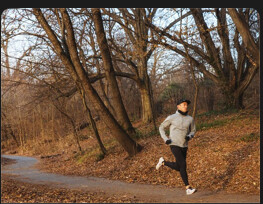
Fortunately, there are simple things you can do to bust out of a rut and get back into a happy running groove. First though, you have to identify that you’re in one.
With that in mind, we tapped two coaches to learn the signs of when you might want to switch up your run routine, and what those signs might indicate. Plus, exactly how to inject excitement back into your runs. Let this be the permission you need to try something new.
1. You Dread Working Out
It’s normal to feel less-than-chipper about an occasional workout, but if you find yourself outright dreading your runs more often than not, “it’s time to reassess,” Kaila DeRienzo, a South Carolina-based certified personal trainer and certified run coach tells Runner’s World.
The potential cause: A few things could lead to dreading workouts. One possible culprit: Your workouts are too challenging because you’ve set a goal that’s unrealistic for your current fitness level, Kai Ng, USATF- and RRCA-certified run coach in New Jersey and New York, tells Runner’s World. Runs and workouts that are too hard cause you to overtrain and ultimately loathe your workouts because all you’re really doing is just beating up your body.
Another potential cause: Other stressful factors in your life, such as a tough work schedule, or demanding caregiver responsibilities, or parenting duties, all of which can make it tough to devote as much time to running as your current training plan dictates, Ng says.
The fix: First, have an honest conversation with yourself to understand why you’re feeling amiss, DeRienzo suggests. By identifying the root cause of your malaise, you can take targeted steps to address it, she explains.
For example, if your dread is tied to a too-lofty goal, such as trying to run four days a week instead of aiming for a more manageable two days or aiming for a PR in a marathon instead of a half or 10K, then let yourself off the hook by lowering the bar. Though it’s great to dream big, it’s also important to be realistic. “Smaller wins are so, so important,” Ng says, as they help build confidence.
If you pinpoint other factors in your life that are making it tough to stick with your current plan, be honest about what you’re actually able to commit to right now and adjust your routine accordingly, Ng suggests. Maybe this isn’t the season to log 50 miles a week, or finally run a marathon. That’s okay. Not every training cycle needs to end with a PR.
Lastly, if you realize the sense of dread extends beyond running and into other areas of your life, you may be struggling with a mental health issue, such as depression. In this case, talk to a trained professional, DeRienzo says.
2. You’re Really Bored
People get into running for various reasons, but one common thread that inspires folks to stick with it is that it engages and challenges them. If you find that your sense of joy about running has evaporated—for example, workouts or races that once felt exciting are now ho-hum—that’s worth looking into.
The potential cause: You may not be challenged enough, Ng says. While all runners should regularly pencil in easy runs, only doing workouts that feel like a walk in the park can lead to boredom.
Alternatively, you may not be injecting enough variety into your routine. Perhaps you run the same route every. single. day. Or you carbon copy your workouts week after week. That level of monotony can also lead to boredom.
The fix: First, evaluate your fitness to get a solid sense of your current abilities in order to help figure out how to best challenge yourself.
“Whether it is a fitness test, a time trial, a race, get out there and see where you’re at and how you stack up,” Ng says. From there, level up your plan as needed. You might want to talk to a coach for some helpful guidance.
On the other hand, if you suspect your boredom is due to monotony, shake things up by exploring new running routes (Strava can be a great tool for this), joining a local run club (Ng suggests trying out a different one each week), or experimenting with different types of workouts. This could look like venturing out on trails if you’re typically a road runner or challenging yourself to run hills if you normally go flat.
Dabbling in forms of exercise outside of running, such as swimming, cycling, dance, and Pilates—really whatever tickles your fancy—can also help add variety and excitement to your schedule.
Finally, you can also reignite your spark with running by treating yourself to something novel, like a fresh pair of shoes, a snazzy new training outfit, or a fancy fitness tracker. “Getting something new always shakes things up,” says Ng.
3. You’re Dealing with Injuries
According to 2021 study published in the Journal of Health and Sport Science, 50 percent of runners experience some type of injury every year that prevents them from running for a period of time, and 25 percent of runners are injured at any given time. These injuries can range from shin splints to ankle and knee problems.
In other words: Almost every runner deals with injury at some point, but if ailments continuously crop up, that’s a surefire red flag your plan needs adjusting.
The potential cause: Chances are, you’re overtraining by either running too many miles, logging too many high-intensity runs, or not allowing your body enough recovery time in between sessions, Ng says.
The fix: It’s common sense, but it bears repeating: Don’t train through injury. Instead, scale back your running to allow your body time to heal. Seek help as needed from a physical therapist or coach to fully mend the issue and get their guidance on how to avoid future injuries.
Keep in mind that factors like poor sleep and inadequate nutrition can increase your odds of injury, so take an honest look at your overall lifestyle and make adjustments as needed.
4. Your Progress Has Stalled
If, despite consistent efforts, your performance in workouts and races has stagnated, then it’s high time to re-evaluate your current plan.
The potential cause: You may be overtraining or struggling with a nutrition issue, says Ng, both of which can sabotage performance because your body isn’t getting the recovery it needs. Or, quite possibly, you don’t have enough variety in your routine, DeRienzo says.
Over time, your body adapts to the work you demand, and if you don’t routinely challenge your body in novel ways, eventually you’ll stop seeing progress.
As the American Council on Exercise explains: “Doing the same exercise repeatedly could lead to a plateau where no more physiological changes occur.”
The fix: If you suspect you’re plateauing due to overtraining or nutrition problems, dial back your mileage and/or workout intensity and focus on eating frequent, well-balanced meals.
Also, inject other types of exercise into your schedule. “Move in different ways,” says Ng, explaining that most any type of cross-training movement—from strength training to skiing to swimming to yoga—is beneficial for runners. Because running is such a linear sport (you move in just one direction: forward), taking the time to build your strength and athleticism in other ways can ultimately make you a stronger, more resilient runner.
Now, if you realize your stagnation is due to an unchanging run routine, spice things up however you can: Add speed work, hit the hills, challenge yourself to run longer, or try new interval workouts. “Having something new and exciting to look forward to each day of the week is going to keep it mentally stimulating and also keep your body stimulated, too,” DeRienzo explains.
5. You Don’t Feel Confident in Your Workouts
If you don’t have a training plan, have low confidence in your program, or are unsure if the schedule you’re following is inching your toward your goals, it’s time to rethink your approach.
The potential cause: Choosing the right training plan for you and your goals can help you feel accomplished by checking off workouts one by one. Plus, it will give more structure to your training so you get the right mix of intensities within your workouts and the right amount of rest—rather than simply winging it. If you have a plan, but it’s too generalized and not personalized to you, says DeRienzo, it may also leave you feeling less than confident in your training. “What somebody else does is not going to be the most beneficial” for your situation, she explains.
The fix: Find the right training plan for you by determining your fitness level and your goals. (You can also use our quiz to point you in the right direction.)
If you're serious about becoming a better runner, you might also consider hiring a coach—even for just a few months—to get personalized guidance and a curated-for-you plan.
“There’s a myth that run coaching is super expensive,” says Derienzo. Truth is, “it’s a lot more affordable than personal training,” she says, noting that in her experiences, it’s realistic to find support for less than $100 per month. Search platforms like CoachUp, Training Peaks, and RunDoyen to connect with a pro.
6. You’re Missing Workouts
While skipping a run here and there is NBD, if you’re consistently bailing on workouts, then your run plan clearly isn’t working for you.
The potential cause: Life is probably too busy right now to sustain the level of running your plan requires, says Ng. Or, you may just need more rest. Either way, your current approach just isn’t appropriate for your schedule or fitness level.
The fix: Take a close look at your schedule and map out which days make the most sense to do which workouts, says Ng. For example, instead of attempting long runs on Sundays like everyone, you might realize Wednesdays are more ideal since you don’t have any work meetings then. Or, perhaps Friday becomes your new strength training day instead of Tuesday, since the gym is less crowded then, making it easier to get in and out.
Taking the time to rejigger your plan so that it actually makes sense with your schedule will increase your likelihood of sticking to it—and ultimately, seeing results.
Of course, if you’re missing workouts because you really feel like you need it (or you’re injured), then it’s best to scrap your plan entirely and allow yourself the downtime you need to heal.
Finally, if it’s your mental motivation that’s making you miss most of your planned runs, it’s probably time to take a break. “Get a breather and gather yourself,” says Ng. By putting distance between yourself and the sport, you can get a clearer picture of what you ultimately want to get out of running.
by Runner’s World
Login to leave a comment
Four things runners should stop worrying about
There’s a lot of weird pressure in the running world to do certain arbitrary things, like log massive amounts of weekly mileage, run fascinating routes and document (or not document) all of it, update your watch every few months—the list is endless.
If you’ve ever felt slightly “less than” as you discussed your passion for creating artsy routes on Strava with someone who has decided to delete the app and “feels freer than ever,” you know the feeling. Maybe you love poring over the splits in your last hard workout, maybe you don’t worry about pace at all—either way, you’re an awesome runner. Here are five running “rules” to stop worrying about this year.

1.- It’s OK to love data (or hate it!)
Whether you’re hooked on wearable tech, subscribed to multiple running apps and geek out over data or you’re rocking a decade-old GPS watch with no idea what KOM means—it doesn’t matter. Embrace your running style, and ignore anyone who tries to make you change teams.
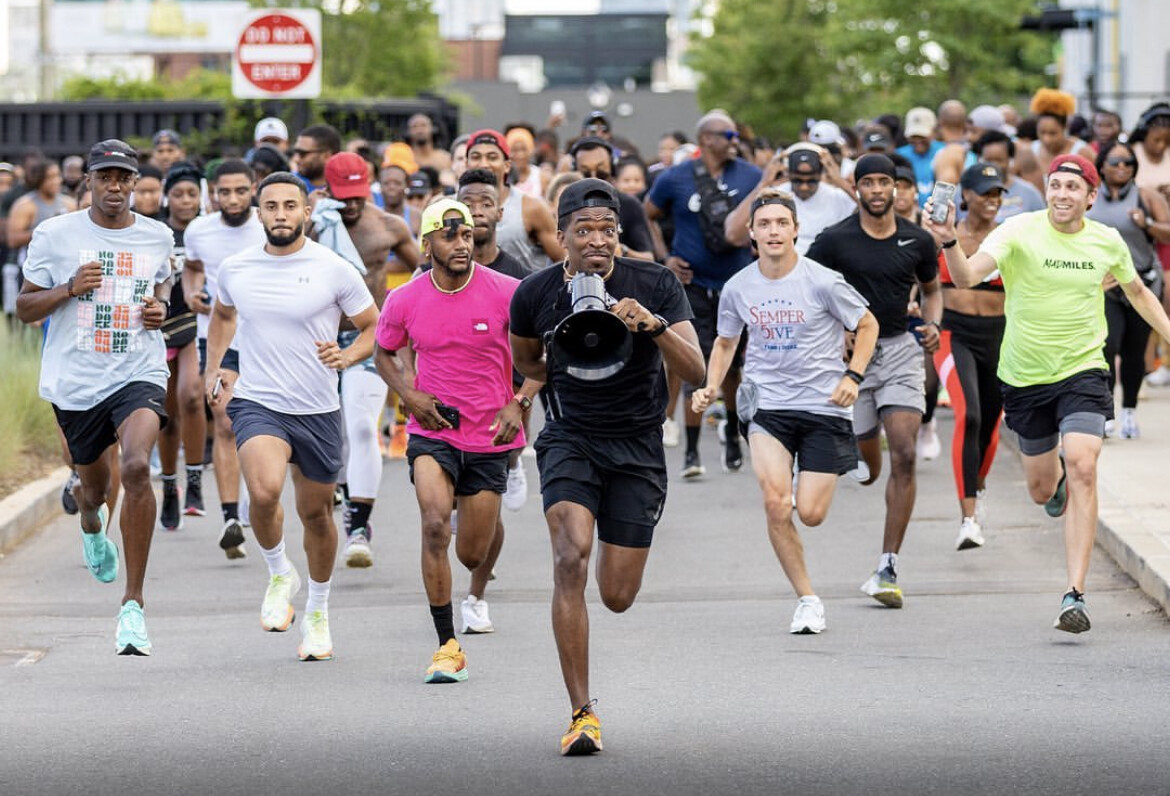
If you’re on the tech-friendly team, you probably gain valuable insight from perusing Strava, and if you’re the back-to-basics type, you never have to stress if you forget to charge your watch or have your Local Legend title stolen. Data lover or tech minimalist, the choice is yours, and there’s plenty we can all learn from each other.
2.- Run wherever you want
When my kids were teenagers, I got in the habit of never running too far from home. They often needed something, and I wanted to be able to help them out without a lot of stress and logistics. Now that they’re out of the house, I still gravitate to those same, loopy routes near my house. Hey, I’m close to snacks, a washroom and extra mittens.
Recently though, a fellow runner questioned my running routes on Strava.”Why do you always stay so close to home? There are trails all over the entire city,” he said. I felt bad about my chosen routes for a few minutes, and then I realized: it’s OK to run wherever you want. Whether it’s loops around your block or an epic FKT adventure across town—your run, your rules. Forget the naysayers—be proud of your chosen paths, be they familiar loops or exploring every nook and cranny of the city. There’s no wrong way to enjoy the run.
3.- Run whenever you want
For years, I desperately wanted to be an early-morning runner. Whenever I managed to get out the door at the crack of dawn, I would gloat about it all day. If you’re like me: stop that. Morning, noon or night—pick your run time and own it. No more feeling superior for being an early bird or guilty for not fitting into the “ideal” time slot.
Whether it’s a lunchtime jog or a midnight run, celebrate moving your body whenever it feels right for you. Run on your clock, not anyone else’s.
4.- Walk like a runner, talk like a runner
New runners, listen up: walking is not the enemy! Forget the pressure to ditch walk breaks. Whether it’s long strolls, quick breathers, or a mix of both—you’re still a runner. Brendan Leonard, author of I Hate Running and You Can Too, nails it: “Allowing yourself to walk makes running less daunting, less restrictive, less all-or-nothing. There are no rules, and no one’s keeping track but you, so figure out what works and use it to log some miles.”
by Keeley Milne
Login to leave a comment
Strava's Year in Sport reports Gen Z's like running short and fast
Is the era of high-mileage runs a thing of the past? Strava, the globally acclaimed GPS and fitness tracking app, has just released its year-end trends report, and the findings are interesting. Running once again claimed the title of the most popular activity upload, but what caught everyone’s attention was the distinct running behaviour of different generations, especially the shorter runs by Gen Z’s.
Gen Z, aged 11-26, emerged as the speed demons, boasting the fastest average pace (5:14/km) among the four generations surveyed. However, what turned heads was their knack for shorter runs, with an average distance of 5.3 kilometres (3.3 miles). In a surprising twist, baby boomers, aged 57-75, may not win the speed race, but they certainly win the endurance marathon, consistently logging the longest average run of 6.4 kilometres (4 miles).

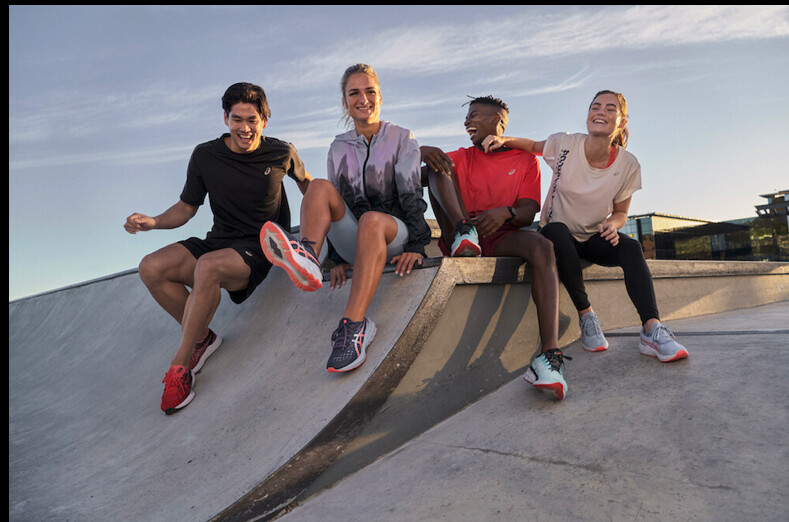
According to Strava’s report, Gen Z not only sprints but does so with a purpose—athletic performance. These younguns are the least likely to exercise for health alone, preferring the thrill of competition or the camaraderie of friends, run clubs or group fitness activities. Time and work emerged as their primary constraints, a testament to their busy lifestyles and limited time for exercise.
The Year in Sport data was compiled from Oct. 1, 2022, to Sept. 30, 2023 and included insights from 6,990 respondents worldwide. Boomers, in contrast to Gen Z, leaned towards cycling, being twice as likely to upload rides than runs. Gen Z, on the other hand, flipped the script, almost doubling the likelihood of uploading runs compared to rides, reflecting the surge in race participation in 2023.
This trend among Gen Z isn’t an isolated finding. A 2022 U.S. census report revealed that nearly 60 per cent of Gen Z adults engage in running or jogging for fitness at least once a week, far surpassing the general population’s 26 per cent.
Strava’s report also sheds light on the evolving landscape of athletic footwear preferences. Hoka, On and Asics emerged as top choices on Strava in 2023, indicating a growing affinity for newer and innovative athletic brands among runners.
While running dominated uploads on Strava for the second consecutive year, the rise of trail running and hiking is a noteworthy trend, experiencing a remarkable 20 per cent increase from 2022.
Login to leave a comment
New Chipotle and Strava challenge offers a year's worth of free bowls
We’re only a few days into 2024, and the fast-food chain Chipotle Mexican Grill and Strava have already released the collaboration of the year. Runners, brace yourselves for a potential year-long supply of free Chipotle Lifestyle Bowls–all it takes is to become a Local Legend on a few Strava segments.
Chipotle spilled the beans in a recent study, confirming that nearly seven out of 10 consumers are avid runners who make Chipotle their go-to post-training treat. Joining forces with Strava, they’ve rolled out “Chipotle segments” –exclusive stretches of roads and trails where athletes can compete for glory, chasing the fastest times and efforts on the leaderboard. Here’s the twist–the athlete who holds the Local Legend title in six U.S. cities will receive free Chipotle Lifestyle Bowls for a year.

Local Legends are Strava’s nod to dedicated athletes. They crown the person running a particular segment the most times in a rolling 90-day window. It’s not about pace or speed; it’s about pure dedication.
“Runners chase popular Strava segment in Denver airport” — Canadian Running Magazine
This sizzling promotion lights up in New York, Los Angeles, Chicago, Washington D.C., Denver and Columbus, Ohio. But fear not, Canadian runners! Let’s crank up the buzz on Chipotle socials and try to bring this epic challenge to cities across Canada. The race is on from Jan. 2 to 31, 2024.
If you don’t live in, or aren’t visiting, any of the six cities anytime soon, Chipotle has come up with another contest for everyone with the “No Quitters Challenge.” Launching on Strava on Jan. 15, this worldwide streak-based challenge rewards fans committed to healthy habits post-Quitters Day, Jan 12. Completing the challenge earns you a shot at a free side of guac, redeemable at any Chipotle Mexican Grill, if you can log at least 40 minutes of activity each week on Strava from Jan. 15 through Jan. 28.
by Running Magazine
Login to leave a comment
Your Successful Race Season Starts Now
We looked at thousands of data points on Strava to determine what winter habits make for a successful summer season
In our monthly column in partnership with Strava, we take a deep dive into compelling data points that reveal the more human side of sport.

While summer race goals might feel far off, athletes know winter is an important time to commit to consistency. With new year’s resolutions right around the corner (see our recent column on how to meet your yearly mileage goals), we looked at how the most consistent runners use their winter season to get stronger and faster.
Cross-Training Can Help Athletes Stay Consistent Through the Winter
Consistency is key for progressing training and minimizing injury risk. Staying consistent can help you avoid injury, and avoiding injury helps you stay consistent.
Muscle fiber growth and recruitment is improved with consistent stress and recovery cycles, and you don’t need huge efforts to reap the benefits. Short bouts of running (even just 10-20 minutes a day) can produce adaptations down to a cellular level. Consistency is also critical for aerobic and metabolic adaptations, helping your body more efficiently transport oxygen-rich red blood cells to your muscles via capillaries through increased capillarization, a process known as angiogenesis.
When it comes to winter training, don’t let perfect be the enemy of good. Twenty to thirty minutes on a treadmill or running in the snow is always better than zero (in the context of good health and recovery).
Suppose your goals are primarily to stay healthy and active through the winter. (While we didn’t assess how cross-training affects fitness or speed, it can be assumed that increased consistency and activity frequency usually correlate with improved speed, fitness, and health.)
In that case, cross-training can be an important part of your winter training regimen. Most runners on Strava don’t just run. Seventy-five percent of runners cross-train in the summer, too, using activities like outdoor cycling, walking and hiking to increase their activity frequency.
Runners who cross-trained in the summer had a 20 percent higher chance of staying active through the winter. Eighty-nine percent of athletes who cross-trained in the summer continued to be active throughout the winter, compared to 74 percent of athletes who didn’t cross-train through the summer and continued to be active in the winter.
Consistent athletes stay consistent through the winter. Twenty-four percent of athletes who run three times a week continue to hit that cadence in the winter, while 58 percent further reduce frequency. Fifty-two percent of athletes who run seven times a week in the summer continue to do so in the winter, with only 48 percent reducing run frequency. Still, half of all committed runners scale back to an extent in the winter, but more on that later when discussing offseasons.
While many runners may not be thrilled to take their runs indoors and onto the dreadmill, consistent athletes gravitate towards the treadmill when conditions are tough.
The share of indoor runs doubles from December to February on Strava, with 16 percent of all runs occurring indoors. The treadmill can be a great training tool for athletes, with elites like Elsey Davis logging significant ‘mill time before her Golden Ticket win at UTMB’s Val D’Aran.
According to Strava, winter cross-training also moves indoors, with activities like indoor cycling, strength training, and walking as the most popular cross-training options.
While there’s been much discussion about what constitutes an off-season and the benefits for athletes, Strava data shows that many highly committed and consistent runners take a down-season from higher volume.
Data suggests a modest off-season won’t set reasonably consistent runners back too much, but that athletes who are already running at a moderate to low volume (less than five times a week) should focus on maintaining a base of consistency through the winter rather than rushing to take time off of already low volume.
We’re not saying don’t take time off. Winter can be a great time to emphasize cross-training and strength training and enjoy a new mix of winter sports. But the higher your healthy volume is coming into the winter, the more flexibility athletes have to add additional winter activities into their training without sacrificing fitness. The athletes who have the most success (defined as returning to consistent running come summertime) put themselves in a position to jump back into spring training with a bit of a base.
Ideally, runners shouldn’t need more than a few weeks to get back to their main-season training volume. Swings in training volume increase the risk of injury, and weeks spent “getting back in shape” are less effective at progressing your training forward.
Runners who reduced running volume (defined in average weekly distance) in the winter by 1-10 percent averaged within ten percent of their summer average mileage in spring (March-May). Runners running three times a week in summer who reduced volume in winter by 1-10 percent were still able to put in spring training weeks just seven percent shy on average of their summer mileage.
Usually, this difference is a few miles a week, which is fairly easily re-established. On average, runners who ran five times a week remained within ten percent of their summer average mileage. Runners who reduced volume by 11 to 25 percent were still able to build back effectively in the spring, with three-time-a-week runners only 14 percent behind summer volume and five-time-a-week runners 19 percent behind their summer average.
Runners who reduced volume by 50 percent or more struggled to make up the volume come spring. Three-time-a-week and five-time-a-week runners couldn’t effectively bridge the gap in spring between their winter off-season and summer volume.
In winter, of runners who run three times weekly during the summer, only six percent stop being active altogether, suggesting that many fall back on indoor cross-training activities. Even among athletes from this group who paused running in the winter, 64 percent still logged at least one non-running activity per week. Of runners who average seven runs a week during the summer, there are still low inactivity rates (only eight percent halt activity completely), but only 23 percent of the group average at least one non-run activity a week.
In sum, folks who don’t cross-train don’t have much to fall back on in case of injury or crappy weather, and having a cross-training option that helps you stay active in those scenarios can help you stay more consistent and support your running in the long-term.
Staying on track for a goal is a tough line to walk. In 2022, 22.8 percent of Strava users who set yearly mileage goals finished within 80 to 90 percent of their goal. So close! Thirteen percent were within 10 percent of their goal. For folks within a stone’s throw of their yearly mileage but didn’t quite make it, here are some data-driven tips to make 2024 your most consistent year of running yet.
by Outside Online
Login to leave a comment
How to Train For Any Race Using Short Distances
When stepping up to a new distance, it can help by focusing on short intervals you're familiar with.
Up. Tap the pole. Down. Tap the Bridge. Up. Tap. Down.… Over the weekend, on one of many hill-repeat sessions, I came to the realization that the majority of my training for a 200-mile trail race through big mountain terrain has been on a single mile. It’s not even a trail, and, in fact, some of it is even paved. How can I possibly prepare for such a big goal on such seemingly wildly inappropriate training grounds?
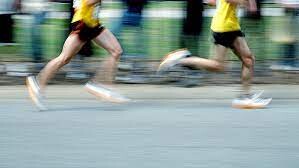
There was a time when I could go out on any given weeknight and run for three or four hours. But: life. Now I find myself having to balance running with family obligations, keeping a new dog from chewing up all my shoelaces, and doing work on a new home. And it’s so easy these days, especially with Strava and social media, to fall into a trap of comparing my own training to people putting in loads of miles in the Alps or the Rockies. But the reality is no matter what goals we runners are training for, we have to work with what we’ve got. A few years ago, when COVID shut down my local trails, I found myself turning to a few of these short segments, and ping-ponging from end to end purely because there was nowhere else to go. While it was not the most scenic running I’ve ever done, I found myself getting stronger physically and mentally. It turns out I inadvertently adopted a training concept known as “chunking” in place of doing big majestic loops.
By necessity, I found out that I train better when I take a big, ambitious goal and break it down into things that seem reasonable: Each run or workout chips away at the goal, taking something that at the outset seems like a massive weight and bringing it down to something more manageable, more recognizable—like a carver tapping away with a chisel. No matter how small of a hill you might have to train on, or even if you’re confined to a track, or maybe not running at all due to injury—even the smallest chip you can manage whittles away at that giant block.
Two hundred miles is of course an extreme example, but when I first started running, as with so many runners, even a single mile sounded impossible. Even if you start with just one minute of running, you are breaking down whatever bigger goal you might have. For me, on race day, no matter what distance I’m doing, as the miles add up and the legs and lungs burn, I know I can focus, just as I did in training, on hearing that next tap.
Pat Heine-Holmberg, Runner’s World’s Senior Video Producer, spends more time on trails in pursuit of going farther and higher than he does faster. PRs racked up during the 2023 Tor des Géants include earliest time to vomit (mile three), most ice cream eaten during a race (four bars), and worst night of sleep (an hour on the floor in an under-construction sports center).
by Runner’s World
Login to leave a comment
The ‘Taco Bell 50K’ Requires Strong Legs—and a Stronger Stomach
Every fall, a group of Denver runners celebrates National Taco Day by running 31 miles using the fast food Mexican chain as aid stations
Imagine you’re 12 miles into a running race and you arrive at an aid station, where, instead of refueling with energy gels, you’re required to eat a 540-calorie Taco Bell Crunchwrap Supreme.
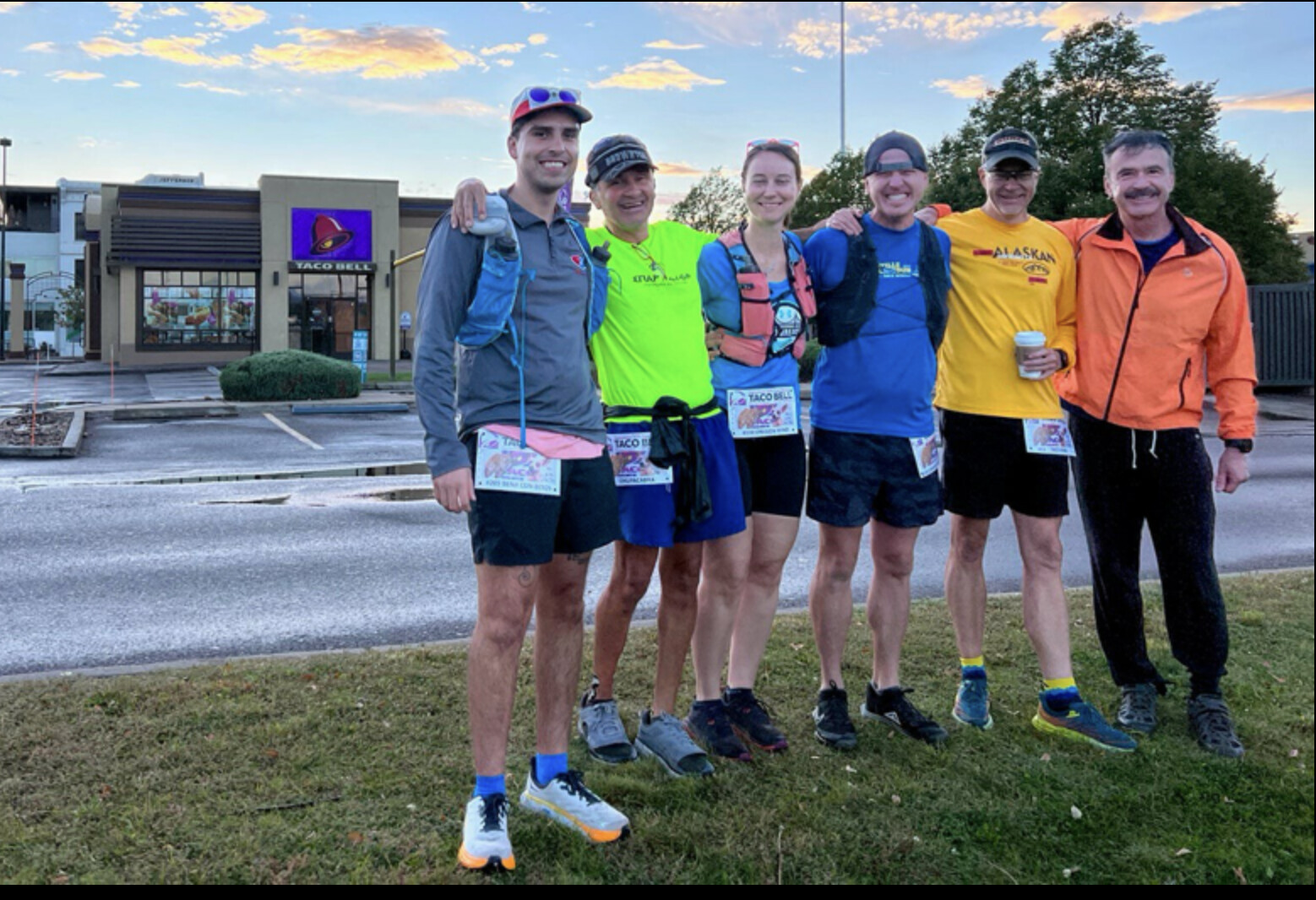
Yes, that’s one of the mid-race snacks you’ll need to consume if you want to be an official finisher of a bizarre and spirited, 31-mile run through the greater Denver area.
Welcome, if you dare, to the annual Taco Bell 50K Ultramarathon.
What started as an offhand suggestion on a Saturday morning training run has now become a stupid and fun gastro-intensive ultra-distance event with 10 “aid station” stops at various Taco Bell restaurants. But, as silly as it seems, it’s all about sharing the community of running, says founder Dan Zolnikov.
Held every October for the past six years, and loosely coinciding with National Taco Day (yes, that’s a thing), it’s an unconventional and entirely unsanctioned fun run that has several ridiculous rules—a.k.a. the semi-optional Taco Bell 50K Commandments that are printed on the back of the event’s race bibs—including the need to eat something from the Taco Bell menu at every stop.
While that could mean consuming something small at most of the restaurant visits—like, say, an order of Nacho Fries or Cinnamon Twists—the fourth and eighth aid stations demand a higher level of gastrointestinal fortitude. At those stops, participants must opt for one of the larger and more calorie-intensive “Supreme” menu items, such as a Crunchwrap Supreme, Burrito Supreme, or Nacho Cheese Doritos Locos Tacos Supreme.
“I always tell people it’s fun until the fourth stop,” says Zolnikov, a Denver lawyer and avid ultrarunner who started the event in 2018. “Most of those that are new to it are like, ‘Wait, I’ve gotta eat a Chalupa Supreme or a Crunchwrap Supreme and then keep running for almost 20 more miles?’ And we laugh and say, ‘Yep! That’s what we do.’ Honestly, that’s when a lot of people are like, ‘I think I’m just going to go home.’”
Running the Taco Bell 50K is what many ultrarunners call out-of-the-ordinary Type 2 fun—something that conceptually sounds fun before and afterwards, but in actuality is not quite that fun while it’s happening. But word has gotten out and it’s been compelling enough to have grown to a record 40 participants this year. There’s no entry fee, but each runner is expected to pay for their own food.
While the Taco Bell chain of 7,000 Mexican-themed fast food restaurants isn’t a sponsor of the event—and the event organizers explicitly remind participants of that—a Denver-based Taco Bell franchise group agreed to open one of its locations early this year to accommodate the 7 A.M. start and welcome runners with free breakfast burritos, thanks, in part, to the persistent prodding of Jason Romero, one of the event’s original instigators.
Not just a zany group run, the Taco Bell 50K is rooted in ultrarunning lore and takes cues from some of the country’s most famous races. Not only does the course alternate between clockwise and counterclockwise every other year—a la Colorado’s Hardrock 100—it also requires runners to keep their Taco Bell food wrappers as an ode to how runners need to tear a page out of hidden books on the Barkleys Marathon course.
While Leadville 100 luminary Ken Chlouber has famously motivated runners for 40 years by saying “You’re better than you think you are, you can do more than you think you can,” Romero says the motto of the Taco Bell 50K is that “you’re hungrier than you think you are, and you can eat more than you think you can.”
How does a convoluted event like the Taco Bell 50K get started in the first place? At a farmer’s market, of course.
During long Saturday morning training runs in the spring of 2016, Zolnikov and running buddy Mike Oliva developed a habit of refueling by eating fresh, Colorado-grown or locally crafted food at Denver farmer’s markets. On one run, Oliva randomly stopped to use a bathroom at a Taco Bell and suggested to Zolnikov they should consider changing their route the next weekend and make Taco Bells their impromptu aid stations.
“As soon as he said it, we laughed but then there was this awkward, five-minute silence between the two of us,” Zolnikov recalls. “We were just kind of jogging along and not really saying anything, but he said it so it was out there. I think we realized it was a stupid idea, but, as ultrarunners, we kind of wanted to do it. So I asked him, ‘Do you want to do that next week?’ And he was like, ‘No dude, just forget I said anything. Let’s just forget it.’”
Although the idea never conjured up mouth-watering excitement, the odd craving to do it never went away. The banter about the idea continued on their Denver running Facebook group, as well as at weekly training runs of the Denver chapter of Achilles International, a running club in which runners with disabilities are guided on weekly training runs and weekend races.
Oliva started that group in 2013, and it has met for weekly runs at Denver’s Washington Park every Monday night for the past 10 years, developing an easy-going camaraderie between guides and runners.
“This talk about running to Taco Bells went on for about two years, and finally I got sick of hearing the trash talk, and just said, ‘That’s it, we’re doing it,” says Romero, 53, a regular Achilles runner who is legally blind. “And as soon as I said it, it kind of got silent. But I’m not about talking, I’m about doing. So I said, ‘You put together a course and we’re going to do this.”
Within a few days Zolnikov had plotted out a course using Google Maps and Strava, connecting nine Taco Bells in the Denver metropolitan area in a 31.52-mile loop. (To make it an even 10 aid stations, the event starts and finishes at the same Taco Bell on the southwest side of the city.) And then, a few weeks later, in October 2018, seven courageous runners gave it a go and five finished in about seven and a half hours. (The other two tapped out, waving the white napkin of surrender midway through the route.)
Although it was mostly a celebratory season-ending fun run among a core group of friends for the first few years, it has garnered more interest as word of mouth spread. A few of the Achilles runners have joined in the fun every year.
“It’s not a glamorous route,” says Ben Garrett, who took over as race director after running the Taco Bell 50K for the first time in 2022. “It’s kind of what you’d call an urban ultra through the ‘scenic’ parts of Denver.”
Garrett, a 25-year-old structural engineer, was training for his first marathon when he was cajoled into joining the Taco Bell 50K—despite never having run more than 16 miles. He joined willingly and finished, giving him a boost of confidence heading into the Disney World Marathon three months later.
“It was great to know I could run that far before my marathon, especially knowing I had a stomach of steel after that,” Garrett says with a laugh. “But it also inspired me to run more. After my first marathon, I did another marathon and then a couple of 50Ks. Now I’m hooked for life.”
There are no winners, and there are no prizes. Instead over the years, runners have piled on extra gastrointestinal challenges for extra satiation.
There’s the Baja Blast Challenge, which entails only imbibing two liters of Mountain Dew Baja Blast during the run, and then there’s the Diablo Challenge, which consists of oozing a packet of Taco Bell’s next-level hot and spicy Diablo Sauce on every single food item throughout the run. (By the way, two of the more precarious event rules state that no Pepto Bismal, Alka Seltzer, Pepcid AC or Mylanta will be allowed on the course, and the bathroom stops are only allowed at the Taco Bell restaurants.)
As if consuming 1,500 calories during the run wasn’t enough, some runners have added their own challenges—such as devouring a Voodoo Doughnut during the middle of it—and many runners engage in the Diablo Shooter Challenge, which is simply sucking down a packet of the restaurant’s fiery hot sauce to conclude the run. But to be fair, one of the forgiving commandments is the notion that every runner can take a mulligan and skip eating at one of the stops.
“It’s just meant to be a fun run,” says Denver runner Bill Garner, who has participated in five of the six Taco Bell 50Ks. “It’s the one ultra where you’re just really out there for the camaraderie. I don’t really feel like anybody’s racing, although I’m sure somebody’s going to show up one year and try to run it all-out. But for most of us, it’s a big camaraderie run.”
It is mostly about the community spirit that pervades running, but for Garner, the Taco Bell 50K inspired him to run farther and pursue new running goals. Prior to participating in the first event in 2018, the 53-year-old cybersecurity technology specialist and strict vegetarian primarily ran marathons and half marathons on the roads. Since then, his focus has become ultra-distance races on trails, and believe it or not, he typically relies on cold Taco Bell bean-and-cheese burritos in his aid station resupplies.
“It’s the perfect ultra fuel,” says Garner, who consumed numerous Taco Bell delicacies enroute to finishing the Kansas Rails to Trails 100-miler in 2019.
“I thought these ultrarunners were crazy, and I jumped into this because it was crazy, but then it changed my life,” he says. “I had never run an ultramarathon before I did the Taco Bell run, and I definitely learned that, if you just keep eating, you can keep going. That’s what ultras are all about.”
A few years ago, Portland, Oregon, runner Bobi Jo Ousnamer befriended several Colorado runners in an online forum while training for the Pikes Peak Marathon. They told her about the Taco Bell 50K and asked her to come out and run it in 2019, but she couldn’t fit it into her schedule because she was training for her first 100-miler.
However, she made it out for the 2020 edition, amid the Covid-19 pandemic. (That year, a small group of runners ran through Taco Bell drive-thrus to order their food because the inside dining areas weren’t open.) During the run, she admitted she had devised her own Taco Bell 50K course in Portland. That immediately sparked interest in doing Denver and Portland events on back-to-back days, which they finally pulled off in 2022 on the day of the Portland Marathon.
That event included stops at seven Taco Bells and a marathon aid station a friend organized on her front lawn, where they devoured homemade breakfast tacos. Calling it the Double Deuce Challenge, it included 62 miles and 18 taco stops in two cities in less than 36 hours.
“I made the mistake of mentioning to Jason Romero that I had created a Portland course and he was like, ‘Oh my God, we’re doing a double!’” says Ousnamer, 34, who works as a juvenile public defender in Portland. “So for the fifth anniversary, he announced that we’d be doing this double. I think we all thought he was kind of joking, but as the months went on, he was like, ‘All right, I’ve got a plane ticket so we’re doing this.’ The Taco Bells are not as close together as the Denver ones and it’s hillier in Portland, so it was a bit of a bigger challenge. We were definitely feeling it on day two.”
Although the Taco Bell 50K has always meant to have been a low-key, end-of-the-season celebration for local runners, it’s continued to gain notoriety and to push the envelope of what’s possible. Runners in Texas and New Jersey have reached out about developing something similar, as have a couple of running clubs in Europe. Although the event details were typically only posted on Facebook when Zolnikov managed it, Garrett upped its visibility and inclusivity by developing an informational website with a link to the Strava map of the course.
Will the Taco Bell 50K continue to grow?
“Honestly, I never wanted to see it start to begin with, but it’s kind of turned into this force of nature that’s bigger than me and bigger than Jason, and it’s become its own thing now,” Zolnikov says. “People can use it for whatever they want it to be, and if someone wants to get bragging rights for racing through it as fast as they can, go for it. My thing has always been about getting together and running, and, OK, ‘Let’s do this kind of dumb thing, and let’s have fun doing it.”
by Outside Online
Login to leave a comment
Strava introduces messaging feature
Move over Instagram DMs… Strava has officially dropped its long-awaited messaging feature. No need to run between apps to connect with your running crew or reach out to your running crush on Facebook or Instagram; now, you can do it all in one place.
Strava’s grand plan behind this upgrade was to create a seamless avenue for athletes to co-ordinate adventures, share inspiration, swap training tips and more—all within the unified platform.

As of Monday, the messaging feature will be available for all Strava users (on mobile only). Look for the speech bubble icon in the top right corner of the Strava home screen and group tabs. If you can’t find it, restart your Strava app and make sure you have version 335.0 downloaded. You can also send your ridiculous workouts or long runs to your friends by tapping the share icon on a Strava activity to share it in a chat. You’ll have the option to choose from existing chats or create a new one.
Don’t be alarmed, Strava still respects your boundaries; you can still manage and control who invades your running space with customizable messaging settings. Your options? “Following” lets any follower slide into your DMs; “Mutuals” keeps it exclusive to mutual followers (someone you follow who also follows you); and “No One” is for those who prefer a solo run or treadmill—total privacy, even in chat form.
For the time being, you cannot send images on Strava… yet. But you can send activities, reactions and GIFs. Strava plans to add other new messaging features in early 2024. Premium messaging features are apparently on the way, so all Strava subscribers can get ready for a VIP chat experience.
by Running Magazine
Login to leave a comment





